
Intel
ģ
Celeron
ģ
Processor in the 478-Pin
Package up to 1.70 GHz
Datasheet
The Intel
ģ
Celeron
ģ
processor in the 478-pin package at 1.70 GHz expands Intel's processor
family into the value-priced PC market segment. Intel Celeron processors provide the value
customer the capability to affordably get onto the Internet, and utilize educational programs,
home-office software and productivity applications. All of Intel's Celeron processors include an
integrated L2 cache, and are built on Intel's advanced CMOS process technology. The Intel
Celeron processor is backed by over 30 years of Intel experience in manufacturing high-quality,
reliable microprocessors.
s
Available at 1.70 GHz
s
Binary compatible with applications
running on previous members of the Intel
microprocessor line
s
System bus frequency at 400 MHz.
s
Rapid Execution Engine: Arithmetic Logic
Units (ALUs) run at twice the processor
core frequency.
s
Hyper Pipelined Technology.
s
Advanced Dynamic Execution
--Very deep out-of-order execution
--Enhanced branch prediction
s
8 KB Level 1 data cache
s
Level 1 Execution Trace Cache stores 12K
micro-ops and removes decoder latency
from main execution loops
s
128 KB Advanced Transfer Cache (on-die,
full speed Level 2 (L2) cache) with
Error
Correction Code (ECC)
s
144 Streaming SIMD Extensions 2 (SSE2)
Instructions
s
Power Management capabilities
--System Management mode
--Multiple low-power states
s
Optimized for 32-bit applications running
on advanced 32-bit operating systems
May 2002
Document Number: 290748-001

2
Datasheet
Information in this document is provided solely to enable use of Intel products. Intel assumes no liability whatsoever, including infringement of any
patent or copyright, for sale and use of Intel products except as provided in Intel's Terms and Conditions of Sale for such products. Information
contained herein supersedes previously published specifications on these devices from Intel.
Information in this document is provided in connection with Intel products. No license, express or implied, by estoppel or otherwise, to any intellectual
property rights is granted by this document. Except as provided in Intel's Terms and Conditions of Sale for such products, Intel assumes no liability
whatsoever, and Intel disclaims any express or implied warranty, relating to sale and/or use of Intel products including liability or warranties relating to
fitness for a particular purpose, merchantability, or infringement of any patent, copyright or other intellectual property right. Intel products are not
intended for use in medical, life saving, or life sustaining applications.
Intel may make changes to specifications and product descriptions at any time, without notice.
Designers must not rely on the absence or characteristics of any features or instructions marked "reserved" or "undefined." Intel reserves these for
future definition and shall have no responsibility whatsoever for conflicts or incompatibilities arising from future changes to them.
The Intel
ģ
Celeron
ģ
processor in the 478-pin package may contain design defects or errors known as errata which may cause the product to deviate
from published specifications. Current characterized errata are available on request.
Contact your local Intel sales office or your distributor to obtain the latest specifications and before placing your product order.
Copies of documents which have an ordering number and are referenced in this document, or other Intel literature, may be obtained by calling 1-800-
548-4725 or by visiting Intel's website at http://www.intel.com
Intel, Intel Logo, Celeron, and Pentium are trademarks or registered trademarks of Intel Corporation or its subsidiaries in the United States and other
countries.
* Other names and brands may be claimed as the property of others.
Copyright © 2002 Intel Corporation.

Datasheet
3
Intel
ģ
Celeron
ģ
Processor in the 478-Pin Package
Contents
1.0
Introduction.........................................................................................................................9
1.1
Terminology...........................................................................................................9
1.1.1
Processor Packaging Terminology.........................................................10
1.2
References ..........................................................................................................11
2.0
Electrical Specifications....................................................................................................13
2.1
System Bus and GTLREF ...................................................................................13
2.2
Power and Ground Pins ......................................................................................13
2.3
Decoupling Guidelines ........................................................................................13
2.3.1
Vcc Decoupling ......................................................................................14
2.3.2
System Bus AGTL+ Decoupling.............................................................14
2.3.3
System Bus Clock (BCLK[1:0]) and Processor Clocking .......................14
2.3.4
Phase Lock Loop (PLL) Power and Filter...............................................16
2.4
Reserved, Unused, and TESTHI Pins.................................................................18
2.5
System Bus Signal Groups .................................................................................19
2.6
Asynchronous GTL+ Signals...............................................................................20
2.7
Test Access Port (TAP) Connection....................................................................20
2.8
System Bus Frequency Select Signals (BSEL[1:0])............................................20
2.9
Maximum Ratings................................................................................................21
2.10
Processor DC Specifications...............................................................................21
2.10.1 Flexible Motherboard Guidelines (FMB).................................................22
2.11
AGTL+ System Bus Specifications .....................................................................27
2.12
System Bus AC Specifications ............................................................................28
2.13
Processor AC Timing Waveforms .......................................................................32
3.0
System Bus Signal Quality Specifications........................................................................39
3.1
BCLK Signal Quality Specifications and Measurement Guidelines.....................39
3.2
System Bus Signal Quality Specifications and Measurement Guidelines...........40
3.2.1
Overshoot/Undershoot Guidelines .........................................................43
3.2.1.1 Overshoot/Undershoot Magnitude ............................................43
3.2.1.2 Overshoot/Undershoot Pulse Duration......................................43
3.2.1.3 Activity Factor ............................................................................44
3.2.1.4 Reading Overshoot/Undershoot Specification Tables...............44
3.2.1.5 Determining if a System Meets the Over/Undershoot
Specifications ............................................................................45
4.0
Package Mechanical Specifications .................................................................................49
4.1
Package Load Specifications ..............................................................................52
4.2
Processor Insertion Specifications ......................................................................53
4.3
Processor Mass Specifications ...........................................................................53
4.4
Processor Materials.............................................................................................53
4.5
Processor Markings.............................................................................................53
4.6
Processor Pin-Out Coordinates...........................................................................54
5.0
Pin Listing and Signal Definitions .....................................................................................57
5.1
Intel
ģ
Celeron
ģ
Processor in the 478-Pin Package Pin Assignments.................57
5.2
Signal Descriptions..............................................................................................72

Intel
ģ
Celeron
ģ
Processor in the 478-Pin Package
4
Datasheet
6.0
Thermal Specifications and Design Considerations......................................................... 79
6.1
Thermal Specifications........................................................................................ 80
6.2
Thermal Analysis................................................................................................. 81
6.2.1
Thermal Solution Performance............................................................... 81
6.2.2
Measurements For Thermal Specifications............................................ 81
6.2.2.1 Processor Case Temperature Measurement ............................ 81
7.0
Features ........................................................................................................................... 83
7.1
Power-On Configuration Options ........................................................................ 83
7.2
Clock Control and Low Power States.................................................................. 83
7.2.1
Normal State--State 1 ........................................................................... 83
7.2.2
AutoHALT Powerdown State--State 2 .................................................. 83
7.2.3
Stop-Grant State--State 3 ..................................................................... 85
7.2.4
HALT/Grant Snoop State--State 4 ........................................................ 85
7.2.5
Sleep State--State 5.............................................................................. 86
7.2.6
Deep Sleep State--State 6 .................................................................... 86
7.3
Thermal Monitor .................................................................................................. 87
7.3.1
Thermal Diode........................................................................................ 88
8.0
Boxed Processor Specifications....................................................................................... 89
8.1
Mechanical Specifications................................................................................... 90
8.1.1
Boxed Processor Cooling Solution Dimensions..................................... 90
8.1.2
Boxed Processor Fan Heatsink Weight.................................................. 91
8.1.3
Boxed Processor Retention Mechanism and Heatsink Attach
Clip Assembly ........................................................................................ 91
8.2
Electrical Requirements ...................................................................................... 92
8.2.1
Fan Heatsink Power Supply................................................................... 92
8.3
Thermal Specifications........................................................................................ 94
8.3.1
Boxed Processor Cooling Requirements ............................................... 94
8.3.2
Variable Speed Fan ............................................................................... 95
9.0
Debug Tools Specifications.............................................................................................. 97
9.1
Logic Analyzer Interface (LAI)............................................................................. 97
9.1.1
Mechanical Considerations .................................................................... 97
9.1.2
Electrical Considerations........................................................................ 97

Datasheet
5
Intel
ģ
Celeron
ģ
Processor in the 478-Pin Package
Figures
1
Typical Vcciopll, Vcca and Vssa Power Distribution ...........................................16
2
Phase Lock Loop (PLL) Filter Requirements ......................................................17
3
Vcc Static and Transient Tolerance ....................................................................24
4
AC Test Circuit ....................................................................................................33
5
TCK Clock Waveform..........................................................................................33
6
Differential Clock Waveform................................................................................34
7
Differential Clock Crosspoint Specification..........................................................34
8
System Bus Common Clock Valid Delay Timings...............................................35
9
System Bus Reset and Configuration Timings....................................................35
10
Source Synchronous 2X (Address) Timings .......................................................36
11
Source Synchronous 4X Timings ........................................................................37
12
Power-On Reset and Configuration Timings.......................................................37
13
THERMTRIP# Power Down Sequenc e..............................................................38
14
Test Reset (TRST#), Async GTL+ Input, and PROCHOT# Timing Waveform ...38
15
TAP Valid Delay Timing Waveform .....................................................................38
16
BCLK Signal Integrity Waveform.........................................................................40
17
Low-to-High System Bus Receiver Ringback Tolerance.....................................41
18
High-to-Low System Bus Receiver Ringback Tolerance.....................................41
19
Low-to-High System Bus Receiver Ringback Tolerance for TAP and
PWRGOOD Buffers.............................................................................................42
20
High-to-Low System Bus Receiver Ringback Tolerance for TAP and
PWRGOOD Buffers.............................................................................................42
21
Maximum Acceptable Overshoot/Undershoot Waveform ...................................48
22
Exploded View of Processor Components on a System Board ..........................49
23
Intel
ģ
Celeron
ģ
Processor in the 478-Pin Package.............................................50
24
Processor Cross-Section and Keep-in ................................................................51
25
Processor Pin Detail............................................................................................51
26
IHS Flatness Specification ..................................................................................52
27
Processor Markings.............................................................................................53
28
Processor Pinout Coordinates (Top View, Left Side) ..........................................54
29
Processor Pinout Coordinates (Top View, Right Side)........................................55
30
Example Thermal Solution for the Intel
ģ
Celeron Processor
in the 478-Pin Package .......................................................................................79
31
Guideline Locations for Case Temperature (Tc) Thermocouple Placement .......81
32
Stop Clock State Machine ...................................................................................84
33
Mechanical Representation of the Boxed Intel
ģ
Celeron
ģ
Processor
in the 478-Pin Package ......................................................................................89
34
Side View Space Requirements for the Boxed Processor ..................................90
35
Top View Space Requirements for the Boxed Processor ...................................91
36
Boxed Processor Fan Heatsink Power Cable Connector Description.................92
37
Motherboard Power Header Placement Relative to Processor Socket...............93
38
Boxed Processor Fan Heatsink Airspace Keepout Requirements
(Side 1 View) .......................................................................................................94
39
Boxed Processor Fan Heatsink Airspace Keepout Requirements
(Side 2 View) .......................................................................................................95
40
Boxed Processor Fan Heatsink Set Points .........................................................95

Intel
ģ
Celeron
ģ
Processor in the 478-Pin Package
6
Datasheet
Tables
1
Reference Documents ........................................................................................ 11
2
Voltage Identification Definition........................................................................... 15
3
System Bus Pin Groups ...................................................................................... 19
4
BSEL[1:0] Frequency Table for BCLK[1:0] ......................................................... 20
5
Processor DC Absolute Maximum Ratings ......................................................... 21
6
Voltage and Current Specifications..................................................................... 22
7
Vcc Static and Transient Tolerance .................................................................... 23
8
System Bus Differential BCLK Specifications ..................................................... 25
9
AGTL+ Signal Group DC Specifications ............................................................. 25
10
Asynchronous GTL+ Signal Group DC Specifications ........................................ 26
11
PWRGOOD and TAP Signal Group DC Specifications ...................................... 26
12
AGTL+ Bus Voltage Definitions........................................................................... 27
13
System Bus Differential Clock Specifications...................................................... 28
14
System Bus Common Clock AC Specifications .................................................. 29
15
System Bus Source Synch AC Specifications AGTL+ Signal Group .................. 30
16
Miscellaneous Signals AC Specifications ........................................................... 31
17
System Bus AC Specifications (Reset Conditions) ............................................. 31
18
TAP Signals AC Specifications ........................................................................... 32
19
BCLK Signal Quality Specifications .................................................................... 39
20
Ringback Specifications for AGTL+ and Asynchronous GTL+ Signal Groups.... 40
21
Ringback Specifications for TAP and PWRGOOD Signal Groups...................... 41
22
Source Synchronous (400 MHz) AGTL+ Signal Group
Overshoot/Undershoot Tolerance ....................................................................... 46
23
Source Synchronous (200 MHz) AGTL+ Signal Group
Overshoot/Undershoot Tolerance ....................................................................... 46
24
Common Clock (100 MHz) AGTL+ Signal Group Overshoot/Undershoot
Tolerance ............................................................................................................ 47
25
Asynchronous GTL+, PWRGOOD, and TAP Signal Groups
Overshoot/Undershoot Tolerance ....................................................................... 47
26
Description Table for Processor Dimensions ...................................................... 50
27
Package Dynamic and Static Load Specifications .............................................. 52
28
Processor Mass .................................................................................................. 53
29
Processor Material Properties............................................................................. 53
30
Pin Listing by Pin Name ...................................................................................... 58
31
Pin Listing by Pin Number................................................................................... 65
32
Signal Description ............................................................................................... 72
33
Intel
ģ
Celeron
ģ
Processor in the 478-Pin Package Thermal Design Power ....... 80
34
Power-On Configuration Option Pins .................................................................. 83
35
Thermal Diode Parameters ................................................................................. 88
36
Thermal Diode Interface...................................................................................... 88
37
Fan Heatsink Power and Signal Specifications................................................... 93
38
Boxed Processor Fan Heatsink Set Points ......................................................... 96

Datasheet
7
Intel
ģ
Celeron
ģ
Processor in the 478-Pin Package
Revision History
Revision
Description
Date
-001
Initial Release.
May 2002

Intel
ģ
Celeron
ģ
Processor in the 478-Pin Package
8
Datasheet
This page is intentionally left blank.

Datasheet
9
Intel
ģ
Celeron
ģ
Processor in the 478-Pin Package
1.0
Introduction
The Intel
ģ
Celeron
ģ
processor in the 478-pin package utilizes Flip-Chip Pin Grid Array
(FC-PGA2) package technology, and plugs into a 478-pin surface mount, Zero Insertion Force
(ZIF) socket, referred to as the mPGA478B socket. The Celeron
processor in the 478-pin package
maintains the tradition of compatibility with IA-32 software.
The Celeron
processor in the 478-pin package is designed for uni-processor based Value PC
desktop systems. Features of processor include hyper pipelined technology, a 400 MHz system bus,
and an execution trace cache. The 400 MHz system bus is a quad-pumped bus that is clocked with
a 100 MHz system clock, making 3.2 GB/sec data transfer rates possible. The execution trace
cache is a first level cache that stores approximately 12k decoded micro-operations, which removes
the decoder from the main execution path.
Additional features include advanced dynamic execution, advanced transfer cache, enhanced
floating point and multi-media unit, and Streaming SIMD Extensions 2 (SSE2). The advanced
dynamic execution improves speculative execution and branch prediction internal to the processor.
The advanced transfer cache is a 128 KB, on-die level 2 (L2) cache. The floating point and multi-
media units have 128 bit wide registers with a separate register for data movement. Finally, SSE2
support includes instructions for double-precision floating point, SIMD integer, and memory
management. Power management capabilities such as AutoHALT, Stop-Grant, Sleep, and Deep
Sleep have also been retained.
The Celeron
processor in the 478-pin package 400 MHz system bus utilizes a split-transaction,
deferred reply protocol. This system bus is not compatible with the P6 processor family bus. The
400 MHz system bus uses Source-Synchronous Transfer (SST) of address and data to improve
throughput by transferring data four times per bus clock (4X data transfer rate, as in AGP 4X).
Along with the 4X data bus, the address bus can deliver addresses two times per bus clock, and is
referred to as a "double-clocked" or 2X address bus. Working together, the 4X data bus and 2X
address bus provide a data bus bandwidth of up to 3.2 GB/second.
Intel will be enabling support components for the Celeron
processor in the 478-pin package
including a heatsink, heat sink retention mechanism, and socket. Manufacturability is a high
priority; hence mechanical assembly can be completed from the top of the motherboard and should
not require any special tooling. The processor system bus uses a variant of GTL+ signalling
technology called Assisted Gunning Transceiver Logic (AGTL+) signalling technology.
1.1
Terminology
A "#" symbol after a signal name refers to an active low signal, indicating a signal is in the active
state when driven to a low level. For example, when RESET# is low, a reset has been requested.
Conversely, when NMI is high, a nonmaskable interrupt has occurred. In the case of signals where
the name does not imply an active state but describes part of a binary sequence (such as address or
data), the "#" symbol implies that the signal is inverted. For example, D[3:0] = "HLHL" refers to a
hex "A", and D[3:0]# = "LHLH" also refers to a hex "A" (H= High logic level, L= Low logic
level).
System Bus refers to the interface between the processor and system core logic (a.k.a. the chipset
components). The system bus is a multiprocessing interface for processors, memory, and I/O.

10
Datasheet
Intel
ģ
Celeron
ģ
Processor in the 478-Pin Package
1.1.1
Processor Packaging Terminology
Commonly used terms are explained here for clarification:
∑
Celeron
ģ
processor in the 478-pin package (also referred as the Processor) -- 0.18 micron
processor core in the FC-PGA2 package with a 128 KB L2 cache.
∑
Pentium
ģ
4 processor in the 478-pin package -- 0.18 micron Pentium
ģ
4 processor core in
the FC-PGA2 package with a 256 KB L2 cache.
∑
Processor -- In this document, the term processor refers to the
Celeron
processor in the 478-pin package.
∑
Keepout zone -- The area on or near the processor that system design can not utilize.
∑
Intel
ģ
845 chipset -- Chipset that supports PC133 and DDR memory technology for the
Celeron processor in the 478-pin package.
∑
Intel
ģ
845G chipset -- Chipset with embedded graphics that supports DDR memory
technology for the Celeron processor in the 478-pin package.
∑
Intel
ģ
845E chipset -- Chipset that supports DDR memory technology for the Celeron
processor in the 478-pin package.
∑
Processor core -- Processor core die with integrated L2 cache.
∑
FC-PGA2 package -- Flip-Chip Pin Grid Array package with 50 mil pin pitch and Integrated
heat spreader.
∑
mPGA478B socket -- Surface mount, 478 pin, Zero Insertion Force (ZIF) socket with 50 mil
pin pitch. The socket mates the processor to the system board.
∑
Integrated heat spreader --The surface used to make contact between a heatsink or other
thermal solution and the processor. Integrated heat spreader is abbreviated IHS.
∑
Retention mechanism --The structure mounted on the system board that provides support and
retention of the processor heatsink.

Datasheet
11
Intel
ģ
Celeron
ģ
Processor in the 478-Pin Package
1.2
References
Material and concepts available in the following documents may be beneficial when reading this
document:
Table 1. Reference Documents
Document
Order Number
Intel
ģ
Pentium
ģ
4 Processor in the 478-Pin Package and
Intel
ģ
850 Chipset Platform Design Guide
http://developer.intel.com/design/
pentium4/guides/249888.htm
Intel
ģ
Pentium
ģ
4 Processor in the 478-pin Package and
Intel
ģ
845 Chipset Platform for SDR Platform Design Guide
http://developer.intel.com/design/
pentium4/guides/298354.htm
Intel
ģ
Pentium
ģ
4 Processor in the 478-Pin Package and
Intel
ģ
845 Chipset Platform for DDR Platform Design Guide
http://developer.intel.com/design/
chipsets/designex/298605.htm
Intel
ģ
Pentium
ģ
4 Processor in the 478-pin PackageThermal Design
Guidelines
http://developer.intel.com/design/
pentium4/guides/249889.htm
Intel
ģ
Pentium
ģ
4 Processor VR-Down Design Guidelines
http://developer.intel.com/design/
Pentium4/guides/249891.htm
CK00 Clock Synthesizer/Driver Design Guidelines
http://developer.intel.com/design/
pentium4/guides/249206.htm
CK408 Clock Design Guidelines
Contact Intel Field Representative
Intel
ģ
Pentium
ģ
4 Processor 478-Pin Socket (mPGA478B) Socket Design
Guidelines
http://developer.intel.com/design/
pentium4/guides/249890.htm
IA-32 Intel
ģ
Architecture Software Developer's Manual,
Volume 1: Basic Architecture
http://developer.intel.com/design/
pentium4/manuals/245470.htm
IA-32 Intel
ģ
Architecture Software Developer's Manual,
Volume 2: Instruction Set Reference
http://developer.intel.com/design/
pentium4/manuals/245471.htm
IA-32 Intel
ģ
Architecture Software Developer's Manual,
Volume 3: System Programming Guide
http://developer.intel.com/design/
pentium4/manuals/245472.htm
AP-485 Intel
ģ
Processor Identification and the CPUID Instruction
http://developer.intel.com/design/
xeon/applnots/241618.htm
ITP700 Debug Port Design Guide
http://developer.intel.com/design/
Xeon/guides/249679.htm

12
Datasheet
Intel
ģ
Celeron
ģ
Processor in the 478-Pin Package
This page is intentionally left blank.

Datasheet
13
Intel
ģ
Celeron
ģ
Processor in the 478-Pin Package
2.0
Electrical Specifications
2.1
System Bus and GTLREF
Most Celeron processor in the 478-pin package system bus signals use Assisted Gunning
Transceiver Logic (AGTL+) signalling technology. As with the Intel P6 family of microprocessors,
this signalling technology provides improved noise margins and reduced ringing through low
voltage swings and controlled edge rates. Like the Pentium 4 processor, the termination voltage
level for the Celeron
processor in the 478-pin package AGTL+ signals is V
CC
, which is the
operating voltage of the processor core. The use of a termination voltage that is determined by the
processor core allows better voltage scaling on the system bus for the Celeron
processor in the
478-pin package. Because of the speed improvements to data and address bus, signal integrity and
platform design methods have become more critical than with previous processor families. Design
guidelines for the Celeron
processor in the 478-pin package system bus are detailed in the in the
appropriate Platform Design Guide (refer to
Table 1
).
The AGTL+ inputs require a reference voltage (GTLREF) which is used by the receivers to
determine if a signal is a logical 0 or a logical 1. GTLREF must be generated on the system board
(see
Table 12
for GTLREF specifications). Termination resistors are provided on the processor
silicon and are terminated to its core voltage (V
CC
). Intel chipsets will also provide on-die
termination, thus eliminating the need to terminate the bus on the system board for most AGTL+
signals.
Some AGTL+ signals do not include on-die termination and must be terminated on the system
board. See
Table 3
for details regarding these signals.
The AGTL+ bus depends on incident wave switching. Therefore timing calculations for AGTL+
signals are based on flight time as opposed to capacitive deratings. Analog signal simulation of the
system bus, including trace lengths, is highly recommended when designing a system.
2.2
Power and Ground Pins
For clean on-chip power distribution, the Celeron
processor in the 478-pin package has 85 V
CC
(power) and 181 V
SS
(ground) inputs. All power pins must be connected to V
CC
, while all V
SS
pins
must be connected to a system ground plane.The processor V
CC
pins must be supplied the voltage
determined by the VID (Voltage ID) pins.
2.3
Decoupling Guidelines
Due to its large number of transistors and high internal clock speeds, the processor is capable of
generating large average current swings between low and full power states. This may cause
voltages on power planes to sag below their minimum values if bulk decoupling is not adequate.
Care must be taken in the board design to ensure that the voltage provided to the processor remains
within the specifications listed in
Table 6
. Failure to do so can result in timing violations or reduced
lifetime of the component. For further information and design guidelines, refer to
Table 1
for the
appropriate platform design guide, and the Intel
ģ
Pentium
ģ
4 Processor VR-Down Design
Guidelines.

14
Datasheet
Intel
ģ
Celeron
ģ
Processor in the 478-Pin Package
2.3.1
V
CC
Decoupling
Regulator solutions need to provide bulk capacitance with a low Effective Series Resistance (ESR)
and keep a low interconnect resistance from the regulator to the socket. Bulk decoupling for the
large current swings when the part is powering on, or entering/exiting low power states, must be
provided by the voltage regulator solution (VR). For more details on this topic, refer to
Table 1
for
the appropriate platform design guide
,
and the Intel
ģ
Pentium
ģ
4 Processor VR-Down Design
Guidelines.
2.3.2
System Bus AGTL+ Decoupling
The Celeron
processor in the 478-pin package integrates signal termination on the die as well as
incorporates high frequency decoupling capacitance on the processor package. Decoupling must
also be provided by the system motherboard for proper AGTL+ bus operation. For more
information, refer to
Table 1
for the appropriate Platform Design Guide.
2.3.3
System Bus Clock (BCLK[1:0]) and Processor Clocking
BCLK[1:0] directly controls the system bus interface speed as well as the core frequency of the
processor. As in previous generation processors, the Celeron
processor in the 478-pin package core
frequency is a multiple of the BCLK[1:0] frequency. Like the Pentium 4 processor, the Celeron
processor in the 478-pin package uses a differential clocking implementation. For more
information on the Celeron
processor in the 478-pin package clocking, refer to the CK408 Clock
Design Guidelines.
The VID specification for the Celeron
processor in the 478-pin package is supported by the
Intel
ģ
Pentium
ģ
4 Processor VR-Down Design Guidelines. The voltage set by the VID pins is the
maximum voltage allowed by the processor. A minimum voltage is provided in
Table 6
and
changes with frequency. This allows processors running at a higher frequency to have a relaxed
minimum voltage specification. The specifications have been set such that one voltage regulator
can work with all supported frequencies.
The Celeron
processor in the 478-pin package uses five voltage identification pins, VID[4:0], to
support automatic selection of power supply voltages.
Table 2
specifies the voltage level
corresponding to the state of VID[4:0]. A `1' in this table refers to a high voltage level and a `0'
refers to low voltage level. The definition provided in
Table 2
is not related in any way to previous
P6 processors or VRs, but is compatible with the Pentium 4 processor. If the processor socket is
empty (VID[4:0] = 11111), or the voltage regulation circuit cannot supply the voltage that is
requested, it must disable itself. See the Intel
ģ
Pentium
ģ
4 Processor VR-Down Design Guidelines
for more details.
Power source characteristics must be guaranteed to be stable whenever the supply to the voltage
regulator is stable.

Datasheet
15
Intel
ģ
Celeron
ģ
Processor in the 478-Pin Package
Table 2. Voltage Identification Definition
VID4
VID3
VID2
VID1
VID0
V
CC_MAX
1
1
1
1
1
VRM output off
1
1
1
1
0
1.100
1
1
1
0
1
1.125
1
1
1
0
0
1.150
1
1
0
1
1
1.175
1
1
0
1
0
1.200
1
1
0
0
1
1.225
1
1
0
0
0
1.250
1
0
1
1
1
1.275
1
0
1
1
0
1.300
1
0
1
0
1
1.325
1
0
1
0
0
1.350
1
0
0
1
1
1.375
1
0
0
1
0
1.400
1
0
0
0
1
1.425
1
0
0
0
0
1.450
0
1
1
1
1
1.475
0
1
1
1
0
1.500
0
1
1
0
1
1.525
0
1
1
0
0
1.550
0
1
0
1
1
1.575
0
1
0
1
0
1.600
0
1
0
0
1
1.625
0
1
0
0
0
1.650
0
0
1
1
1
1.675
0
0
1
1
0
1.700
0
0
1
0
1
1.725
0
0
1
0
0
1.750
0
0
0
1
1
1.775
0
0
0
1
0
1.800
0
0
0
0
1
1.825
0
0
0
0
0
1.850
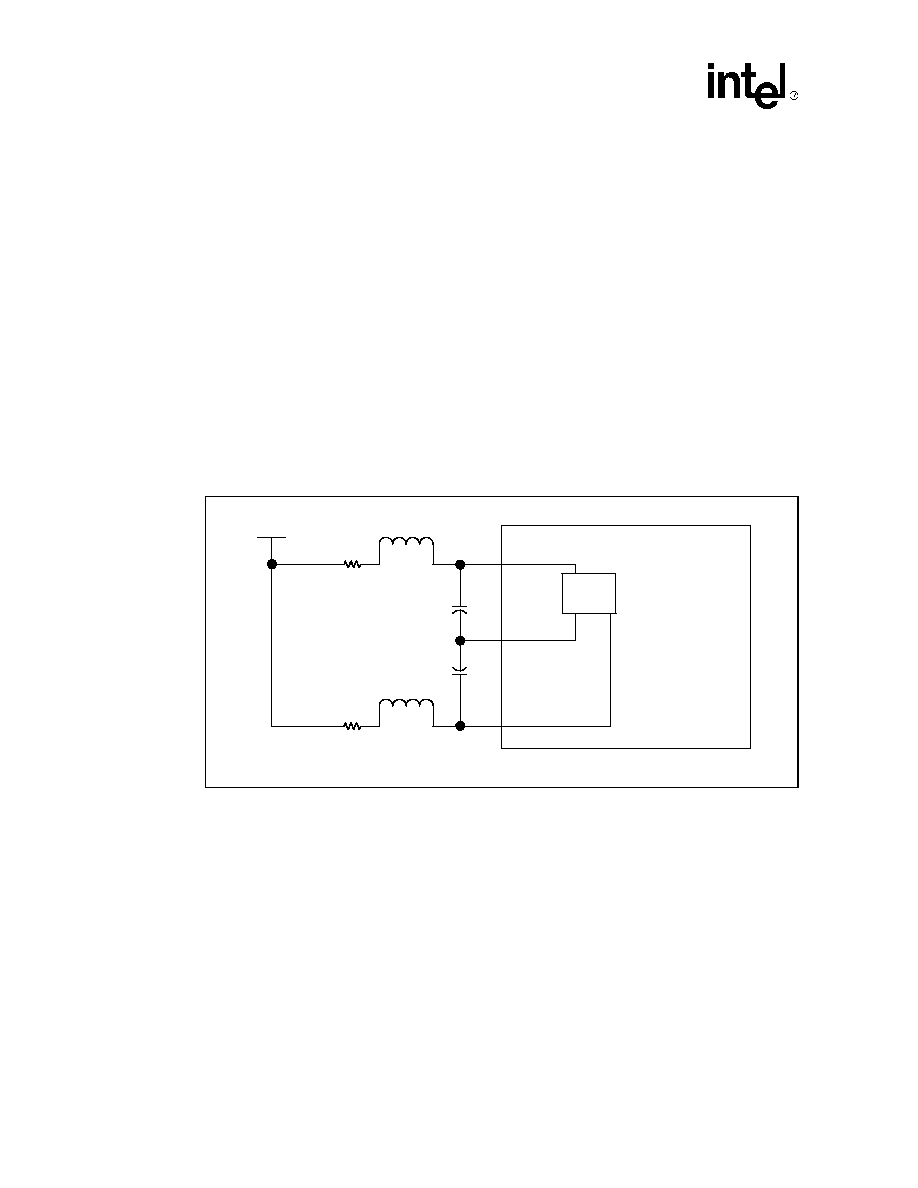
16
Datasheet
Intel
ģ
Celeron
ģ
Processor in the 478-Pin Package
2.3.4
Phase Lock Loop (PLL) Power and Filter
V
CCA
and V
CCIOPLL
are power sources required by the PLL clock generators on the Celeron
processor in the 478-pin package . Since these PLLs are analog in nature, they require quiet power
supplies for minimum jitter. Jitter is detrimental to the system: it degrades external I/O timings as
well as internal core timings (i.e. maximum frequency). To prevent this degradation, these supplies
must be low pass filtered from V
CC
. A typical filter topology is shown in
Figure 1
.
The AC low-pass requirements, with input at V
CC
and output measured across the capacitor
(C
A
or C
IO
in
Figure 1
), is as follows:
∑
< 0.2 dB gain in pass band
∑
< 0.5 dB attenuation in pass band < 1 Hz (see DC drop in next set of requirements)
∑
> 34 dB attenuation from 1 MHz to 66 MHz
∑
> 28 dB attenuation from 66 MHz to core frequency
The filter requirements are illustrated in
Figure 2
. For recommendations on implementing the filter
refer to
Table 1
for the appropriate Platform Design Guide.
Figure 1. Typical V
CCIOPLL
, V
CCA
and V
SSA
Power Distribution
V
CC
R
V
CCA
V
SSA
V
CCIOPLL
R
L
L
Processor
Core
PLL
C
A
C
IO
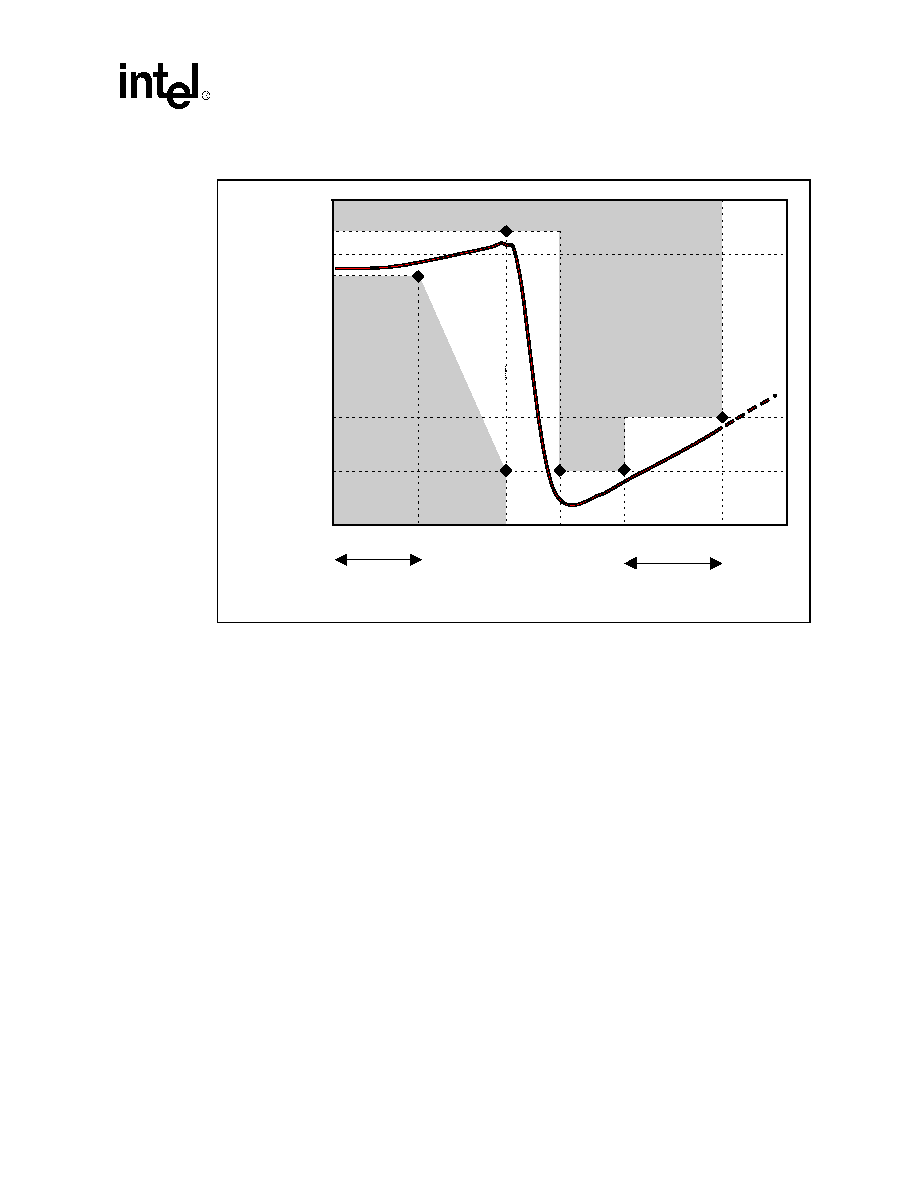
Datasheet
17
Intel
ģ
Celeron
ģ
Processor in the 478-Pin Package
.
NOTES:
1. Diagram not to scale.
2. No specification for frequencies beyond fcore (core frequency).
3. fpeak, if existent, should be less than 0.05 MHz.
Figure 2. Phase Lock Loop (PLL) Filter Requirements
0dB
-28dB
-34dB
0.2dB
0.5 dB
1 MHz
66 MHz
fcore
fpeak
1Hz
DC
passband
high frequency
band
Forbidden
Zone
Forbidden
Zone

18
Datasheet
Intel
ģ
Celeron
ģ
Processor in the 478-Pin Package
2.4
Reserved, Unused, and TESTHI Pins
All RESERVED pins must remain unconnected. Connection of these pins to V
CC
, V
SS
, or to any
other signal (including each other) can result in component malfunction or incompatibility with a
future Celeron
processors in the 478-pin package. See
Chapter 5.0
for a pin listing of the processor
and the location of all RESERVED pins.
For reliable operation, always connect unused inputs or bidirectional signals to an appropriate
signal level. In a system level design, on-die termination has been included on the Celeron
processor in the 478-pin package to allow signals to be terminated within the processor silicon.
Most unused AGTL+ inputs should be left as no connects, as AGTL+ termination is provided on
the processor silicon. However, see
Table 3
for details on AGTL+ signals that do not include on-die
termination. Unused active high inputs should be connected through a resistor to ground (V
SS
).
Unused outputs can be left unconnected, however this may interfere with some TAP functions,
complicate debug probing, and prevent boundary scan testing. A resistor must be used when tying
bidirectional signals to power or ground. When tying any signal to power or ground, a resistor will
also allow for system testability. For unused AGTL+ input or I/O signals, use pull-up resistors of
the same value for the on-die termination resistors (R
TT
). See
Table 12
.
TAP, Asynchronous GTL+ inputs, and Asynchronous GTL+ outputs do not include on-die
termination. Input and used outputs must be terminated on the system board. Unused outputs may
be terminated on the system board or left unconnected. Note that leaving unused output
unterminated may interfere with some TAP functions, complicate debug probing, and prevent
boundary scan testing. Signal termination for these signal types is discussed in the appropriate
Platform Design Guide
,
and the ITP700 Debug Port Design Guide.
The TESTHI pins should be tied to the processor V
CC
using a matched resistor, where a matched
resistor has a resistance value within Ī 20% of the impedance of the board transmission line traces.
For example, If the trace impedance is 50
, then a value between 40
and 60
is required.
The TESTHI pins may use individual pull-up resistors or be grouped together as detailed below. A
matched resistor should be used for each group:
∑
TESTHI[1:0]
∑
TESTHI[5:2]
∑
TESTHI[10:8]
∑
TESTHI[12:11]
Additionally, if the ITPCLKOUT[1:0] pins are not used (see
Table 32
), they may be connected
individually to V
CC
using matched resistors or grouped with TESTHI[5:2] with a single matched
resistor. If they are being used, individual termination with 1 k
resistors is acceptable. Tying
ITPCLKOUT[1:0] directly to V
CC
or sharing a pull-up resistor to V
CC
will prevent use of debug
interposers. This implementation is strongly discouraged for system boards that do not implement
an onboard debug port.
As an alternative, group 2 (TESTHI [5:2]), and the ITPCLKOUT[1:0] pins may be tied directly to
the processor V
CC
. This has no impact on system functionality. TESTHI[0] and TESTHI[12] may
also be tied directly to processor V
CC
if resistor termination is a problem, but matched resistor
termination is recommended. In the case of the ITPCLKOUT[1:0], direct tie to V
CC
is strongly
discouraged for system boards that do not implement an onboard debug port.

Datasheet
19
Intel
ģ
Celeron
ģ
Processor in the 478-Pin Package
2.5
System Bus Signal Groups
To simplify the following discussion, the system bus signals have been combined into groups by
buffer type. AGTL+ input signals have differential input buffers, which use GTLREF as a reference
level. In this document, the term AGTL+ Input refers to the AGTL+ input group as well as the
AGTL+ I/O group when receiving. Similarly, AGTL+ Output refers to the AGTL+ output group as
well as the AGTL+ I/O group when driving.
With the implementation of a source synchronous data bus comes the need to specify two sets of
timing parameters. One set is for common clock signals which are dependent upon the rising edge
of BCLK0 (ADS#, HIT#, HITM#, etc.) and the second set is for the source synchronous signals
which are relative to their respective strobe lines (data and address) as well as the rising edge of
BCLK0. Asychronous signals are still present (A20M#, IGNNE#, etc.) and can become active at
any time during the clock cycle.
Table 3
identifies which signals are common clock, source
synchronous, and asynchronous.
NOTE:
1. Refer to
Chapter 5.0
for signal descriptions.
2. These AGTL+ signals do not have on-die termination and must be terminated on the system board.
3. In processor systems where there is no debug port implemented on the system board, these signals are used
to support a debug port interposer. In systems with the debug port implemented on the system board, these
signals are no connects.
4. These signal groups are not terminated by the processor. Refer to
Section 2.4
and the ITP700 Debug Port
Design Guide, and the appropriate Platform Design Guide as referenced in
Table 1
for termination
requirements and further details.
5. The value of these pins during the active-to-inactive edge of RESET# determine processor configuration
options. See
Section 7.1
for details.
Table 3. System Bus Pin Groups
Signal Group
Type
Signals
1
AGTL+ Common Clock Input
Synchronous
to BCLK[1:0]
BPRI#, DEFER#, RESET#
2
, RS[2:0]#, RSP#, TRDY#
AGTL+ Common Clock I/O
Synchronous
to BCLK[1:0]
AP[1:0]#, ADS#, BINIT#, BNR#, BPM[5:0]#
2
, BR0#
2
,
DBSY#, DP[3:0]#, DRDY#, HIT#, HITM#, LOCK#,
MCERR#
AGTL+ Strobes
Synchronous
to BCLK[1:0]
ADSTB[1:0]#, DSTBP[3:0]#, DSTBN[3:0]#
AGTL+ Source Synchronous I/O
Synchronous
to assoc.
strobe
Signal
Associated Strobe
REQ[4:0]#, A[16:3]#
5
ADSTB0#
A[35:17]#
5
ADSTB1#
D[15:0]#, DBI0#
DSTBP0#, DSTBN0#
D[31:16]#, DBI1#
DSTBP1#, DSTBN1#
D[47:32]#, DBI2#
DSTBP2#, DSTBN2#
D[63:48]#, DBI3#
DSTBP3#, DSTBN3#
Asynchronous GTL+ Input
4, 5
A20M#, IGNNE#, INIT#, LINT0/INTR, LINT1/NMI, SMI#,
SLP#, STPCLK#
Asynchronous GTL+ Output
4
FERR#, IERR#, THERMTRIP#, PROCHOT#
TAP Input
4
Synchronous
to TCK
TCK, TDI, TMS, TRST#
TAP Output
4
Synchronous
to TCK
TDO
System Bus Clock
Clock
BCLK[1:0], ITP_CLK[1:0]
3
Power/Other
V
CC
, V
CCA
, V
CCIOPLL
, VID[4:0], V
SS
, V
SSA
, GTLREF[3:0],
COMP[1:0], RESERVED, TESTHI[12:8], TESTHI[5:0],
THERMDA, THERMDC, VCC_SENSE, VSS_SENSE,
VCCVID, BSEL[1:0], SKTOCC#, DBR#
3
,
ITPCLKOUT[1:0], PWRGOOD
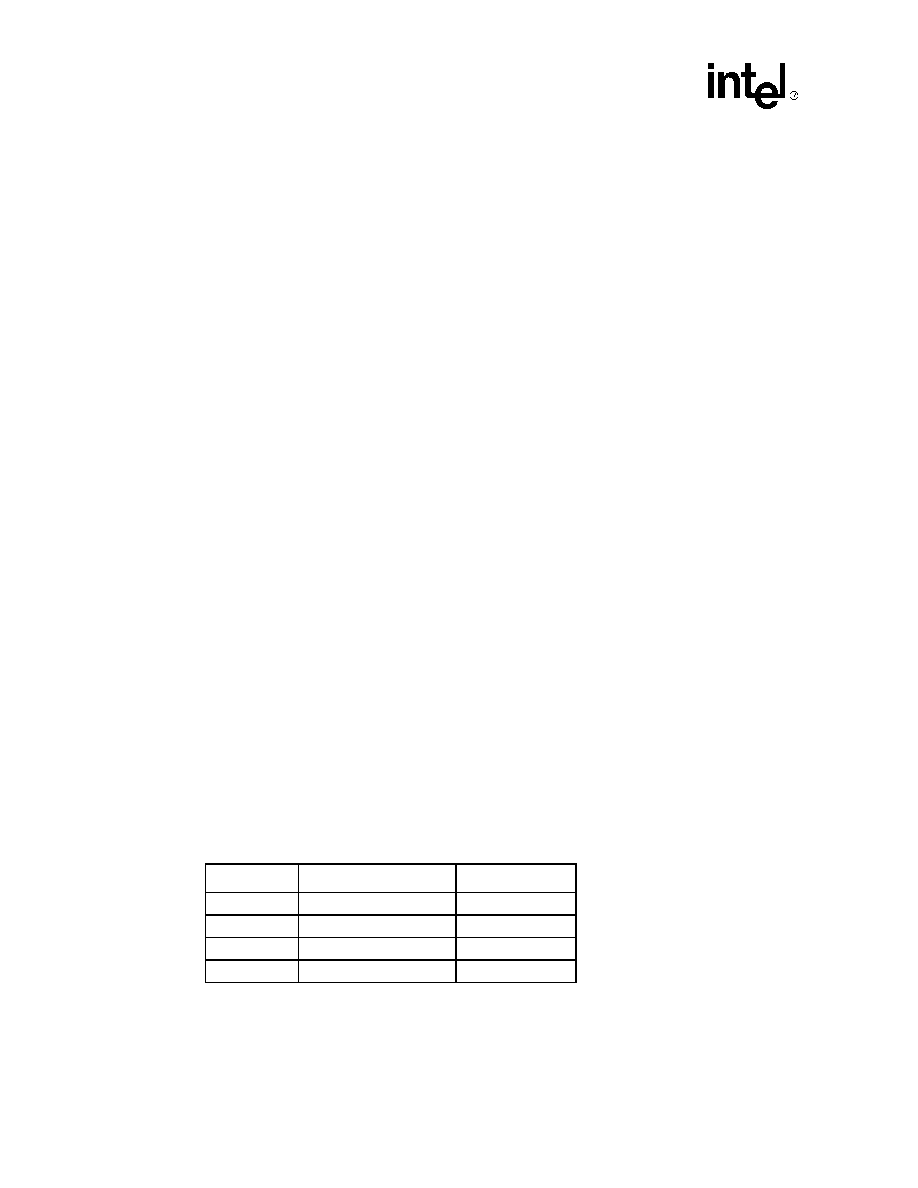
20
Datasheet
Intel
ģ
Celeron
ģ
Processor in the 478-Pin Package
2.6
Asynchronous GTL+ Signals
The Celeron
processor in the 478-pin package does not utilize CMOS voltage levels on any signals
that connect to the processor. As a result, legacy input signals such as A20M#, IGNNE#, INIT#,
LINT0/INTR, LINT1/NMI, SMI#, SLP#, and STPCLK# utilize GTL+ input buffers. Legacy
output FERR# and other non-AGTL+ signals (THERMTRIP# and PROCHOT#) utilize GTL+
output buffers. All of these signals follow the same DC requirements as AGTL+ signals, however
the outputs are not actively driven high (during a logical 0 to 1 transition) by the processor (the
major difference between GTL+ and AGTL+). These signals do not have setup or hold time
specifications in relation to BCLK[1:0]. However, all of the Asynchronous GTL+ signals are
required to be asserted for at least two BCLKs in order for the processor to recognize them. See
Section 2.10
and
Section 2.12
for the DC and AC specifications for the Asynchronous GTL+ signal
groups. See
Section 7.2
for additional timing requirements for entering and leaving the low power
states.
2.7
Test Access Port (TAP) Connection
Due to the voltage levels supported by other components in the Test Access Port (TAP) logic, it is
recommended that the Celeron
processor in the 478-pin package be first in the TAP chain and
followed by any other components within the system. A translation buffer should be used to
connect to the rest of the chain unless one of the other components is capable of accepting an input
of the appropriate voltage level. These considerations must be made for TCK, TMS, TRST#, TDI,
and TDO. Two copies of each signal may be required, with each driving a different voltage level.
2.8
System Bus Frequency Select Signals (BSEL[1:0])
The BSEL[1:0] signals are used to select the frequency of the processor input clock (BCLK[1:0]).
Table 4
defines the possible combinations of the signals and the frequency associated with each
combination. The required frequency is determined by the processor, chipset, and clock
synthesizer. All agents must operate at the same frequency.
The Celeron
processor in the 478-pin package currently operates at a 400 MHz system bus
frequency (selected by a 100 MHz BCLK[1:0] frequency). Individual processors will only operate
at their specified system bus frequency.
For more information about these pins refer to
Chapter 5.0
and the appropriate Platform Design
Guide.
Table 4. BSEL[1:0] Frequency Table for BCLK[1:0]
BSEL1
BSEL0
Function
L
L
100 MHz
L
H
RESERVED
H
L
RESERVED
H
H
RESERVED

Datasheet
21
Intel
ģ
Celeron
ģ
Processor in the 478-Pin Package
2.9
Maximum Ratings
Table 5
lists the processor's maximum environmental stress ratings. Functional operation at the
absolute maximum and minimum is neither implied nor guaranteed. The processor should not
receive a clock while subjected to these conditions. Functional operating parameters are listed in
the AC and DC tables. Extended exposure to the maximum ratings may affect device reliability.
Furthermore, although the processor contains protective circuitry to resist damage from electro
static discharge (ESD), one should always take precautions to avoid high static voltages or electric
fields.
NOTE:
1. This rating applies to any processor pin.
2. Contact Intel for storage requirements in excess of one year.
2.10
Processor DC Specifications
The processor DC specifications in this section are defined at the processor core silicon and
not at the package pins unless noted otherwise. See
Chapter 5.0
for the pin signal definitions and
signal pin assignments. Most of the signals on the processor system bus are in the AGTL+ signal
group. The DC specifications for these signals are listed in
Table 9
.
Previously, legacy signals and Test Access Port (TAP) signals to the processor used low-voltage
CMOS buffer types. However, these interfaces now follow DC specifications similar to GTL+. The
DC specifications for these signal groups are listed in
Table 10
.
Table 6
through
Table 11
list the DC specifications for the Celeron
processor in the 478-pin
package and are valid only while meeting specifications for case temperature, clock frequency, and
input voltages. Care should be taken to read all notes associated with each parameter.
Table 5. Processor DC Absolute Maximum Ratings
Symbol
Parameter
Min
Max Unit
Notes
T
STORAGE
Processor storage temperature
≠40
85
įC
2
V
CC
Any processor supply voltage with respect to V
SS
≠0.5
2.10
V
1
V
inAGTL+
AGTL+ buffer DC input voltage with respect to V
SS
≠0.3
2.10
V
V
inAsynch_GTL+
Asynch GTL+ buffer DC input voltage with respect to
V
SS
≠0.3
2.10
V
I
VID
Max VID pin current
5
mA

22
Datasheet
Intel
ģ
Celeron
ģ
Processor in the 478-Pin Package
2.10.1
Flexible Motherboard Guidelines (FMB)
The FMB guidelines are estimates of the maximum values the Celeron
processor in the 478-pin
package will have over certain time periods. The values are only estimates and actual specifications
for future processors may differ. The Celeron
processor in the 478-pin package may or may not
have specifications equal to the FMB value in the foreseeable future. System designers should meet
the FMB values to ensure their systems will be compatible with future releases of the Celeron
processor in the 478-pin package.
NOTES:
1. Unless otherwise noted, all specifications in this table are based on estimates and simulations or empirical
data. These specifications will be updated with characterized data from silicon measurements at a later date.
2. These voltages are targets only. A variable voltage source should exist on systems in the event that a
different voltage is required. See
Section 2.4
and
Table 2
for more information.
3. The voltage specification requirements are measured across VCC_SENSE and VSS_SENSE pins at the
socket with a 100 MHz bandwidth oscilloscope, 1.5 pF maximum probe capacitance, and 1 M
minimum
impedance. The maximum length of ground wire on the probe should be less than 5 mm. Ensure external
noise from the system is not coupled into the scope probe.
4. Refer to
Table 7
and
Figure 3
for the minimum, typical, and maximum V
CC
allowed for a given current. The
processor should not be subjected to any V
CC
and I
CC
combination wherein V
CC
exceeds V
CC_MAX
for a
given current. Moreover, V
CC
should never exceed the VID voltage. Failure to adhere to this specification can
shorten the processor lifetime.
5. V
CC
_MIN
is defined at I
CC_MAX
.
6. The current specified is also for AutoHALT State.
7. The maximum instantaneous current the processor will draw while the thermal control circuit is active as
indicated by the assertion of PROCHOT# is the same as the maximum I
CC
for the processor.
8. I
CC
Stop-Grant and I
CC
Sleep are specified at V
CC_MAX.
9. These specifications apply to processors with a VID setting of 1.75 V.
Table 6. Voltage and Current Specifications
Symbol
Parameter
Min
Typ
Max
Unit
Notes
1, 9
V
CC
V
CC
for processor at
1.70 GHz
1.565
Refer to
Table 7
and
Figure 3
V
2, 3, 4, 5
I
CC
I
CC
for processor at
1.70 GHz
48.1
A
I
SG
NT
I
SLP
I
CC
Stop-Grant
1.70 GHz
12.9
A
6, 8
I
TCC
I
CC
TCC active
I
CC
A
7
I
CC PLL
I
CC
for PLL pins
30
mA

Datasheet
23
Intel
ģ
Celeron
ģ
Processor in the 478-Pin Package
NOTES:
1. The loadline specifications include both static and transient limits.
2. This table is intended to aid in reading discrete points on
Figure 3
.
3. The loadlines specify voltage limits at the die measured at the VCC_SENSE and VSS_SENSE pins. Voltage
regulation feedback for voltage regulator circuits must be taken from processor V
CC
and V
SS
pins. Refer to
the Intel
ģ
Pentium
ģ
4 Processor VR-Down Design Guidelines for socket loadline guidelines and VR
implementation details.
Table 7. V
CC
Static and Transient Tolerance
Icc (A)
Voltage Deviation from VID Setting (V)
1, 2, 3
Maximum
Typical
Minimum
0
0.000
≠0.025
≠0.050
5
≠0.010
≠0.037
≠0.064
10
≠0.019
≠0.048
≠0.078
15
≠0.029
≠0.060
≠0.092
20
≠0.038
≠0.072
≠0.106
25
≠0.048
≠0.083
≠0.120
30
≠0.057
≠0.095
≠0.133
35
≠0.067
≠0.107
≠0.147
40
≠0.076
≠0.119
≠0.161
45
≠0.085
≠0.130
≠0.175
50
≠0.095
≠0.142
≠0.189
55
≠0.105
≠0.154
≠0.203
60
≠0.114
≠0.165
≠0.217
65
≠0.124
≠0.177
≠0.231
70
≠0.133
≠0.189
≠0.245

24
Datasheet
Intel
ģ
Celeron
ģ
Processor in the 478-Pin Package
NOTES:
1. The loadline specification includes both static and transient limits.
2. This loadline specification applies to processors with a VID setting of 1.75 V.
3. The loadlines specify voltage limits at the die measured at the VCC_SENSE and VSS_SENSE pins. Voltage
regulation feedback for voltage regulator circuits must be taken from processor V
CC
and V
SS
pins. Refer to
the Intel
ģ
Pentium
ģ
4 Processor VR-Down Design Guidelines for socket loadline guidelines and VR
implementation details.
Figure 3. V
CC
Static and Transient Tolerance
1.450
1.500
1.550
1.600
1.650
1.700
1.750
1.800
0
10
20
30
40
50
60
70
80
Icc Load [A]
Vc
c
[V]
Vcc Minimum
Vcc Maximum
Vcc Typical

Datasheet
25
Intel
ģ
Celeron
ģ
Processor in the 478-Pin Package
NOTES:.
1. Unless otherwise noted, all specifications in this table apply to all processor frequencies.
2. Crossing voltage is defined as the instantaneous voltage value when the rising edge of BCLK0 equals the
falling edge of BCLK1.
3. V
Havg
is the statistical average of the V
H
measured by the oscilloscope.
4. Overshoot is defined as the absolute value of the maximum voltage.
5. Undershoot is defined as the absolute value of the minimum voltage.
6. Ringback Margin is defined as the absolute voltage difference between the maximum Rising Edge Ringback
and the maximum Falling Edge Ringback.
7. Threshold Region is defined as a region entered around the crossing point voltage in which the differential
receiver switches. It includes input threshold hysteresis.
8. The crossing point must meet the absolute and relative crossing point specifications simultaneously.
9. V
Havg
can be measured directly using Vtop on Agilent* scopes and High on Tektronix* scopes.
10.
V
CROSS
is defined as the total variation of all crossing voltages as defined in note 2.
NOTES:
1. Unless otherwise noted, all specifications in this table apply to all processor frequencies.
2.
VIL
is defined as the voltage range at a receiving agent that will be interpreted as a logical low value.
3. V
IH
is defined as the voltage range at a receiving agent that will be interpreted as a logical high value.
4. V
IH
and V
OH
may experience excursions above V
CC
. However, input signal drivers must comply with the
signal quality specifications in
Chapter 3.0
.
5. Refer to processor I/O Buffer Models for I/V characteristics.
6. The V
CC
referred to in these specifications is the instantaneous V
CC
.
7. V
OL_MAX
of 0.560 V is guaranteed when driving into a test load of 50 ohms as indicated in
Figure 4
, with R
TT
enabled.
Table 8. System Bus Differential BCLK Specifications
Symbol
Parameter
Min
Typ
Max
Unit
Figure
Notes
1
V
L
Input Low Voltage ≠.150
0.000
N/A
V
6
V
H
Input High
Voltage
0.660
0.710
0.850
V
6
V
CROSS(abs)
Absolute
Crossing Point
0.250
N/A
0.550
V
6
,
7
2, 3, 8
V
CROSS(rel)
Relative Crossing
Point
0.250 +
0.5(V
Havg
- 0.71)
N/A
0.550 +
0.5(V
Havg
- 0.71)
V
6
,
7
2, 3, 8, 9
V
CROSS
Range of
Crossing Points
N/A
N/A
0.140
V
6
,
7
2, 10
V
OV
Overshoot
N/A
N/A
V
H
+ 0.3
V
6
4
V
US
Undershoot
≠ 0.3
N/A
N/A
V
6
5
V
RBM
Ringback Margin
0.200
N/A
N/A
V
6
6
V
TM
Threshold Margin
V
CROSS
- 0.100
N/A
V
CROSS
+ 0.100
V
6
7
Table 9. AGTL+ Signal Group DC Specifications
Symbol
Parameter
Min
Max
Unit
Notes
1
V
IL
Input Low Voltage
0.0
GTLREF - 0.100
V
2, 6
V
IH
Input High Voltage
GTLREF + 0.100
V
CC
V
3, 4, 6
V
OH
Output High Voltage
N/A
V
CC
V
4, 6
I
OL
Output Low Current
N/A
64
mA
7
I
LI
Input Leakage Current
N/A
Ī 100
ĶA
I
LO
Output Leakage Current
N/A
Ī 100
ĶA
R
ON
Buffer On Resistance
5
11
W
5

26
Datasheet
Intel
ģ
Celeron
ģ
Processor in the 478-Pin Package
NOTES:
1. Unless otherwise noted, all specifications in this table apply to all processor frequencies.
2. All outputs are open drain.
3. V
IL
is defined as the voltage range at a receiving agent that will be interpreted as a logical low value.
4. V
IH
is defined as the voltage range at a receiving agent that will be interpreted as a logical high value.
5. V
IH
and V
OH
may experience excursions above V
CC
. However, input signal drivers must comply with the
signal quality specifications in
Chapter 3.0
.
6. Refer to the processor I/O Buffer Models for I/V characteristics.
7. The V
CC
referred to in these specifications refers to instantaneous V
CC
.
8. The maximum output current is based on maximum current handling capability of the buffer and is not
specified into the test load.
9. V
OL_MAX
of 0.560 V is guaranteed when driving into a test load of 50 ohms as indicated in
Figure 4
, with R
TT
enabled.
NOTES:
1. Unless otherwise noted, all specifications in this table apply to all processor frequencies and cache sizes.
2. All outputs are open drain
3. The TAP signal group must meet the signal quality specifications in
Chapter 3.0
.
4. Refer to the processor I/O Buffer Models for I/V characteristics.
5. The V
CC
referred to in these specifications refers to instantaneous V
CC
.
6. The maximum output current is based on maximum current handling capability of the buffer and is not
specified into the test load.
7. V
OL_MAX
of 0.360 V is guaranteed when driving into a test load as indicated in
Figure 4
.
8. V
HYS
represents the amount of hysteresis, nominally centered about 1/2 V
CC
, for all TAP inputs.
Table 10. Asynchronous GTL+ Signal Group DC Specifications
Symbol
Parameter
Min
Max
Unit Notes
1
VIL
Input Low Voltage
0.0
GTLREF-0.100
3
V
IH
Input High Voltage
GTLREF+0.100
V
CC
4, 5, 7
V
OH
Output High Voltage
V
CC
V
2, 5, 7
I
OL
Output Low Current
64
mA
8, 9
I
LI
Input Leakage Current
N/A
Ī 100
ĶA
I
LO
Output Leakage Current
N/A
Ī 100
ĶA
R
ON
Buffer On Resistance
5
11
W
6
Table 11. PWRGOOD and TAP Signal Group DC Specifications
Symbol
Parameter
Min
Max
Unit
Notes
1, 2
V
HYS
Input Hysteresis
200
300
mV
8
V
T+
Input low to high
threshold voltage
1/2 * (V
CC
+ V
HYS_MIN
)
1/2 * (V
CC
+ V
HYS_MAX
)
V
5
V
T-
Input high to low
threshold voltage
1/2 * (V
CC
- V
HYS_MAX
)
1/2 * (V
CC
- V
HYS_MIN
)
V
5
V
OH
Output High Voltage
N/A
V
CC
V
3, 5
I
OL
Output Low Current
45
mA
6, 7
I
LI
Input Leakage Current
Ī 100
ĶA
I
LO
Output Leakage Current
Ī 100
ĶA
R
ON
Buffer On Resistance
6.25
13.25
W
4

Datasheet
27
Intel
ģ
Celeron
ģ
Processor in the 478-Pin Package
2.11
AGTL+ System Bus Specifications
Routing topology recommendations may be found in the appropriate Platform Design Guide as
referenced in
Table 1
. Termination resistors are not required for most AGTL+ signals, as these are
integrated into the processor silicon.
Valid high and low levels are determined by the input buffers which compare a signal's voltage
with a reference voltage called GTLREF (known as V
REF
in previous documentation).
Table 12
lists the GTLREF specifications. The AGTL+ reference voltage (GTLREF) should be
generated on the system board using high precision voltage divider circuits. It is important that the
system board impedance is held to the specified tolerance, and that the intrinsic trace capacitance
for the AGTL+ signal group traces is known and well-controlled. For more details on platform
design see the Platform Design Guide.
NOTES:
1. Unless otherwise noted, all specifications in this table apply to all processor frequencies.
2. The tolerances for this specification have been stated generically to enable the system designer to calculate
the minimum and maximum values across the range of V
CC
.
3. GTLREF should be generated from V
CC
by a voltage divider of 1% resistors or 1% matched resistors. Refer
to
Table 1
for the appropriate Platform Design Guide for implementation details.
4. R
TT
is the on-die termination resistance measured at V
OL
of the AGTL+ output driver. Refer to processor I/O
buffer models for I/V characteristics.
5. COMP resistance must be provided on the system board with 1% resistors. See the appropriate platform
design guide for implementation details.
6. The V
CC
referred to in these specifications is the instantaneous V
CC
.
Table 12. AGTL+ Bus Voltage Definitions
Symbol
Parameter
Min
Typ
Max
Units
Notes
1
GTLREF
Bus Reference
Voltage
2/3 V
CC
- 2%
2/3 V
CC
2/3 V
CC
+ 2%
V
2, 3, 6
R
TT
Termination
Resistance
45
50
55
W
4
COMP[1:0]
COMP
Resistance
50.49
51
51.51
W
5

28
Datasheet
Intel
ģ
Celeron
ģ
Processor in the 478-Pin Package
2.12
System Bus AC Specifications
The processor system bus timings specified in this section are defined at the processor core
silicon and are thus not measurable at the processor pins. See
Chapter 5.0
for the Celeron
processor in the 478-pin package pin signal definitions.
Table 14
through
Table 18
list the AC specifications associated with the processor system bus.
All AGTL+ timings are referenced to GTLREF for both `0' and `1' logic levels unless otherwise
specified.
The timings specified in this section should be used in conjunction with the I/O buffer models
provided by Intel. These I/O buffer models, which include package information, are available for
the Celeron
processor in the 478-pin package in IBIS format. AGTL+ layout guidelines are also
available in the appropriate Platform Design Guide.
Care should be taken to read all notes associated with a particular timing parameter.
NOTES:
1. Unless otherwise noted, all specifications in this table apply to all processor core frequencies.
2. The period specified here is the average period. A given period may vary from this specification as governed
by the period stability specification (T2).
3. For the clock jitter specification, refer to the CK408 Clock Design Guidelines.
4. In this context, period stability is defined as the worst case timing difference between successive crossover
voltages. In other words, the largest absolute difference between adjacent clock periods must be less than
the period stability.
5. Slew rate is measured between the 35% and 65% points of the clock swing (V
L
to V
H
).
Table 13. System Bus Differential Clock Specifications
T# Parameter
Min
Nom
Max
Unit
Figure
Notes
1
System Bus Frequency
100
MHz
T1: BCLK[1:0] Period
10.0
10.2
ns
6
2
T2: BCLK[1:0] Period Stability
200
ps
6
3, 4
T3: BCLK[1:0] High Time
3.94
5
6.12
ns
6
T4: BCLK[1:0] Low Time
3.94
5
6.12
ns
6
T5: BCLK[1:0] Rise Time
175
700
ps
6
5
T6: BCLK[1:0] Fall Time
175
700
ps
6
5

Datasheet
29
Intel
ģ
Celeron
ģ
Processor in the 478-Pin Package
.
NOTES:
1. Unless otherwise noted, all specifications in this table apply to all processor frequencies.
2. Not 100% tested. Specified by design characterization.
3. All common clock AC timings for AGTL+ signals are referenced to the Crossing Voltage (V
CROSS
) of the
BCLK[1:0] at rising edge of BCLK0. All common clock AGTL+ signal timings are referenced at GTLREF at the
processor core.
4. Valid delay timings for these signals are specified into the test circuit described in
Figure 4
and with GTLREF
at 2/3 V
CC
Ī 2%.
5. Specification is for a minimum swing defined between AGTL+ V
IL_MAX
to V
IH_MIN
. This assumes an edge rate
of 0.4 V/ ns to 4.0 V/ns.
6. RESET# can be asserted asynchronously, but must be deasserted synchronously.
7. This should be measured after V
CC
and BCLK[1:0] become stable.
8. Maximum specification applies only while PWRGOOD is asserted.
.
Table 14. System Bus Common Clock AC Specifications
T# Parameter
Min
Max
Unit
Figure
Notes
1,2,3
T10: Common Clock Output Valid Delay
0.200
1.45
ns
8
4
T11: Common Clock Input Setup Time
0.65
N/A
ns
8
5
T12: Common Clock Input Hold Time
0.40
N/A
ns
8
5
T13: RESET# Pulse Width
1.00
10.00
ms
9
6, 7, 8

30
Datasheet
Intel
ģ
Celeron
ģ
Processor in the 478-Pin Package
NOTES:
1. Unless otherwise noted, all specifications in this table apply to all processor frequencies and cache sizes.
2. Not 100% tested. Specified by design characterization.
3. All source synchronous AC timings are referenced to their associated strobe at GTLREF. Source
synchronous data signals are referenced to the falling edge of their associated data strobe. Source
synchronous address signals are referenced to the rising and falling edge of their associated address strobe.
All source synchronous AGTL+ signal timings are referenced at GTLREF at the processor core.
4. Unless otherwise noted these specifications apply to both data and address timings.
5. Valid delay timings for these signals are specified into the test circuit described in
Figure 4
and with GTLREF
at 2/3 V
CC
Ī 2%.
6. Specification is for a minimum swing defined between AGTL+ V
IL_MAX
to V
IH_MIN
. This assumes an edge rate
of 0.3 V/ns to 4.0 V/ns.
7. All source synchronous signals must meet the specified setup time to BCLK as well as the setup time to each
respective strobe.
8. This specification represents the minimum time the data or address will be valid before its strobe. Refer to
Table 1
for the appropriate Platform Design Guide for more information on the definitions and use of these
specifications.
9. This specification represents the minimum time the data or address will be valid after its strobe. Refer to
Table 1
for the appropriate Platform Design Guide for more information on the definitions and use of these
specifications.
10.The rising edge of ADSTB# must come approximately 1/2 BCLK period (5 ns) after the falling edge of
ADSTB#.
11.For this timing parameter, n = 1, 2, and 3 for the second, third, and last data strobes respectively.
12.The second data strobe (falling edge of DSTBn#) must come approximately 1/4 BCLK period (2.5 ns) after
the first falling edge of DSTBp#. The third data strobe (falling edge of DSTBp#) must come approximately
2/4 BCLK period (5 ns) after the first falling edge of DSTBp#. The last data strobe (falling edge of DSTBn#)
must come approximately 3/4 BCLK period (7.5 ns) after the first falling edge of DSTBp#.
13.This specification applies only to DSTBN[3:0]# and is measured to the second falling edge of the strobe.
Table 15. System Bus Source Synch AC Specifications AGTL+ Signal Group
T# Parameter
Min
Typ
Max
Unit
Figure
Notes
1,2,3,4
T20: Source Synchronous Data Output
Valid Delay (first data/address
only)
0.20
1.20
ns
10
,
11
5
T21: T
VBD
: Source Synchronous Data
Output Valid Before Strobe
0.85
ns
11
5, 8
T22: T
VAD
: Source Synchronous Data
Output Valid After Strobe
0.85
ns
11
5, 8
T23: T
VBA
: Source Synchronous
Address Output Valid Before
Strobe
1.88
ns
10
5, 8
T24: T
VAA
: Source Synchronous
Address Output Valid After Strobe
1.88
ns
10
5, 9
T25: T
SUSS
: Source Synchronous Input
Setup Time to Strobe
0.21
ns
10
,
11
6
T26: T
HSS
: Source Synchronous Input
Hold Time to Strobe
0.21
ns
10
,
11
6
T27: T
SUCC
: Source Synchronous Input
Setup Time to BCLK[1:0]
0.65
ns
10
,
11
7
T28: T
FASS
: First Address Strobe to
Second Address Strobe
1/2
BCLK
10
10
T29: T
FDSS
: First Data Strobe to
Subsequent Strobes
n/4
BCLK
11
11, 12
T30: Data Strobe `n' (DSTBN#) Output
Valid Delay
8.80
10.20
ns
11
13
T31: Address Strobe Output Valid
Delay
2.27
4.23
ns
10

Datasheet
31
Intel
ģ
Celeron
ģ
Processor in the 478-Pin Package
NOTES:
1. Unless otherwise noted, all specifications in this table apply to all processor frequencies.
2. All AC timings for the Asynch GTL+ signals are referenced to the BCLK0 rising edge at Crossing Voltage. All
Asynch GTL+ signal timings are referenced at GTLREF. PWRGOOD is referenced to the BCLK0 rising edge
at 0.5 * VCC.
3. These signals may be driven asynchronously.
4. Refer to the PWRGOOD definition for more details regarding the behavior of this signal.
5. Length of assertion for PROCHOT# does not equal internal clock modulation time. Time is allocated after the
assertion and before the deassertion of PROCHOT# for the processor to complete current instruction
execution.
6. See section
Section 7.2
for additional timing requirements for entering and leaving the low power states.
NOTES:
1. Before the deassertion of RESET#.
2. After clock that deasserts RESET#.
Table 16. Miscellaneous Signals AC Specifications
T# Parameter
Min
Max
Unit
Figure
Notes
1,2,3,6
T35: Asynch GTL+ Input Pulse Width
2
BCLKs
T36: PWRGOOD to RESET# de-assertion time
1
10
ms
12
T37: PWRGOOD Inactive Pulse Width
10
BCLKs
12
4
T38: PROCHOT# pulse width
500
us
14
5
T39: THERMTRIP# Assertion until V
CC
removal
0.5
s
13
Table 17. System Bus AC Specifications (Reset Conditions)
T# Parameter
Min
Max
Unit
Figure
Notes
T45: Reset Configuration Signals (A[31:3]#,
BR0#, INIT#, SMI#) Setup Time
4
BCLKs
9
1
T46: Reset Configuration Signals (A[31:3]#,
BR0#, INIT#, SMI#) Hold Time
2
20
BCLKs
9
2

32
Datasheet
Intel
ģ
Celeron
ģ
Processor in the 478-Pin Package
NOTES:
1. Unless otherwise noted, all specifications in this table apply to all processor frequencies.
2. Not 100% tested. Specified by design characterization.
3. All AC timings for the TAP signals are referenced to the TCK signal at 0.5 V
CC
at the processor pins. All TAP
signal timings (TMS, TDI, etc) are referenced at 0.5 * V
CC
at the processor pins.
4. Rise and fall times are measured from the 20% to 80% points of the signal swing.
5. Referenced to the rising edge of TCK.
6. Referenced to the falling edge of TCK.
7. Specification for a minimum swing defined between TAP 20%
to 80% points on the waveform. This assumes
a minimum edge rate of 0.5 V/ns.
8. TRST# must be held asserted for 2 TCK periods to be guarantee that it is recognized by the processor.
9. It is recommended that TMS be asserted while TRST# is being deasserted.
2.13
Processor AC Timing Waveforms
The following figures are used in conjunction with the AC timing tables,
Table 14
through
Table 18
.
Note: For
Figure 5
through
Figure 14
, the following apply:
∑
All common clock AC timings for AGTL+ signals are referenced to the Crossing Voltage
(V
CROSS
) of the BCLK[1:0] at rising edge of BCLK0. All common clock AGTL+ signal
timings are referenced at GTLREF at the processor core.
∑
All source synchronous AC timings for AGTL+ signals are referenced to their associated
strobe (address or data) at GTLREF. Source synchronous data signals are referenced to the
falling edge of their associated data strobe. Source synchronous address signals are referenced
to the rising and falling edge of their associated address strobe. All source synchronous
AGTL+ signal timings are referenced at GTLREF at the processor silicon.
∑
All AC timings for AGTL+ strobe signals are referenced to BCLK[1:0] at V
CROSS
. All
AGTL+ strobe signal timings are referenced at GTLREF at the processor silicon.
∑
All AC timings for the TAP signals are referenced to the TCK signal at 0.5 * V
CC
at the
processor pins. All TAP signal timings (TMS, TDI, etc) are referenced at 0.5 * V
CC
at the
processor pins.
Table 18. TAP Signals AC Specifications
Parameter
Min
Max
Unit
Figure
Notes
1,2,3,9
T55: TCK Period
60.0
ns
5
T56: TCK Rise Time
9.5
ns
5
4
T57: TCK Fall Time
9.5
ns
5
4
T58: TMS, TDI Rise Time
8.5
ns
5
4
T59: TMS, TDI Fall Time
8.5
ns
5
4
T61: TDI, TMS Setup Time
0
ns
15
5, 7
T62: TDI, TMS Hold Time
3
ns
15
5, 7
T63: TDO Clock to Output Delay
0.5
3.5
ns
15
6
T64: TRST# Assert Time
2
TCK
14
8
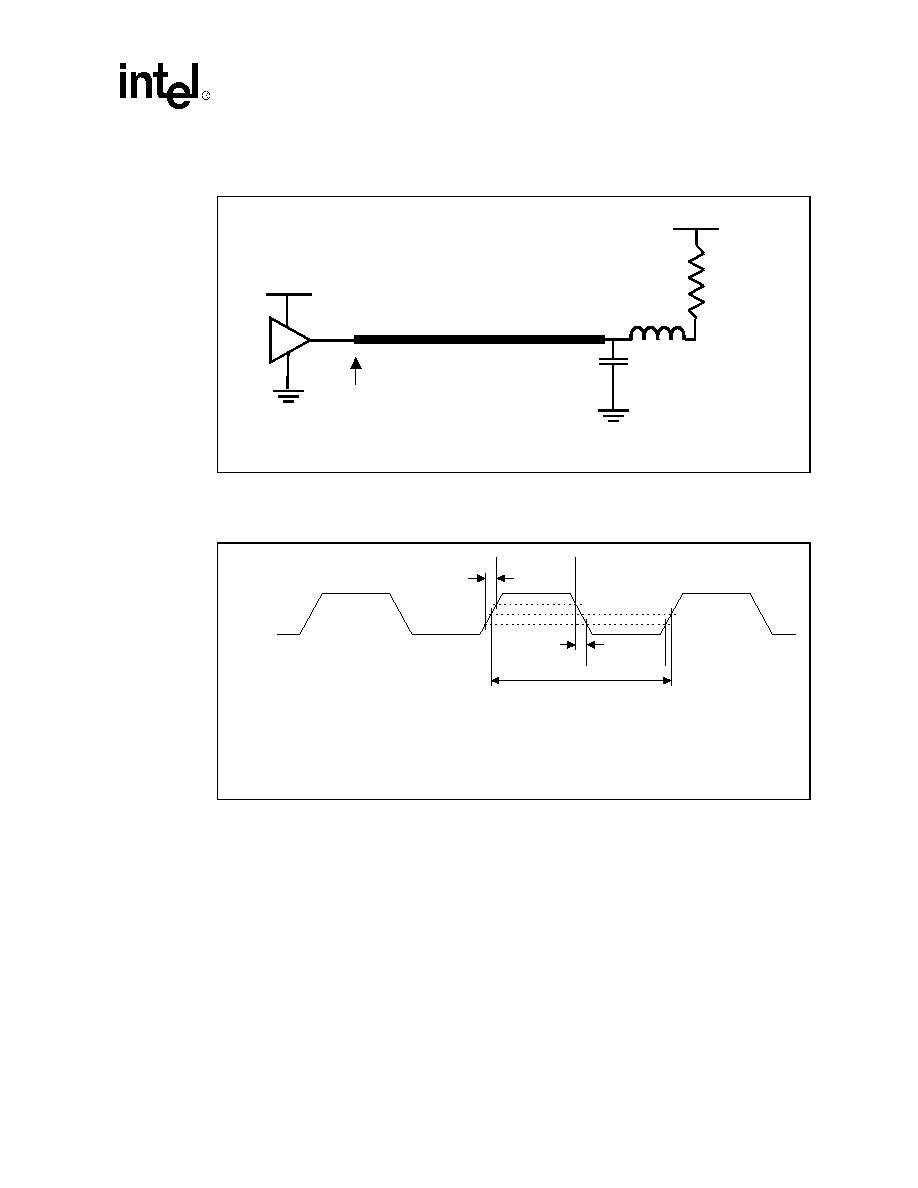
Datasheet
33
Intel
ģ
Celeron
ģ
Processor in the 478-Pin Package
The circuit used to test the AC specifications is shown in
Figure 4
.
Figure 4. AC Test Circuit
600 mils, 42 ohms, 169 ps/in
2.4nH
1.2pF
V
CC
V
CC
Rload
Rload = 50 ohms
AC Timings test measurements made here.
Figure 5. TCK Clock Waveform
*V2
*V3
*V1
Tr
Tp
Tf
CLK
Tr = T56, T58 (Rise Time)
Tf = T57, T59 (Fall Time)
Tp = T55 (Period)
V3: TCK is referenced to 0.5 * Vcc.
V1, V2: For rise and fall times, TCK is measured between 20% to 80% points on the waveform.

34
Datasheet
Intel
ģ
Celeron
ģ
Processor in the 478-Pin Package
.
Figure 6. Differential Clock Waveform
Crossing
Voltage
Threshold
Region
VH
VL
Overshoot
Undershoot
Ringback
Margin
Rising Edge
Ringback
Falling Edge
Ringback,
BCLK0
BCLK1
Crossing
Voltage
Tph
Tpl
Tp
Tp = T1 (BCLK[1:0] period)
T2 = BCLK[1:0] Period stability (not shown)
Tph =T3 (BCLK[1:0] pulse high time)
Tpl = T4 (BCLK[1:0] pulse low time)
T5 = BCLK[1:0] rise time through the threshold region
T6 = BCLK[1:0] fall time through the threshold region
Figure 7. Differential Clock Crosspoint Specification
p
p
200
250
300
350
400
450
500
550
600
650
660 670 680 690 700 710 720 730 740 750 760 770 780 790 800 810 820 830 840 850
VHavg (V)
C
r
os
s
i
ng P
o
i
n
t
(
V
)
250 + 0.5 (VHavg - 710)
550 + 0.5 (VHavg - 710)
550 mV
250 mV
Vhavg (mV)
C
r
os
s
i
n
g
Po
int
(
m
V)
p
p
200
250
300
350
400
450
500
550
600
650
660 670 680 690 700 710 720 730 740 750 760 770 780 790 800 810 820 830 840 850
VHavg (V)
C
r
os
s
i
ng P
o
i
n
t
(
V
)
250 + 0.5 (VHavg - 710)
550 + 0.5 (VHavg - 710)
550 mV
250 mV
p
p
200
250
300
350
400
450
500
550
600
650
660 670 680 690 700 710 720 730 740 750 760 770 780 790 800 810 820 830 840 850
VHavg (V)
C
r
os
s
i
ng P
o
i
n
t
(
V
)
250 + 0.5 (VHavg - 710)
550 + 0.5 (VHavg - 710)
550 mV
250 mV
Vhavg (mV)
C
r
os
s
i
n
g
Po
int
(
m
V)
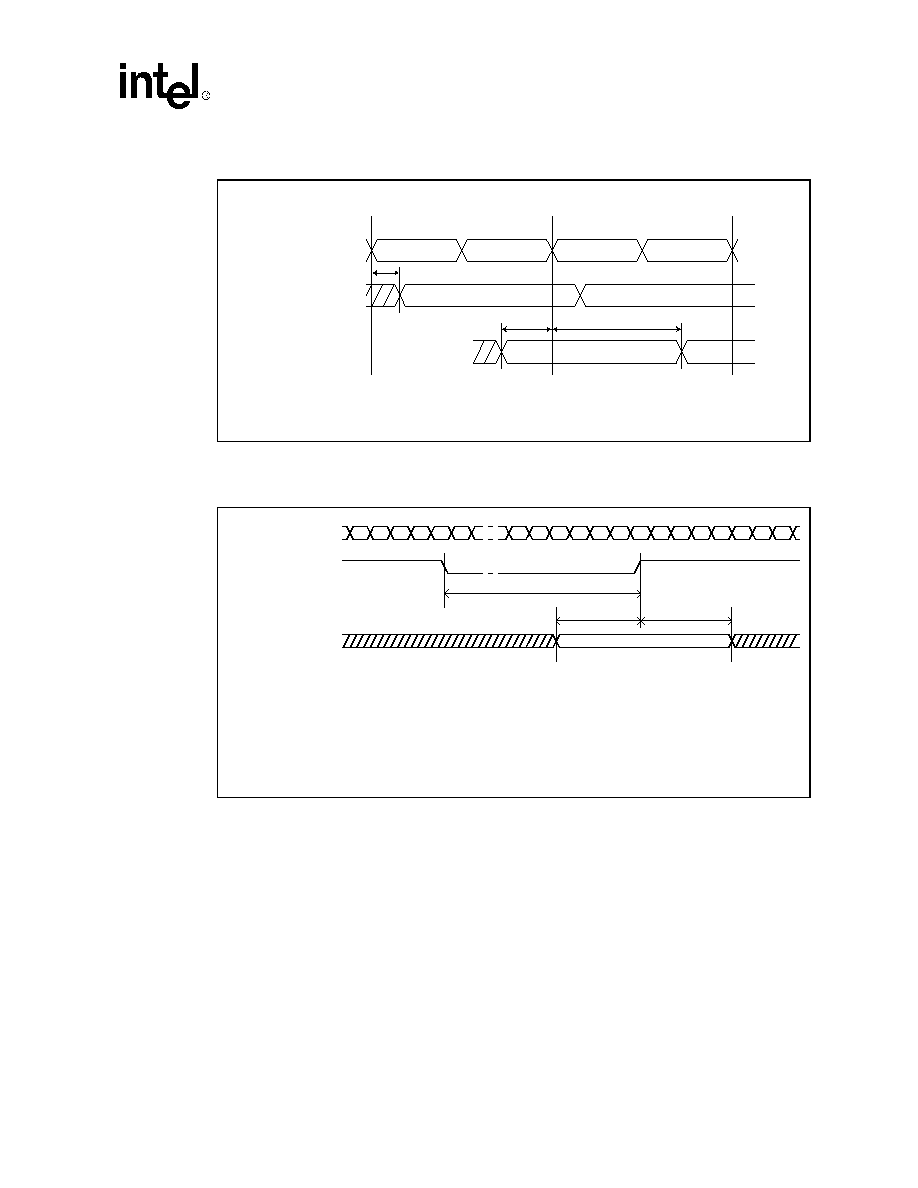
Datasheet
35
Intel
ģ
Celeron
ģ
Processor in the 478-Pin Package
Figure 8. System Bus Common Clock Valid Delay Timings
BCLK0
BCLK1
Common Clock
Signal (@ driver)
Common Clock
Signal (@ receiver)
T0
T1
T2
T
Q
T
R
valid
valid
valid
T
P
T
P
= T10: T
CO
(Data Valid Output Delay)
T
Q
= T11: T
SU
(Common Clock Setup)
T
R
= T12: T
H
(Common Clock Hold Time)
Figure 9. System Bus Reset and Configuration Timings
BCLK
RESET#
Configuration
(A[31:3], BR0#,
INIT#, SMI#)
Tv
Tw
Tx
Tv = T13 (RESET# Pulse Width)
Tw = T45 (Reset Configuration Signals Setup Time)
Tx = T46 (Reset Configuration Signals Hold Time)

36
Datasheet
Intel
ģ
Celeron
ģ
Processor in the 478-Pin Package
Figure 10. Source Synchronous 2X (Address) Timings
T
J
BCLK0
BCLK1
ADSTB# (@ driver)
A# (@ driver)
A# (@ receiver)
ADSTB# (@ receiver)
T1
T2
2.5 ns
5.0 ns
7.5 ns
T
H
T
H
T
J
T
N
T
K
T
M
valid
valid
valid
valid
T
H
= T23: Source Sync. Address Output Valid Before Address Strobe
T
J
= T24: Source Sync. Address Output Valid After Address Strobe
T
K
= T27: Source Sync. Input Setup to BCLK
T
M
= T26: Source Sync. Input Hold Time
T
N
= T25: Source Sync. Input Setup Time
T
P
= T28: First Address Strobe to Second Address Strobe
T
S
= T20: Source Sync. Output Valid Delay
T
R
= T31: Address Strobe Output Valid Delay
T
P
T
R
T
S
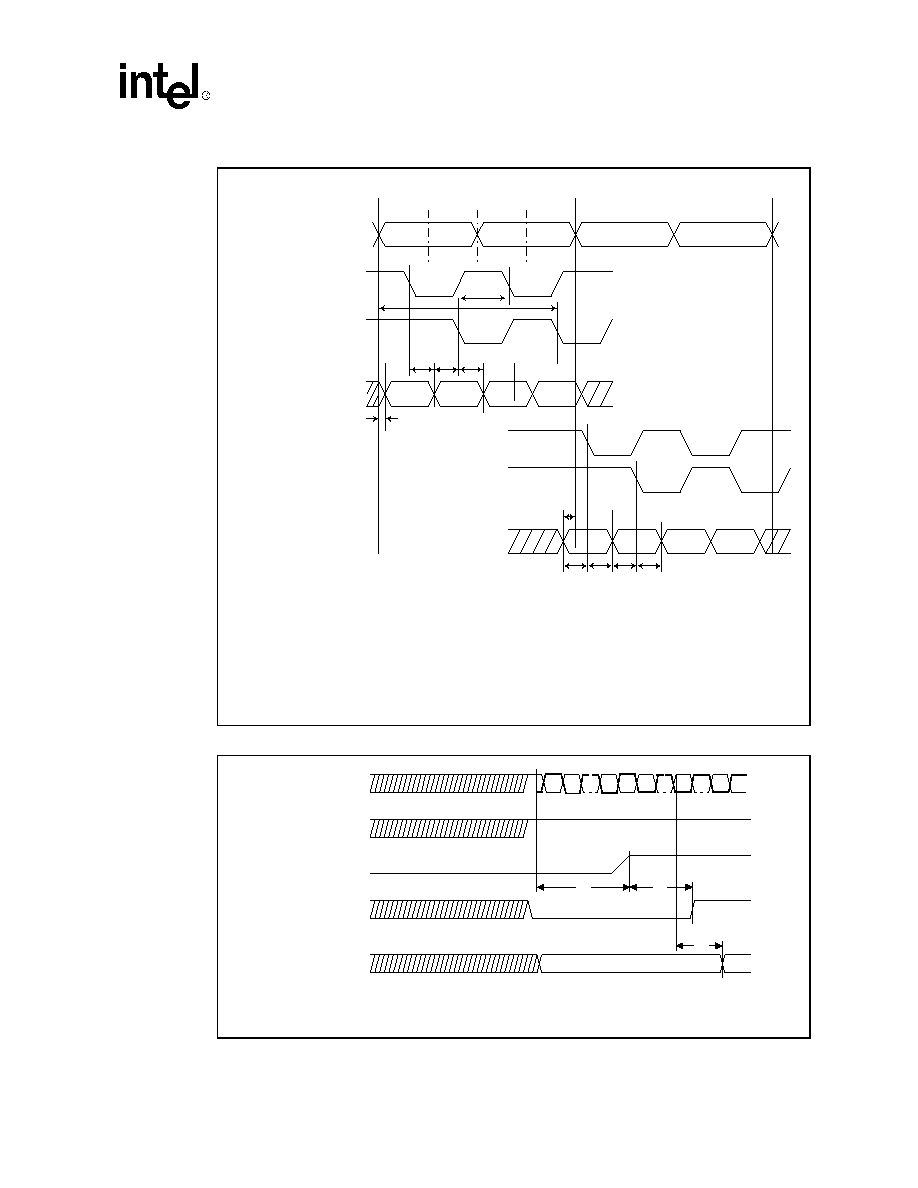
Datasheet
37
Intel
ģ
Celeron
ģ
Processor in the 478-Pin Package
Figure 11. Source Synchronous 4X Timings
Figure 12. Power-On Reset and Configuration Timings
BCLK0
BCLK1
DSTBp# (@ driver)
DSTBn# (@ driver)
D# (@ driver)
D# (@ receiver)
DSTBn# (@ receiver)
DSTBp# (@ receiver)
T0
T1
T2
2.5 ns
5.0 ns
7.5 ns
T
A
T
A
T
B
T
C
T
E
T
E
T
G
T
G
T
D
T
A
= T21: Source Sync. Data Output Valid Delay Before Data Strobe
T
B
= T22: Source Sync. Data Output Valid Delay After Data Strobe
T
C
= T27: Source Sync. Setup Time to BCLK
T
D
= T30: Source Sync. Data Strobe 'N' (DSTBN#) Output Valid Delay
T
E
= T25: Source Sync. Input Setup Time
T
G
= T26: Source Sync. Input Hold Time
T
H
= T29: First Data Strobe to Subsequent Strobes
T
J
= T20: Source Sync. Data Output Valid Delay
T
J
T
H
Valid Ratio
T
a
BCLK
V
CC
, core,
V
REF
Configuration
(A20M#, IGNNE#,
LINT[1:0])
T
a
= T15 (PWRGOOD Inactive Pulse Width)
T
b
= T10 (RESET# Pulse Width)
T
c
= T20 (Reset Configuration Signals (A20M#, IGNNE#, LINT[1:0]) Hold Time)
T
b
T
c
PWRGOOD
RESET#
Vcc
Ta = T37 (PWRGOOD Inactive Pulse Width)
Tb = T36 (PWRGOOD to RESET# de-assertion time)
Tc = T46, (Reset Configuration Signals Hold Time)
Configuration
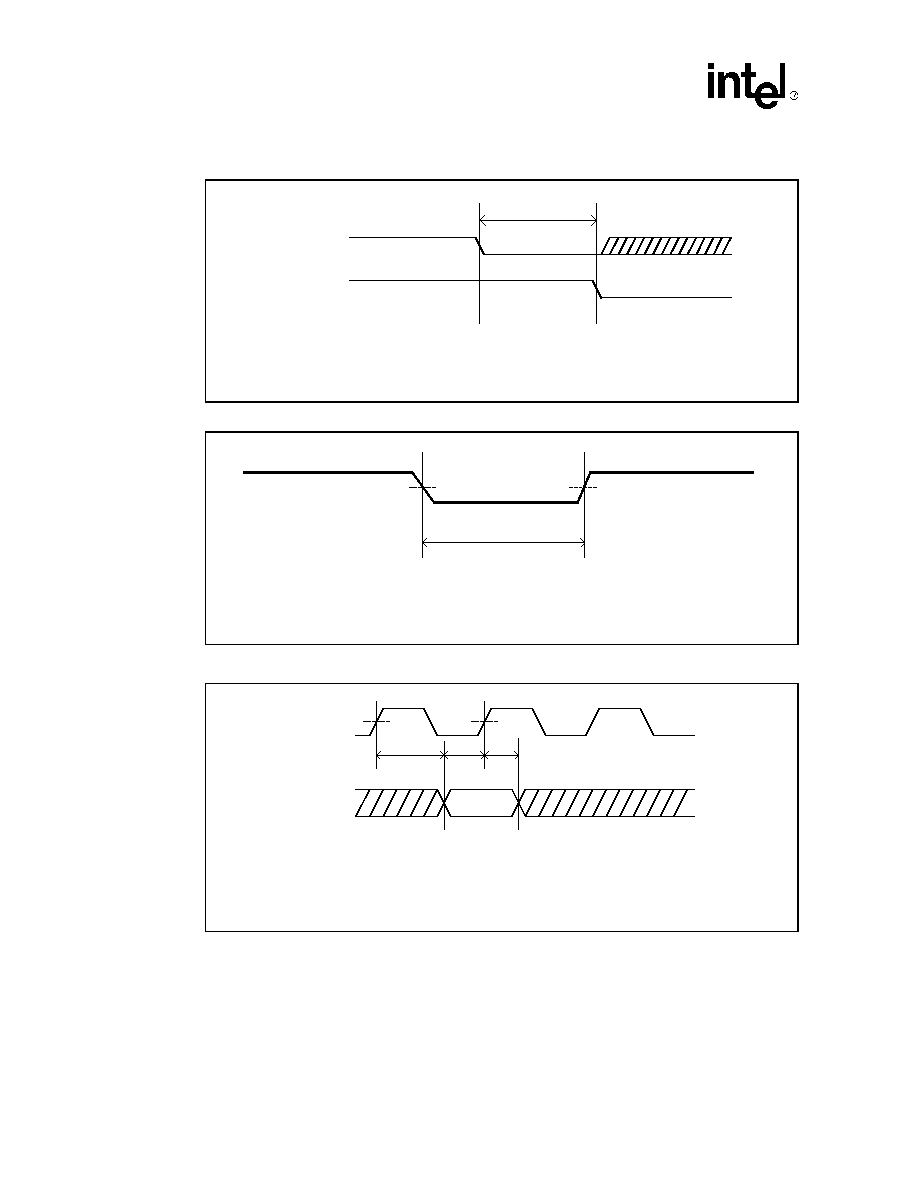
38
Datasheet
Intel
ģ
Celeron
ģ
Processor in the 478-Pin Package
Figure 13. THERMTRIP# Power Down Sequenc e
Figure 14. Test Reset (TRST#), Async GTL+ Input, and PROCHOT# Timing Waveform
Figure 15. TAP Valid Delay Timing Waveform
THERMTRIP#
Vcc
T39
T39 < 0.5 seconds
Note: THERMTRIP# is undefined when RESET# is active
T 64 (T R S T # P ulse W idth), V =0.5*V cc
V
T
q
T 38 (P R O C H O T # P ulse W idth), V =G T LR E F
=
Tq
Tx = T63 (Valid Time)
Ts = T61 (Setup Time)
Th = T62 (Hold Time)
V = 0.5 * V
CC
TCK
Signal
Tx
Ts
Th
V Valid
V

Datasheet
39
Intel
ģ
Celeron
ģ
Processor in the 478-Pin Package
3.0
System Bus Signal Quality Specifications
Source synchronous data transfer requires the clean reception of data signals and their associated
strobes. Ringing below receiver thresholds, non-monotonic signal edges, and excessive voltage
swing will adversely affect system timings. Ringback and signal non-monotinicity cannot be
tolerated since these phenomena may inadvertently advance receiver state machines. Excessive
signal swings (overshoot and undershoot) are detrimental to silicon gate oxide integrity, and can
cause device failure if absolute voltage limits are exceeded. Additionally, overshoot and
undershoot can cause timing degradation due to the build up of inter-symbol interference (ISI)
effects.
For these reasons, it is important that the designer work to achieve a solution that provides
acceptable signal quality across all systematic variations encountered in volume manufacturing.
This section documents signal quality metrics used to derive topology and routing guidelines
through simulation, and all specifications are at the processor silicon and cannot be measured at the
processor pins.
Specifications for signal quality are for measurements at the processor core only and are only
observable through simulation. The same is true for all system bus AC timing specifications in
Section 2.12
. Therefore, proper simulation of the Celeron
processor in the 478-pin package system
bus is the only means to verify proper timing and signal quality metrics, and Intel highly
recommends simulation during system design and measurement during system analysis.
3.1
BCLK Signal Quality Specifications and Measurement
Guidelines
Table 19
describes the signal quality specifications at the processor silicon for the processor system
bus clock (BCLK) signals.
Figure 16
describes the signal quality waveform for the system bus
clock at the processor silicon. Specifications are defined at the processor silicon, not the 478-pin
socket pins.
NOTES:
1. Unless otherwise noted, all specifications in this table apply to all Celeron processor in the 478-pin package
frequencies.
2. The rising and falling edge ringback voltage specified is the minimum (rising) or maximum (falling) absolute
voltage the BCLK signal can dip back to after passing the V
IH
(rising) or
VIL
(falling) voltage limits. This
specification is an absolute value.
Table 19. BCLK Signal Quality Specifications
Parameter
Min
Max
Unit
Figure
Notes
1
BCLK[1:0] Overshoot
N/A
0.30
V
16
BCLK[1:0] Undershoot
N/A
0.30
V
16
BCLK[1:0] Ringback Margin
0.20
N/A
V
16
BCLK[1:0] Threshold Region
N/A
0.20
V
16
2
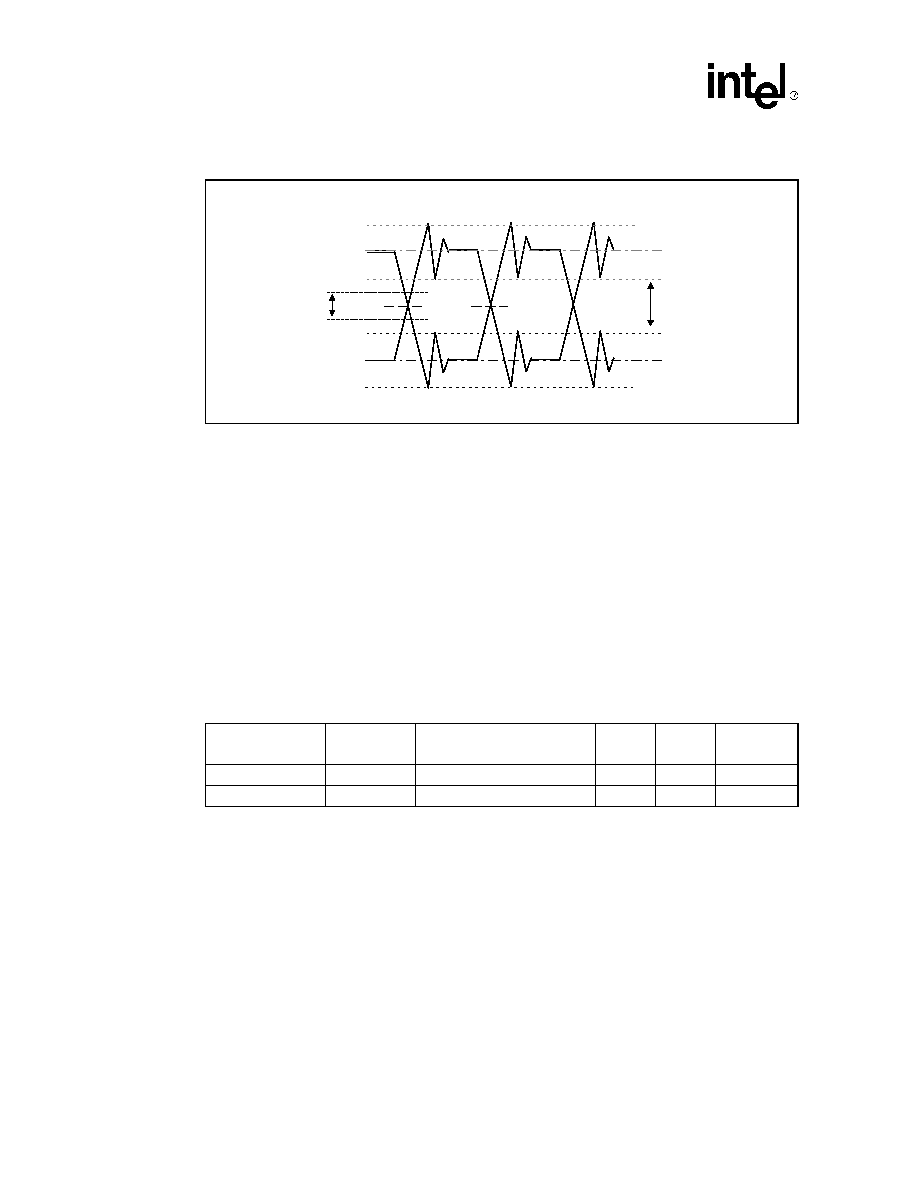
40
Datasheet
Intel
ģ
Celeron
ģ
Processor in the 478-Pin Package
3.2
System Bus Signal Quality Specifications and
Measurement Guidelines
Many scenarios have been simulated to generate a set of AGTL+ layout guidelines that are
available in the Platform Design Guidelines.
Table 20
provides the signal quality specifications for all processor signals for use in simulating
signal quality at the processor silicon.
The Celeron processor in the 478-pin package
maximum allowable overshoot and undershoot
specifications for a given duration of time are detailed in
Table 22
through
Table 25
.
Figure 17
shows the system bus ringback tolerance for low-to-high transitions and
Figure 18
shows ringback
tolerance for high-to-low transitions.
NOTES:
1. All signal integrity specifications are measured at the processor silicon.
2. Unless otherwise noted, all specifications in this table apply to all Celeron processor in the 478-pin package
frequencies and cache sizes.
3. Specifications are for the edge rate of 0.3 ≠ 4.0 V/ns.
4. All values specified by design characterization.
5. Ringback between GTLREF + 100 mV and GTLREF
≠ 100 mV is not supported.
6. Intel recommends simulations not exceed a ringback value of GTLREF
Ī
200 mV to allow margin for other
sources of system noise.
Figure 16. BCLK Signal Integrity Waveform
Crossing
Voltage
Threshold
Region
VH
VL
Overshoot
Undershoot
Ringback
Margin
Rising Edge
Ringback
Falling Edge
Ringback,
BCLK0
BCLK1
Crossing
Voltage
Table 20. Ringback Specifications for AGTL+ and Asynchronous GTL+ Signal Groups
Signal Group
Transition
Maximum Ringback
(with Input Diodes Present)
Unit
Figure
Notes
All Signals
0
1
GTLREF + 0.100
V
17
1,2,3,4,5,6,7
All Signals
1
0
GTLREF - 0.100
V
18
1,2,3,4,5,6,7
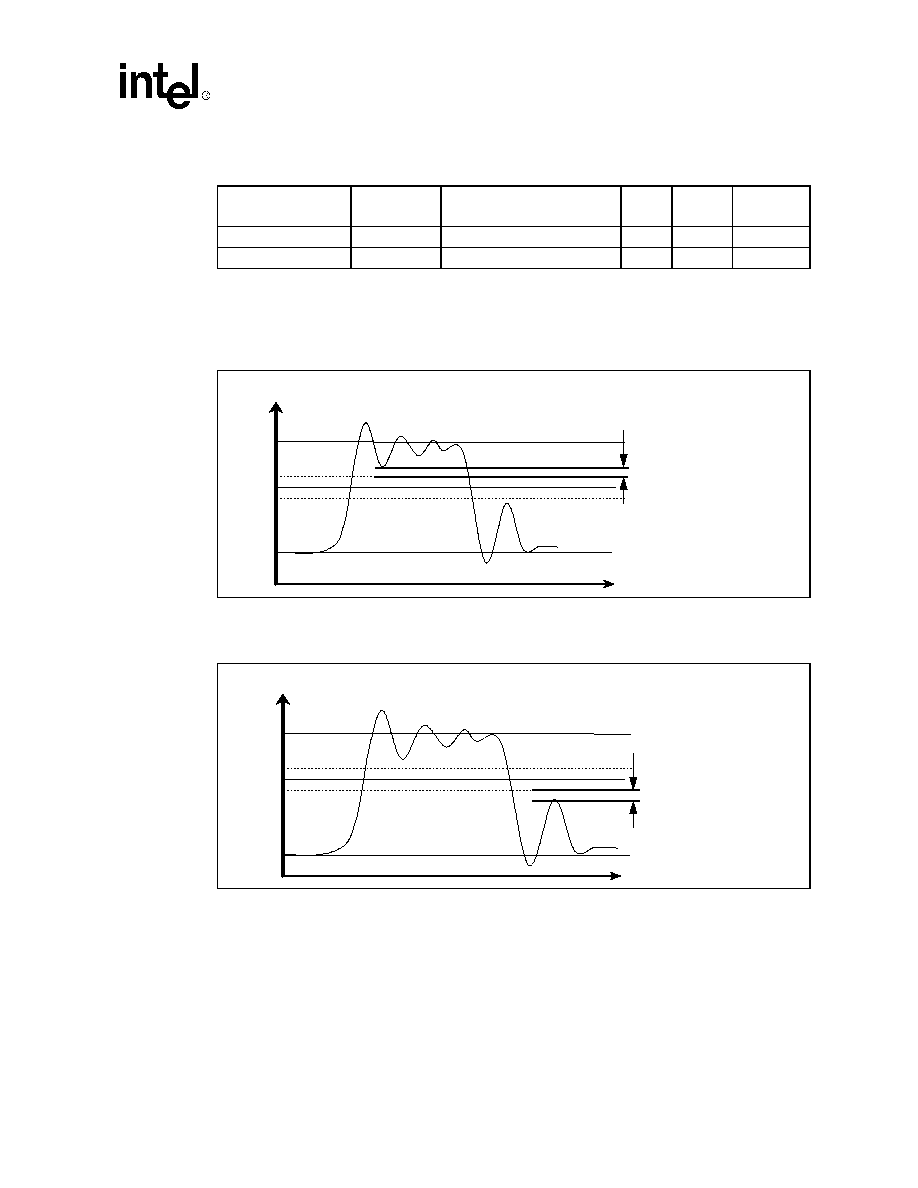
Datasheet
41
Intel
ģ
Celeron
ģ
Processor in the 478-Pin Package
NOTES:
1. All signal integrity specifications are measured at the processor silicon.
2. Unless otherwise noted, all specifications in this table apply to all processor frequencies.
3. See
Section 2.10
for the DC specifications.
Table 21. Ringback Specifications for TAP and PWRGOOD Signal Groups
Signal Group
Transition
Maximum Ringback
(with Input Diodes Present)
Unit
Figure
Notes
TAP and PWRGOOD
0
1
V
t+ (max)
to V
t≠ (max)
V
19
1,2,3
TAP and PWRGOOD
1
0
V
t≠ (min)
to V
t+ (min)
V
20
1,2,3
Figure 17. Low-to-High System Bus Receiver Ringback Tolerance
GTLREF
V
CC
Noise Margin
+100 mV
-100 mV
V
SS
Figure 18. High-to-Low System Bus Receiver Ringback Tolerance
V
CC
Noise Margin
V
SS
GTLREF
+100 mV
-100 mV
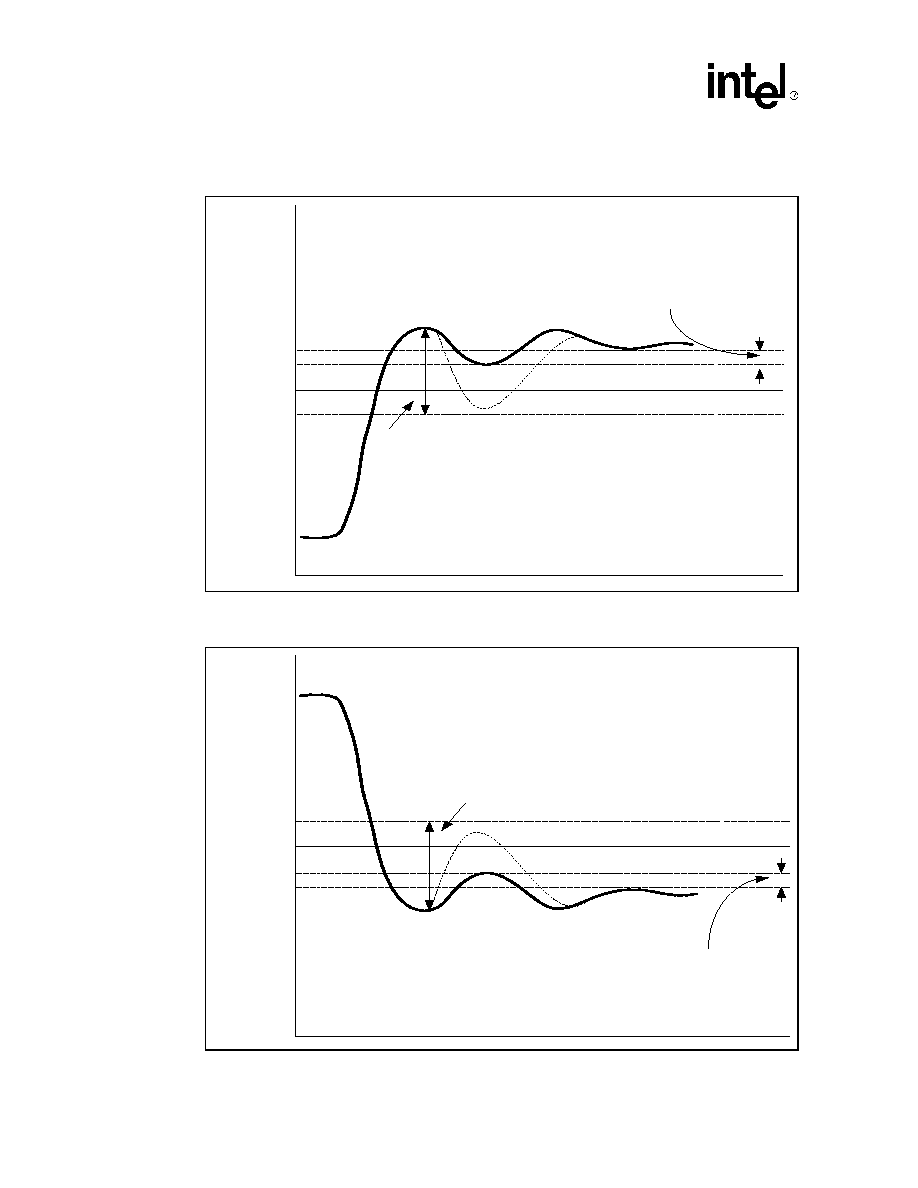
42
Datasheet
Intel
ģ
Celeron
ģ
Processor in the 478-Pin Package
Figure 19. Low-to-High System Bus Receiver Ringback Tolerance for TAP and PWRGOOD
Buffers
Figure 20. High-to-Low System Bus Receiver Ringback Tolerance for TAP and PWRGOOD
Buffers
0.5 * Vcc
Vt+ (min)
Vt+ (max)
Vt- (max)
Vcc
Allowable Ringback
Vss
Threshold Region to switch
receiver to a logic 1.
0.5 * Vcc
Vt+ (min)
Vt- (max)
Vcc
Vss
Vt- (min)
Threshold Region to switch
receiver to a logic 0.
Allowable Ringback

Datasheet
43
Intel
ģ
Celeron
ģ
Processor in the 478-Pin Package
3.2.1
Overshoot/Undershoot Guidelines
Overshoot (or undershoot) is the absolute value of the maximum voltage above the nominal high
voltage (or below V
SS
) as shown in
Figure 21
. The overshoot/undershoot guidelines limit
transitions beyond V
CC
or V
SS
due to the fast signal edge rates. The processor can be damaged by
repeated overshoot or undershoot events on any input, output, or I/O buffer if the charge is large
enough (i.e., if the over/undershoot is great enough). Determining the impact of an overshoot/
undershoot condition requires knowledge of the magnitude, the pulse direction, and the activity
factor (AF) of the incident waveform. Permanent damage to the processor is the likely result of
excessive overshoot/undershoot.
When performing simulations to determine impact of overshoot and undershoot, ESD diodes must
be properly characterized. ESD protection diodes do not act as voltage clamps and will not provide
overshoot or undershoot protection. ESD diodes modelled within Intel I/O buffer models do not
clamp undershoot or overshoot and will yield correct simulation results. If other I/O buffer models
are being used to characterize the Celeron
processor in the 478-pin package system bus, care must
be taken to ensure that ESD models do not clamp extreme voltage levels. Intel I/O buffer models
also contain I/O capacitance characterization. Therefore, removing the ESD diodes from an I/O
buffer model will impact results and may yield excessive overshoot/undershoot.
3.2.1.1
Overshoot/Undershoot Magnitude
Magnitude describes the maximum potential difference between a signal and its voltage reference
level. For the Celeron
processor in the 478-pin package both are referenced to V
SS
. It is important
to note that overshoot and undershoot conditions are separate and their impact must be determined
independently.
Overshoot/undershoot magnitude levels must observe the absolute maximum specifications listed
in
Table 22
through
Table 25
. These specifications must not be violated at any time regardless of
bus activity or system state. Within these specifications are threshold levels that define different
allowed pulse durations. Provided that the magnitude of the overshoot/undershoot is within the
absolute maximum specifications (2.3 V for overshoot and -0.65 V for undershoot), the pulse
magnitude, duration and activity factor must all be used to determine if the overshoot/undershoot
pulse is within specifications.
3.2.1.2
Overshoot/Undershoot Pulse Duration
Pulse duration describes the total time an overshoot/undershoot event exceeds the overshoot/
undershoot reference voltage (maximum overshoot = 2.3 V, maximum undershoot = -0.65 V). The
total time could encompass several oscillations above the reference voltage. Multiple overshoot/
undershoot pulses within a single overshoot/undershoot event may need to be measured to
determine the total pulse duration.
Note: Oscillations below the reference voltage can not be subtracted from the total overshoot/undershoot
pulse duration.

44
Datasheet
Intel
ģ
Celeron
ģ
Processor in the 478-Pin Package
3.2.1.3
Activity Factor
Activity Factor (AF) describes the frequency of overshoot (or undershoot) occurrence relative to a
clock. Since the highest frequency of assertion of any common clock signal is every other clock, an
AF = 1 indicates that the specific overshoot (or undershoot) waveform occurs every other clock
cycle. Thus, an AF = 0.01 indicates that the specific overshoot (or undershoot) waveform occurs
one time in every 200 clock cycles.
For source synchronous signals (address, data, and associated strobes), the activity factor is in
reference to the strobe edge, since the highest frequency of assertion of any source synchronous
signal is every active edge of its associated strobe. An AF = 1 indicates that the specific overshoot
(or undershoot) waveform occurs every strobe cycle.
The specifications provided in
Table 22
through
Table 25
show the maximum pulse duration
allowed for a given overshoot/undershoot magnitude at a specific activity factor. Each table entry is
independent of all others, meaning that the pulse duration reflects the existence of overshoot/
undershoot events of that magnitude ONLY. A platform with an overshoot/undershoot that just
meets the pulse duration for a specific magnitude where the AF < 1, means that there can be no
other overshoot/undershoot events, even of lesser magnitude (note that if AF = 1, then the event
occurs at all times and no other events can occur).
Notes:
1. Activity factor for AGTL+ signals is referenced to BCLK[1:0] frequency.
2. Activity factor for source synchronous (2x) signals is referenced to ADSTB[1:0]#.
3. Activity factor for source synchronous (4x) signals is referenced to DSTBP[3:0]# and
DSTBN[3:0]#.
3.2.1.4
Reading Overshoot/Undershoot Specification Tables
The overshoot/undershoot specification for the Celeron
processor in the 478-pin package is not a
simple single value. Instead, many factors are needed to determine the over/undershoot
specification. In addition to the magnitude of the overshoot, the following parameters must also be
known: the width of the overshoot and the activity factor (AF). To determine the allowed overshoot
for a particular overshoot event, the following must be done:
1. Determine the signal group a particular signal falls into. For AGTL+ signals operating in the
common clock domain, use
Table 24
. For AGTL+ signals operating in the 2x source
synchronous domain, use
Table 23
. For AGTL+ signals operating in the 4x source
synchronous domain, use
Table 22
. Finally, all other signals reside in the 33 MHz domain
(asynchronous GTL+, TAP, etc.) and are referenced in
Table 25
.
2. Determine the magnitude of the overshoot (relative to V
SS
)
3. Determine the activity factor (how often does this overshoot occur?)
4. Next, from the appropriate specification table, determine the maximum pulse duration (in
nanoseconds) allowed.
5. Compare the specified maximum pulse duration to the signal being measured. If the pulse
duration measured is less than the pulse duration shown in the table, then the signal meets the
specifications.
Undershoot events must be analyzed separately from overshoot events as they are mutually
exclusive.

Datasheet
45
Intel
ģ
Celeron
ģ
Processor in the 478-Pin Package
3.2.1.5
Determining if a System Meets the Over/Undershoot Specifications
The overshoot/undershoot specifications listed in the following tables specify the allowable
overshoot/undershoot for a single overshoot/undershoot event. However most systems will have
multiple overshoot and/or undershoot events that each have their own set of parameters (duration,
AF and magnitude). While each overshoot on its own may meet the overshoot specification, when
you add the total impact of all overshoot events, the system may fail. A guideline to ensure a
system passes the overshoot and undershoot specifications is shown below. Results from
simulation may also be evaluated by utilizing the Intel
ģ
Pentium
ģ
4 Processor in the 478-pin
Package Overshoot Checker through the use of time-voltage data files.
∑
Ensure no signal ever exceeds VCC_MAX or ≠0.25 V OR
∑
If only one overshoot/undershoot event magnitude occurs, ensure it meets the over/undershoot
specifications in the following tables OR
∑
If multiple overshoots and/or multiple undershoots occur, measure the worst case pulse
duration for each magnitude and compare the results against the AF = 1 specifications. If all of
these worst case overshoot or undershoot events meet the specifications (measured time <
specifications) in the table (where AF=1), then the system passes.
Notes: The following notes apply to
Table 22
through
Table 25
.
1. Absolute Maximum Overshoot magnitude of 2.3 V must never be exceeded.
2. Absolute Maximum Overshoot is measured relative to V
SS
, Pulse Duration of overshoot is
measured relative to V
CC
.
3. Absolute Maximum Undershoot and Pulse Duration of undershoot is measured relative to
V
CC
.
4. Ringback below V
CC
can not be subtracted from overshoots/undershoots.
5. Lesser undershoot does not allocate longer or larger overshoot.
6. OEM's are strongly encouraged to follow Intel provided layout guidelines.
7. All values specified by design characterization.

46
Datasheet
Intel
ģ
Celeron
ģ
Processor in the 478-Pin Package
NOTES:
1. These specifications are measured at the processor silicon.
2. BCLK period is 10 ns.
3. AF is referenced to associated source synchronous strobes.
NOTES:
1. These specifications are measured at the processor silicon.
2. BCLK period is 10 ns.
3. AF is referenced to associated source synchronous strobes.
Table 22. Source Synchronous (400 MHz) AGTL+ Signal Group Overshoot/Undershoot
Tolerance
Absolute
Maximum
Overshoot
(V)
Absolute
Maximum
Undershoot
(V)
Pulse
Duration (ns)
AF = 1
Pulse
Duration (ns)
AF = 0.1
Pulse
Duration (ns)
AF = 0.01
2.30
≠0.585
0.06 0.63
5.00
2.25
≠0.535
0.11
1.10
5.00
2.20
≠0.485
0.22
2.20
5.00
2.15
≠0.435
0.41
4.10
5.00
2.10
≠0.385
0.75
5.00
5.00
2.05
≠0.335
1.35
5.00
5.00
2.00
≠0.285
2.50
5.00
5.00
1.95
≠0.235
4.70
5.00
5.00
1.90
≠0.185
5.00
5.00
5.00
1.85
≠0.135
5.00
5.00
5.00
1.80
≠0.085
5.00
5.00
5.00
Table 23. Source Synchronous (200 MHz) AGTL+ Signal Group Overshoot/Undershoot
Tolerance
Absolute
Maximum
Overshoot
(V)
Absolute
Maximum
Undershoot
(V)
Pulse
Duration (ns)
AF = 1
Pulse
Duration (ns)
AF = 0.1
Pulse
Duration (ns)
AF = 0.01
2.30
≠0.585
0.12
1.2
10.0
2.25
≠0.535
0.22
2.2
10.0
2.20
≠0.485
0.44
4.4
10.0
2.15
≠0.435
0.82
8.2
10.0
2.10
≠0.385
1.5
10.0
10.0
2.05
≠0.335
2.7
10.0
10.0
2.00
≠0.285
5.0
10.0
10.0
1.95
≠0.235
9.4
10.0
10.0
1.90
≠0.185
10.0
10.0
10.0
1.85
≠0.135
10.0
10.0
10.0
1.80
≠0.085
10.0
10.0
10.0

Datasheet
47
Intel
ģ
Celeron
ģ
Processor in the 478-Pin Package
NOTES:
1. These specifications are measured at the processor silicon.
2. BCLK period is 10 ns.
3. AF is referenced to BCLK[1:0].
NOTES:
1. These specifications are specified at the processor silicon.
2. This table assumes a 33 MHz time domain.
Table 24. Common Clock (100 MHz) AGTL+ Signal Group Overshoot/Undershoot Tolerance
Absolute
Maximum
Overshoot
(V)
Absolute
Maximum
Undershoot
(V)
Pulse
Duration (ns)
AF = 1
Pulse
Duration (ns)
AF = 0.1
Pulse
Duration (ns)
AF = 0.01
2.30
≠0.585
0.24
2.4
20.0
2.25
≠0.535
0.44
4.4
20.0
2.20
≠0.485
0.88
8.8
20.0
2.15
≠0.435
1.64
16.4
20.0
2.10
≠0.385
3.0
20.0
20.0
2.05
≠0.335
5.4
20.0
20.0
2.00
≠0.285
10.0
20.0
20.0
1.95
≠0.235
18.8
20.0
20.0
1.90
≠0.185
20.0
20.0
20.0
1.85
≠0.135
20.0
20.0
20.0
1.80
≠0.085
20.0
20.0
20.0
Table 25. Asynchronous GTL+, PWRGOOD, and TAP Signal Groups Overshoot/Undershoot
Tolerance
Absolute
Maximum
Overshoot
(V)
Absolute
Maximum
Undershoot
(V)
Pulse
Duration (ns)
AF = 1
Pulse
Duration (ns)
AF = 0.1
Pulse
Duration (ns)
AF = 0.01
2.30
≠0.585
0.72
7.2
60.0
2.25
≠0.535
1.32
13.2
60.0
2.20
≠0.485
2.64
26.4
60.0
2.15
≠0.435
4.92
49.2
60.0
2.10
≠0.385
9.0
60.0
60.0
2.05
≠0.335
16.2
60.0
60.0
2.00
≠0.285
30.0
60.0
60.0
1.95
≠0.235
56.4
60.0
60.0
1.90
≠0.185
60.0
60.0
60.0
1.85
≠0.135
60.0
60.0
60.0
1.80
≠0.085
60.0
60.0
60.0

48
Datasheet
Intel
ģ
Celeron
ģ
Processor in the 478-Pin Package
Figure 21. Maximum Acceptable Overshoot/Undershoot Waveform
V
CC
Maximum
Absolute
Overshoot
Maximum
Absolute
Undershoot
Time-dependent
Overshoot
Time-dependent
Undershoot
GTLREF
V
OL
V
MIN
V
MAX
V
SS
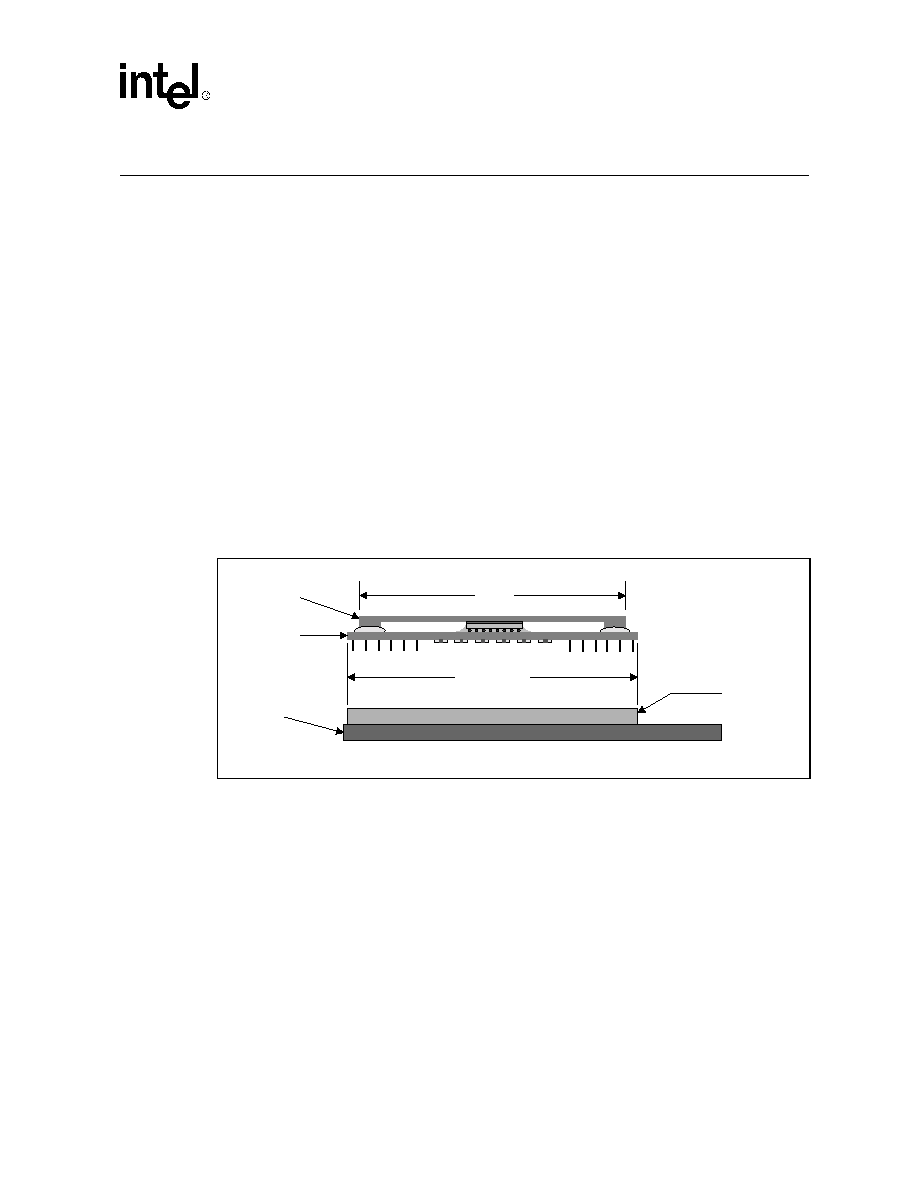
Datasheet
49
Intel
ģ
Celeron
ģ
Processor in the 478-Pin Package
4.0
Package Mechanical Specifications
The Celeron processor in the 478-pin package is packaged in a Flip-Chip Pin Grid Array (FC-
PGA2) package. Components of the package include an integrated heat spreader (IHS), processor
core, and the substrate which is the pin carrier. Mechanical specifications for the processor are
given in this section. See
Section 1.1
for a terminology listing. The processor socket which accepts
the Celeron
processor in the 478-pin package is referred to as a 478-Pin micro PGA (mPGA478B)
socket. See the Intel
ģ
Pentium
ģ
4 Processor 478-Pin Socket (mPGA478B) Socket Design
Guidelines for complete details on the mPGA478B socket.
Notes: The following notes apply to
Figure 22
through
Figure 27
.
1. Unless otherwise specified, the following drawings are dimensioned in millimeters.
2. All dimensions are not tested, but guaranteed by design characterization.
3. Figures and drawings labeled as "Reference Dimensions" are provided for informational
purposes only. Reference dimensions are extracted from the mechanical design database and
are nominal dimensions with no tolerance information applied. Reference dimensions are
NOT checked as part of the processor manufacturing process. Unless noted as such,
dimensions in parentheses without tolerances are reference dimensions.
4. Drawings are not to scale.
NOTE:
The figure is not drawn to scale and is for reference only. The socket and system board are shown as a
reference only.
Figure 22. Exploded View of Processor Components on a System Board
35 mm Square
31 mm
System Board
mPGA478B
Socket
Heat Spreader
Substrate
478 Pins
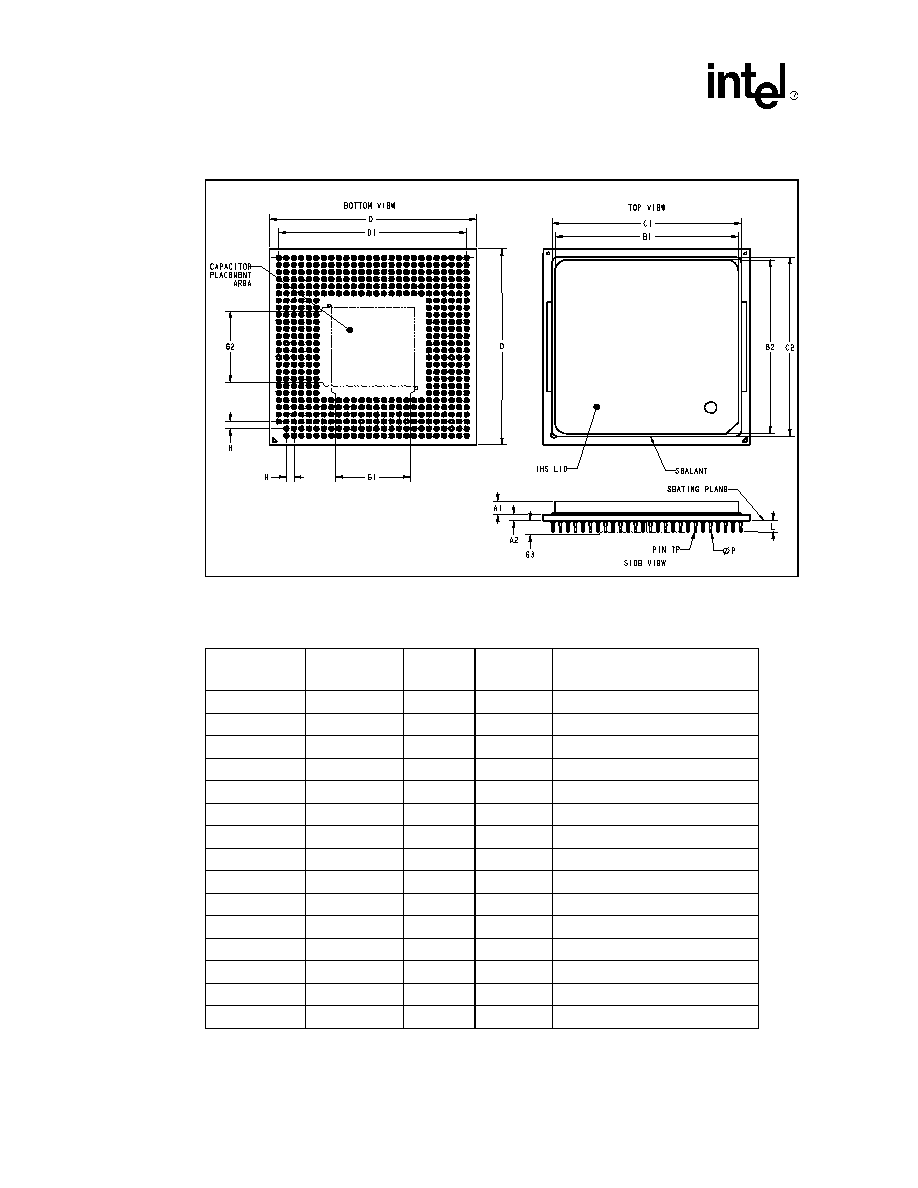
50
Datasheet
Intel
ģ
Celeron
ģ
Processor in the 478-Pin Package
Figure 23. Intel
ģ
Celeron
ģ
Processor in the 478-Pin Package
Table 26. Description Table for Processor Dimensions
Code Letter
Min
(mm)
Nominal
(mm)
Max
(mm)
Notes
A1
2.266
2.378
2.490
A2
0.980
1.080
1.180
B1
30.800
31.000
31.200
B2
30.800
31.000
31.200
C1
33.000
Includes Placement Tolerance
C2
33.000
Includes Placement Tolerance
D
34.900
35.000
35.100
D1
31.500
31.750
32.000
G1
13.970
Keepin Zone Dimension
G2
13.970
Keepin Zone Dimension
G3
1.250
Keepin Zone Dimension
H
1.270
L
1.950
2.030
2.110
P
0.280
0.305
0.330
PIN TP
0.254
Diametric True Position (Pin-to-Pin)

Datasheet
51
Intel
ģ
Celeron
ģ
Processor in the 478-Pin Package
Figure 24
details the keep in specification for pin-side components. The Celeron
processor in the
478-pin package may contain pin side capacitors mounted to the processor package.
Figure 26
details the flatness and tilt specifications for the IHS. Tilt is measured with the reference
datum set to the bottom of the processor interposer.
NOTES:
1. Pin plating consists of 0.2 micrometers Au over 2.0 micrometer Ni.
2. 0.254 mm diametric true position, pin to pin.
Figure 24. Processor Cross-Section and Keep-in
13.97mm
1.25mm
IHS
FCPGA
Component Keepin
Socket must allow clearance
for pin shoulders and mate
flush with this surface
Substrate
13.97mm
1.25mm
IHS
FCPGA
Component Keepin
Socket must allow clearance
for pin shoulders and mate
flush with this surface
Substrate
2
Figure 25. Processor Pin Detail
PINHEAD DIAMETER
ō 0.65 MAX
KEEP OUT ZONE
ō 1.032 MAX
2.03Ī0.08
SOLDER FILLET HEIGHT
0.3 MAX
ALL DIMENSIONS ARE IN MILIMETERS
ō 0.305Ī0.025
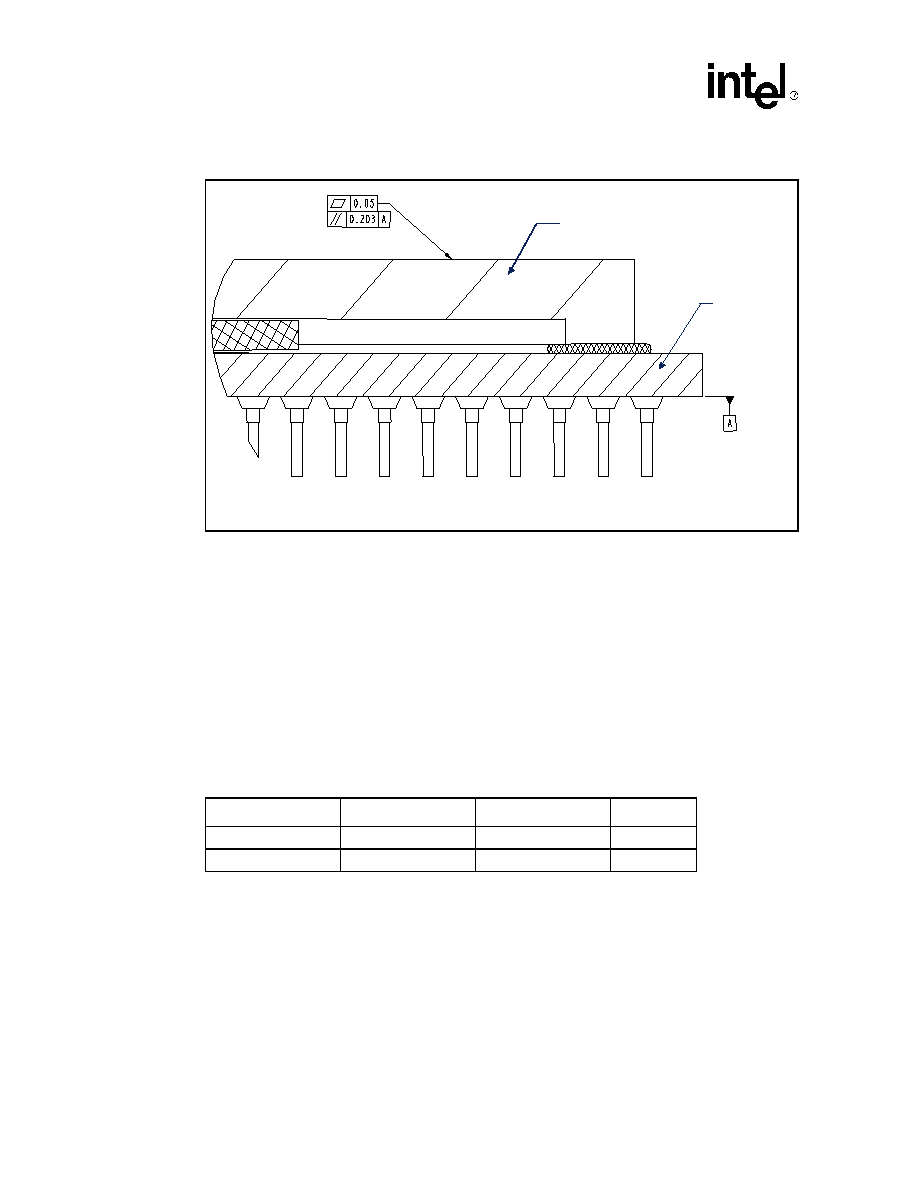
52
Datasheet
Intel
ģ
Celeron
ģ
Processor in the 478-Pin Package
NOTES:
1. Flatness is specific as overall, not per unit of length.
2. All dimensions are in mm.
4.1
Package Load Specifications
Table 27
provides dynamic and static load specifications for the Celeron
processor in the 478-pin
package IHS. These mechanical load limits should not be exceeded during heatsink assembly,
mechanical stress testing, or standard drop and shipping conditions. The heatsink attach solutions
must not induce continuous stress onto the processor with the exception of a uniform load to
maintain the heat sink-to-processor thermal interface. It is not recommended to use any portion of
the processor interposer as a mechanical reference or load bearing surface for thermal solutions.
NOTES:
1. This specification applies to a uniform compressive load.
2. This is the maximum static force that can be applied by the heatsink and clip to maintain the heatsink and
processor interface.
3. These parameters are based on limited testing for design characterization.
4. Dynamic loading specifications are defined assuming a maximum duration of 11ms and 200 lbf is achieved
by superimposing a 100 lbf dynamic load (1 lbm heatsink at 50 g) on the static compressive load.
Figure 26. IHS Flatness Specification
SUBSTRATE
IHS
SUBSTRATE
IHS
IHS
Table 27. Package Dynamic and Static Load Specifications
Parameter
Max
Unit
Notes
Static
100
lbf
1, 2, 3
Dynamic
200
lbf
1, 3, 4
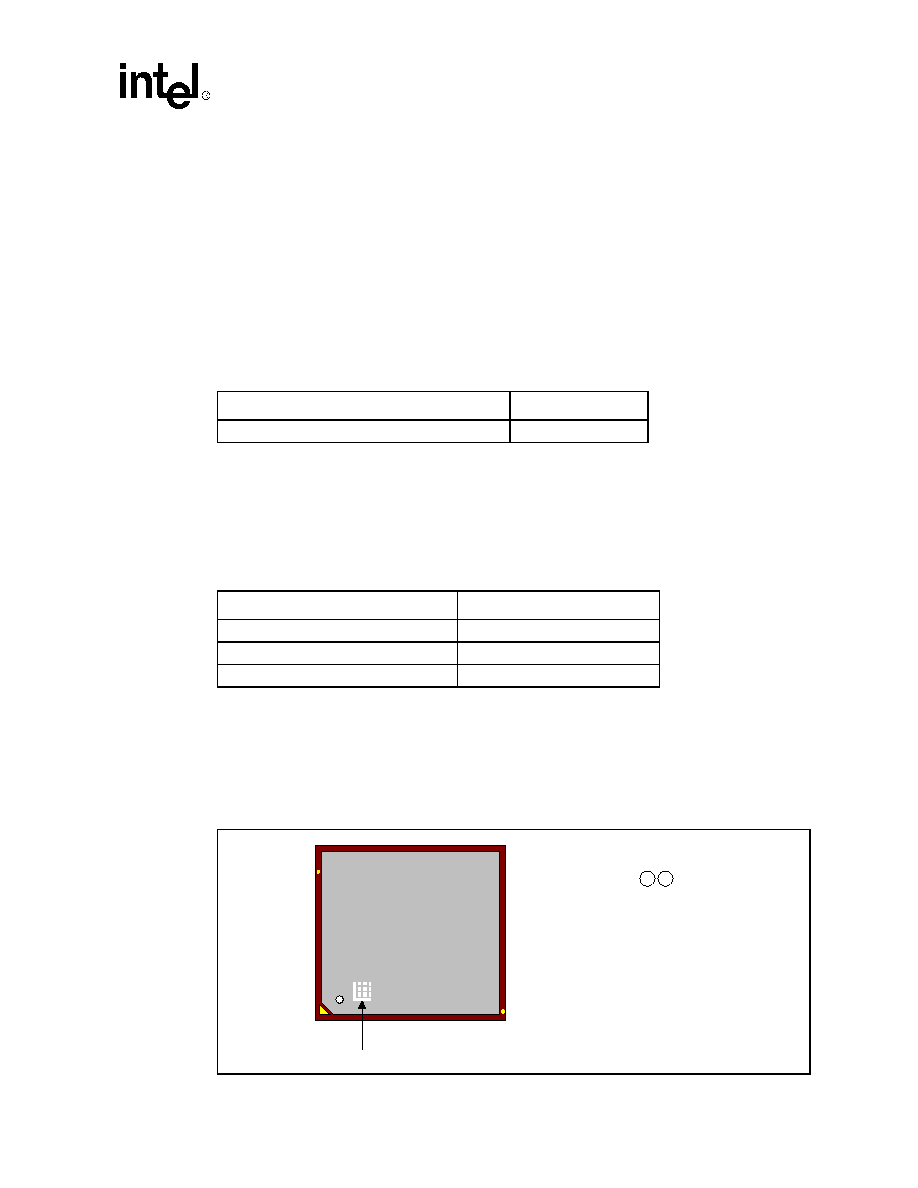
Datasheet
53
Intel
ģ
Celeron
ģ
Processor in the 478-Pin Package
4.2
Processor Insertion Specifications
The Celeron
processor in the 478-pin package can be inserted and removed 15 times from a
mPGA478B socket that meets the specifications in the Intel
ģ
Pentium
ģ
4 Processor 478-Pin Socket
(mPGA478B) Socket Design Guidelines.
4.3
Processor Mass Specifications
Table 28
specifies the processor's mass. This includes all components which make up the entire
processor product.
**
4.4
Processor Materials
The Celeron
processor in the 478-pin package is assembled from several components. The basic
material properties are described in
Table 29
.
4.5
Processor Markings
Figure 27
details the processor top-side markings and is provided to aid in the identification of the
Celeron
processor in the 478-pin package.
Table 28. Processor Mass
Processor
Mass (grams)
Celeron processor in the 478-pin package
19
Table 29. Processor Material Properties
Component
Material
Integrated Heat Spreader
Nickel over copper
Substrate
Fiber-reinforced resin
Substrate pins
Gold over nickel
Figure 27. Processor Markings
2-D Matrix Mark
GRP1LINE1
GRP1LINE2
GRP1LINE3
GRP1LINE4
GRP1LINE5
GRP1LINE1 = Intel
M
C
'02
GRP1LINE2 = Celeron
ģ
GRP1LINE3 = Frequency/Cache/Bus/Voltage
GRP1LINE4 = S-Spec/Country of Origin
GRP1LINE5 = FPO ≠ Serial Number

54
Datasheet
Intel
ģ
Celeron
ģ
Processor in the 478-Pin Package
4.6
Processor Pin-Out Coordinates
Figure 28
and
Figure 29
show the processor pin coordinates.
Figure 28. Processor Pinout Coordinates (Top View, Left Side)
26
25
24
23
22
21
20
19
18
17
16
15
14
AF
SKTOCC#
RESERVED
RESERVED
BCLK1
BCLK0
V
CC
V
SS
V
CC
V
SS
V
CC
V
SS
V
CC
V
SS
AE
V
SS
DBR#
V
SS
V
CCIOPLL
V
SS
RESERVED
V
CC
V
SS
V
CC
V
SS
V
CC
V
SS
V
CC
AD
ITP_CLK1
TESTHI12
TESTHI0
V
SS
V
SSA
V
SS
V
CCA
V
CC
V
SS
V
CC
V
SS
V
CC
V
SS
AC
ITP_CLK0
V
SS
TESTHI4
TESTHI5
V
SS
TESTHI2
TESTHI3
V
SS
V
CC
V
SS
V
CC
V
SS
V
CC
AB
SLP#
RESET#
V
SS
PWRGOOD ITPCLKOUT1
V
SS
V
SS
V
CC
V
SS
V
CC
V
SS
V
CC
V
SS
AA
V
SS
D61#
D63#
V
SS
D62#
GTLREF
ITPCLKOUT0
V
SS
V
CC
V
SS
V
CC
V
SS
V
CC
Y
D56#
V
SS
D59#
D58#
V
SS
D60#
W
D55#
D57#
V
SS
DSTBP3#
DSTBN3#
V
SS
V
V
SS
D51#
D54#
V
SS
D53#
DBI3#
U
D48#
V
SS
D49#
D50#
V
SS
D52#
T
D44#
D45#
V
SS
D47#
D46#
V
SS
R
V
SS
D42#
D43#
V
SS
DSTBN2#
D40#
P
DBI2#
V
SS
D41#
DSTBP2#
V
SS
D34#
N
D38#
D39#
V
SS
D36#
D33#
V
SS
M
D37#
V
SS
D35#
D32#
V
SS
D27#
L
V
SS
DP3#
COMP0
V
SS
D28#
D24#
K
DP2#
DP1#
V
SS
D30#
DSTBN1#
V
SS
J
DP0#
V
SS
D29#
DSTBP1#
V
SS
D14#
H
V
SS
D31#
D26#
V
SS
D16#
D11#
G
D25#
DBI1#
V
SS
D18#
D10#
V
SS
F
D22#
V
SS
D20#
D19#
V
SS
DSTBP0#
GTLREF
V
CC
V
SS
V
CC
V
SS
V
CC
V
SS
E
V
SS
D21#
D17#
V
SS
DSTBN0#
DBI0#
V
CC
V
SS
V
CC
V
SS
V
CC
V
SS
V
CC
D
D23#
D15#
V
SS
D13#
D5#
V
SS
V
SS
V
CC
V
SS
V
CC
V
SS
V
CC
V
SS
C
D12#
V
SS
D8#
D7#
V
SS
D4#
V
CC
V
SS
V
CC
V
SS
V
CC
V
SS
V
CC
B
V
SS
D9#
D6#
V
SS
D1#
D0#
V
SS
V
CC
V
SS
V
CC
V
SS
V
CC
V
SS
A
V
SS
D3#
V
SS
D2#
RESERVED
V
SS
V
CC
V
SS
V
CC
V
SS
V
CC
V
SS
V
CC
26
25
24
23
22
21
20
19
18
17
16
15
14

Datasheet
55
Intel
ģ
Celeron
ģ
Processor in the 478-Pin Package
Figure 29. Processor Pinout Coordinates (Top View, Right Side)
13
12
11
10
9
8
7
6
5
4
3
2
1
V
CC
V
SS
V
CC
V
SS
V
CC
V
SS
V
CC
V
SS
V
CC
VCCVID
RESERVED
V
CC
V
SS
AF
V
SS
V
CC
V
SS
V
CC
V
SS
V
CC
V
SS
V
CC
VID0
VID1
VID2
VID3
VID4
AE
V
CC
V
SS
V
CC
V
SS
V
CC
V
SS
V
CC
BSEL0
BSEL1
V
SS
RESERVED
RESERVED
V
SS
AD
V
SS
V
CC
V
SS
V
CC
V
SS
V
CC
V
SS
BPM0#
V
SS
BPM2#
IERR#
V
SS
AP0#
AC
V
CC
V
SS
V
CC
V
SS
V
CC
V
SS
V
CC
V
SS
BPM1#
BPM5#
V
SS
RSP#
A35#
AB
V
SS
V
CC
V
SS
V
CC
V
SS
V
CC
V
SS
GTLREF
BPM4#
V
SS
BINIT#
TESTHI1
V
SS
AA
BPM3#
V
SS
STPCLK#
TESTHI10
V
SS
A34#
Y
V
SS
INIT#
TESTHI9
V
SS
A33#
A29#
W
MCERR#
AP1#
V
SS
A32#
A27#
V
SS
V
TESTHI8
V
SS
A31#
A25#
V
SS
A23#
U
V
SS
A30#
A26#
V
SS
A22#
A17#
T
A28#
ADSTB1#
V
SS
A21#
A18#
V
SS
R
A24#
V
SS
A20#
A19#
V
SS
COMP1
P
V
SS
A16#
A15#
V
SS
A14#
A12#
N
A8#
V
SS
A11#
A10#
V
SS
A13#
M
A5#
ADSTB0#
V
SS
A7#
A9#
V
SS
L
V
SS
REQ1#
A4#
V
SS
A3#
A6#
K
TRDY#
V
SS
REQ2#
REQ3#
V
SS
REQ0#
J
BR0#
DBSY#
V
SS
REQ4#
DRDY#
V
SS
H
V
SS
RS1#
LOCK#
V
SS
BNR#
ADS#
G
V
CC
V
SS
V
CC
V
SS
V
CC
V
SS
TMS
GTLREF
V
SS
RS2#
HIT#
V
SS
RS0#
F
V
SS
V
CC
V
SS
V
CC
V
SS
V
CC
V
SS
TRST#
LINT1
V
SS
HITM#
DEFER#
V
SS
E
V
CC
V
SS
V
CC
V
SS
V
CC
V
SS
V
CC
V
SS
TDO
TCK
V
SS
BPRI#
LINT0
D
V
SS
V
CC
V
SS
V
CC
V
SS
V
CC
V
SS
A20M#
V
SS
THERMDC
PROCHOT#
V
SS
TDI
C
V
CC
V
SS
V
CC
V
SS
V
CC
V
SS
V
CC
FERR#
SMI#
V
SS
THERMDA
IGNNE#
B
V
SS
V
CC
V
SS
V
CC
V
SS
V
CC
RESERVED
TESTHI11
VCC
SENSE
VSSSENSE
V
SS
THERMTRIP#
A
13
12
11
10
9
8
7
6
5
4
3
2
1

56
Datasheet
Intel
ģ
Celeron
ģ
Processor in the 478-Pin Package
This page is intentionally left blank.

Datasheet
57
Intel
ģ
Celeron
ģ
Processor in the 478-Pin Package
5.0
Pin Listing and Signal Definitions
5.1
Intel
ģ
Celeron
ģ
Processor in the 478-Pin Package Pin
Assignments
Table 30
and
Table 31
are pinlists for the Celeron processor in the 478-pin package.
Table 30
is a
listing of all processor pins ordered alphabetically by pin name.
Table 31
is also a listing of all
processor pins but ordered by pin number.

58
Datasheet
Intel
ģ
Celeron
ģ
Processor in the 478-Pin Package
Table 30. Pin Listing by Pin Name
Pin Name
Pin #
Signal Buffer
Type
Direction
A3#
K2
Source Synch
Input/Output
A4#
K4
Source Synch
Input/Output
A5#
L6
Source Synch
Input/Output
A6#
K1
Source Synch
Input/Output
A7#
L3
Source Synch
Input/Output
A8#
M6
Source Synch
Input/Output
A9#
L2
Source Synch
Input/Output
A10#
M3
Source Synch
Input/Output
A11#
M4
Source Synch
Input/Output
A12#
N1
Source Synch
Input/Output
A13#
M1
Source Synch
Input/Output
A14#
N2
Source Synch
Input/Output
A15#
N4
Source Synch
Input/Output
A16#
N5
Source Synch
Input/Output
A17#
T1
Source Synch
Input/Output
A18#
R2
Source Synch
Input/Output
A19#
P3
Source Synch
Input/Output
A20#
P4
Source Synch
Input/Output
A21#
R3
Source Synch
Input/Output
A22#
T2
Source Synch
Input/Output
A23#
U1
Source Synch
Input/Output
A24#
P6
Source Synch
Input/Output
A25#
U3
Source Synch
Input/Output
A26#
T4
Source Synch
Input/Output
A27#
V2
Source Synch
Input/Output
A28#
R6
Source Synch
Input/Output
A29#
W1
Source Synch
Input/Output
A30#
T5
Source Synch
Input/Output
A31#
U4
Source Synch
Input/Output
A32#
V3
Source Synch
Input/Output
A33#
W2
Source Synch
Input/Output
A34#
Y1
Source Synch
Input/Output
A35#
AB1
Source Synch
Input/Output
A20M#
C6
Asynch GTL+
Input
ADS#
G1
Common Clock Input/Output
ADSTB0#
L5
Source Synch
Input/Output
ADSTB1#
R5
Source Synch
Input/Output
AP0#
AC1
Common Clock Input/Output
AP1#
V5
Common Clock Input/Output
BCLK0
AF22
Bus Clock
Input
BCLK1
AF23
Bus Clock
Input
BINIT#
AA3
Common Clock Input/Output
BNR#
G2
Common Clock Input/Output
BPM0#
AC6
Common Clock Input/Output
BPM1#
AB5
Common Clock Input/Output
BPM2#
AC4
Common Clock Input/Output
BPM3#
Y6
Common Clock Input/Output
BPM4#
AA5
Common Clock Input/Output
BPM5#
AB4
Common Clock Input/Output
BPRI#
D2
Common Clock Input
BR0#
H6
Common Clock Input/Output
BSEL0
AD6
Power/Other
Output
BSEL1
AD5
Power/Other
Output
COMP0
L24
Power/Other
Input/Output
COMP1
P1
Power/Other
Input/Output
D0#
B21
Source Synch
Input/Output
D1#
B22
Source Synch
Input/Output
D2#
A23
Source Synch
Input/Output
D3#
A25
Source Synch
Input/Output
D4#
C21
Source Synch
Input/Output
D5#
D22
Source Synch
Input/Output
D6#
B24
Source Synch
Input/Output
D7#
C23
Source Synch
Input/Output
D8#
C24
Source Synch
Input/Output
D9#
B25
Source Synch
Input/Output
D10#
G22
Source Synch
Input/Output
D11#
H21
Source Synch
Input/Output
D12#
C26
Source Synch
Input/Output
D13#
D23
Source Synch
Input/Output
D14#
J21
Source Synch
Input/Output
D15#
D25
Source Synch
Input/Output
D16#
H22
Source Synch
Input/Output
D17#
E24
Source Synch
Input/Output
D18#
G23
Source Synch
Input/Output
D19#
F23
Source Synch
Input/Output
D20#
F24
Source Synch
Input/Output
Table 30. Pin Listing by Pin Name
Pin Name
Pin #
Signal Buffer
Type
Direction

Datasheet
59
Intel
ģ
Celeron
ģ
Processor in the 478-Pin Package
D21#
E25
Source Synch
Input/Output
D22#
F26
Source Synch
Input/Output
D23#
D26
Source Synch
Input/Output
D24#
L21
Source Synch
Input/Output
D25#
G26
Source Synch
Input/Output
D26#
H24
Source Synch
Input/Output
D27#
M21
Source Synch
Input/Output
D28#
L22
Source Synch
Input/Output
D29#
J24
Source Synch
Input/Output
D30#
K23
Source Synch
Input/Output
D31#
H25
Source Synch
Input/Output
D32#
M23
Source Synch
Input/Output
D33#
N22
Source Synch
Input/Output
D34#
P21
Source Synch
Input/Output
D35#
M24
Source Synch
Input/Output
D36#
N23
Source Synch
Input/Output
D37#
M26
Source Synch
Input/Output
D38#
N26
Source Synch
Input/Output
D39#
N25
Source Synch
Input/Output
D40#
R21
Source Synch
Input/Output
D41#
P24
Source Synch
Input/Output
D42#
R25
Source Synch
Input/Output
D43#
R24
Source Synch
Input/Output
D44#
T26
Source Synch
Input/Output
D45#
T25
Source Synch
Input/Output
D46#
T22
Source Synch
Input/Output
D47#
T23
Source Synch
Input/Output
D48#
U26
Source Synch
Input/Output
D49#
U24
Source Synch
Input/Output
D50#
U23
Source Synch
Input/Output
D51#
V25
Source Synch
Input/Output
D52#
U21
Source Synch
Input/Output
D53#
V22
Source Synch
Input/Output
D54#
V24
Source Synch
Input/Output
D55#
W26
Source Synch
Input/Output
D56#
Y26
Source Synch
Input/Output
D57#
W25
Source Synch
Input/Output
D58#
Y23
Source Synch
Input/Output
Table 30. Pin Listing by Pin Name
Pin Name
Pin #
Signal Buffer
Type
Direction
D59#
Y24
Source Synch
Input/Output
D60#
Y21
Source Synch
Input/Output
D61#
AA25
Source Synch
Input/Output
D62#
AA22
Source Synch
Input/Output
D63#
AA24
Source Synch
Input/Output
DBI0#
E21
Source Synch
Input/Output
DBI1#
G25
Source Synch
Input/Output
DBI2#
P26
Source Synch
Input/Output
DBI3#
V21
Source Synch
Input/Output
DBR#
AE25
Power/Other
Output
DBSY#
H5
Common Clock Input/Output
DEFER#
E2
Common Clock Input
DP0#
J26
Common Clock Input/Output
DP1#
K25
Common Clock Input/Output
DP2#
K26
Common Clock Input/Output
DP3#
L25
Common Clock Input/Output
DRDY#
H2
Common Clock Input/Output
DSTBN0#
E22
Source Synch
Input/Output
DSTBN1#
K22
Source Synch
Input/Output
DSTBN2#
R22
Source Synch
Input/Output
DSTBN3#
W22
Source Synch
Input/Output
DSTBP0#
F21
Source Synch
Input/Output
DSTBP1#
J23
Source Synch
Input/Output
DSTBP2#
P23
Source Synch
Input/Output
DSTBP3#
W23
Source Synch
Input/Output
FERR#
B6
Asynch AGL+
Output
GTLREF
AA21
Power/Other
Input
GTLREF
AA6
Power/Other
Input
GTLREF
F20
Power/Other
Input
GTLREF
F6
Power/Other
Input
HIT#
F3
Common Clock Input/Output
HITM#
E3
Common Clock Input/Output
IERR#
AC3
Common Clock Output
IGNNE#
B2
Asynch GTL+
Input
INIT#
W5
Asynch GTL+
Input
ITPCLKOUT0
AA20
Power/Other
Output
ITPCLKOUT1
AB22
Power/Other
Output
ITP_CLK0
AC26
TAP
input
Table 30. Pin Listing by Pin Name
Pin Name
Pin #
Signal Buffer
Type
Direction

60
Datasheet
Intel
ģ
Celeron
ģ
Processor in the 478-Pin Package
ITP_CLK1
AD26
TAP
input
LINT0
D1
Asynch GTL+
Input
LINT1
E5
Asynch GTL+
Input
LOCK#
G4
Common Clock Input/Output
MCERR#
V6
Common Clock Input/Output
PROCHOT#
C3
Asynch GTL+
Output
PWRGOOD
AB23
Power/Other
Input
REQ0#
J1
Source Synch
Input/Output
REQ1#
K5
Source Synch
Input/Output
REQ2#
J4
Source Synch
Input/Output
REQ3#
J3
Source Synch
Input/Output
REQ4#
H3
Source Synch
Input/Output
RESERVED
A22
RESERVED
A7
RESERVED
AD2
RESERVED
AD3
RESERVED
AE21
RESERVED
AF3
RESERVED
AF24
RESERVED
AF25
RESET#
AB25
Common Clock Input
RS0#
F1
Common Clock Input
RS1#
G5
Common Clock Input
RS2#
F4
Common Clock Input
RSP#
AB2
Common Clock Input
SKTOCC#
AF26
Power/Other
Output
SLP#
AB26
Asynch GTL+
Input
SMI#
B5
Asynch GTL+
Input
STPCLK#
Y4
Asynch GTL+
Input
TCK
D4
TAP
Input
TDI
C1
TAP
Input
TDO
D5
TAP
Output
TESTHI0
AD24
Power/Other
Input
TESTHI1
AA2
Power/Other
Input
TESTHI2
AC21
Power/Other
Input
TESTHI3
AC20
Power/Other
Input
TESTHI4
AC24
Power/Other
Input
TESTHI5
AC23
Power/Other
Input
Table 30. Pin Listing by Pin Name
Pin Name
Pin #
Signal Buffer
Type
Direction
TESTHI8
U6
Power/Other
Input
TESTHI9
W4
Power/Other
Input
TESTHI10
Y3
Power/Other
Input
TESTHI11
A6
Power/Other
Input
TESTHI12
AD25
Power/Other
Input
THERMDA
B3
Power/Other
THERMDC
C4
Power/Other
THERMTRIP#
A2
Asynch GTL+
Output
TMS
F7
TAP
Input
TRDY#
J6
Common Clock Input
TRST#
E6
TAP
Input
V
CC
A10
Power/Other
V
CC
A12
Power/Other
V
CC
A14
Power/Other
V
CC
A16
Power/Other
V
CC
A18
Power/Other
V
CC
A20
Power/Other
V
CC
A8
Power/Other
V
CC
AA10
Power/Other
V
CC
AA12
Power/Other
V
CC
AA14
Power/Other
V
CC
AA16
Power/Other
V
CC
AA18
Power/Other
V
CC
AA8
Power/Other
V
CC
AB11
Power/Other
V
CC
AB13
Power/Other
V
CC
AB15
Power/Other
V
CC
AB17
Power/Other
V
CC
AB19
Power/Other
V
CC
AB7
Power/Other
V
CC
AB9
Power/Other
V
CC
AC10
Power/Other
V
CC
AC12
Power/Other
V
CC
AC14
Power/Other
V
CC
AC16
Power/Other
V
CC
AC18
Power/Other
V
CC
AC8
Power/Other
V
CC
AD11
Power/Other
Table 30. Pin Listing by Pin Name
Pin Name
Pin #
Signal Buffer
Type
Direction

Datasheet
61
Intel
ģ
Celeron
ģ
Processor in the 478-Pin Package
V
CC
AD13
Power/Other
V
CC
AD15
Power/Other
V
CC
AD17
Power/Other
V
CC
AD19
Power/Other
V
CC
AD7
Power/Other
V
CC
AD9
Power/Other
V
CC
AE10
Power/Other
V
CC
AE12
Power/Other
V
CC
AE14
Power/Other
V
CC
AE16
Power/Other
V
CC
AE18
Power/Other
V
CC
AE20
Power/Other
V
CC
AE6
Power/Other
V
CC
AE8
Power/Other
V
CC
AF11
Power/Other
V
CC
AF13
Power/Other
V
CC
AF15
Power/Other
V
CC
AF17
Power/Other
V
CC
AF19
Power/Other
V
CC
AF2
Power/Other
V
CC
AF21
Power/Other
V
CC
AF5
Power/Other
V
CC
AF7
Power/Other
V
CC
AF9
Power/Other
V
CC
B11
Power/Other
V
CC
B13
Power/Other
V
CC
B15
Power/Other
V
CC
B17
Power/Other
V
CC
B19
Power/Other
V
CC
B7
Power/Other
V
CC
B9
Power/Other
V
CC
C10
Power/Other
V
CC
C12
Power/Other
V
CC
C14
Power/Other
V
CC
C16
Power/Other
V
CC
C18
Power/Other
V
CC
C20
Power/Other
V
CC
C8
Power/Other
Table 30. Pin Listing by Pin Name
Pin Name
Pin #
Signal Buffer
Type
Direction
V
CC
D11
Power/Other
V
CC
D13
Power/Other
V
CC
D15
Power/Other
V
CC
D17
Power/Other
V
CC
D19
Power/Other
V
CC
D7
Power/Other
V
CC
D9
Power/Other
V
CC
E10
Power/Other
V
CC
E12
Power/Other
V
CC
E14
Power/Other
V
CC
E16
Power/Other
V
CC
E18
Power/Other
V
CC
E20
Power/Other
V
CC
E8
Power/Other
V
CC
F11
Power/Other
V
CC
F13
Power/Other
V
CC
F15
Power/Other
V
CC
F17
Power/Other
V
CC
F19
Power/Other
V
CC
F9
Power/Other
V
CCA
AD20
Power/Other
V
CCIOPLL
AE23
Power/Other
VCC
SENSE
A5
Power/Other
Output
VCCVID
AF4
Power/Other
Input
VID0
AE5
Power/Other
Output
VID1
AE4
Power/Other
Output
VID2
AE3
Power/Other
Output
VID3
AE2
Power/Other
Output
VID4
AE1
Power/Other
Output
V
SS
D10
Power/Other
V
SS
A11
Power/Other
V
SS
A13
Power/Other
V
SS
A15
Power/Other
V
SS
A17
Power/Other
V
SS
A19
Power/Other
V
SS
A21
Power/Other
V
SS
A24
Power/Other
V
SS
A26
Power/Other
Table 30. Pin Listing by Pin Name
Pin Name
Pin #
Signal Buffer
Type
Direction

62
Datasheet
Intel
ģ
Celeron
ģ
Processor in the 478-Pin Package
V
SS
A3
Power/Other
V
SS
A9
Power/Other
V
SS
AA1
Power/Other
V
SS
AA11
Power/Other
V
SS
AA13
Power/Other
V
SS
AA15
Power/Other
V
SS
AA17
Power/Other
V
SS
AA19
Power/Other
V
SS
AA23
Power/Other
V
SS
AA26
Power/Other
V
SS
AA4
Power/Other
V
SS
AA7
Power/Other
V
SS
AA9
Power/Other
V
SS
AB10
Power/Other
V
SS
AB12
Power/Other
V
SS
AB14
Power/Other
V
SS
AB16
Power/Other
V
SS
AB18
Power/Other
V
SS
AB20
Power/Other
V
SS
AB21
Power/Other
V
SS
AB24
Power/Other
V
SS
AB3
Power/Other
V
SS
AB6
Power/Other
V
SS
AB8
Power/Other
V
SS
AC11
Power/Other
V
SS
AC13
Power/Other
V
SS
AC15
Power/Other
V
SS
AC17
Power/Other
V
SS
AC19
Power/Other
V
SS
AC2
Power/Other
V
SS
AC22
Power/Other
V
SS
AC25
Power/Other
V
SS
AC5
Power/Other
V
SS
AC7
Power/Other
V
SS
AC9
Power/Other
V
SS
AD1
Power/Other
V
SS
AD10
Power/Other
V
SS
AD12
Power/Other
Table 30. Pin Listing by Pin Name
Pin Name
Pin #
Signal Buffer
Type
Direction
V
SS
AD14
Power/Other
V
SS
AD16
Power/Other
V
SS
AD18
Power/Other
V
SS
AD21
Power/Other
V
SS
AD23
Power/Other
V
SS
AD4
Power/Other
V
SS
AD8
Power/Other
V
SS
AE11
Power/Other
V
SS
AE13
Power/Other
V
SS
AE15
Power/Other
V
SS
AE17
Power/Other
V
SS
AE19
Power/Other
V
SS
AE22
Power/Other
V
SS
AE24
Power/Other
V
SS
AE26
Power/Other
V
SS
AE7
Power/Other
V
SS
AE9
Power/Other
V
SS
AF1
Power/Other
V
SS
AF10
Power/Other
V
SS
AF12
Power/Other
V
SS
AF14
Power/Other
V
SS
AF16
Power/Other
V
SS
AF18
Power/Other
V
SS
AF20
Power/Other
V
SS
AF6
Power/Other
V
SS
AF8
Power/Other
V
SS
B10
Power/Other
V
SS
B12
Power/Other
V
SS
B14
Power/Other
V
SS
B16
Power/Other
V
SS
B18
Power/Other
V
SS
B20
Power/Other
V
SS
B23
Power/Other
V
SS
B26
Power/Other
V
SS
B4
Power/Other
V
SS
B8
Power/Other
V
SS
C11
Power/Other
V
SS
C13
Power/Other
Table 30. Pin Listing by Pin Name
Pin Name
Pin #
Signal Buffer
Type
Direction

Datasheet
63
Intel
ģ
Celeron
ģ
Processor in the 478-Pin Package
V
SS
C15
Power/Other
V
SS
C17
Power/Other
V
SS
C19
Power/Other
V
SS
C2
Power/Other
V
SS
C22
Power/Other
V
SS
C25
Power/Other
V
SS
C5
Power/Other
V
SS
C7
Power/Other
V
SS
C9
Power/Other
V
SS
D12
Power/Other
V
SS
D14
Power/Other
V
SS
D16
Power/Other
V
SS
D18
Power/Other
V
SS
D20
Power/Other
V
SS
D21
Power/Other
V
SS
D24
Power/Other
V
SS
D3
Power/Other
V
SS
D6
Power/Other
V
SS
D8
Power/Other
V
SS
E1
Power/Other
V
SS
E11
Power/Other
V
SS
E13
Power/Other
V
SS
E15
Power/Other
V
SS
E17
Power/Other
V
SS
E19
Power/Other
V
SS
E23
Power/Other
V
SS
E26
Power/Other
V
SS
E4
Power/Other
V
SS
E7
Power/Other
V
SS
E9
Power/Other
V
SS
F10
Power/Other
V
SS
F12
Power/Other
V
SS
F14
Power/Other
V
SS
F16
Power/Other
V
SS
F18
Power/Other
V
SS
F2
Power/Other
V
SS
F22
Power/Other
V
SS
F25
Power/Other
Table 30. Pin Listing by Pin Name
Pin Name
Pin #
Signal Buffer
Type
Direction
V
SS
F5
Power/Other
V
SS
F8
Power/Other
V
SS
G21
Power/Other
V
SS
G24
Power/Other
V
SS
G3
Power/Other
V
SS
G6
Power/Other
V
SS
H1
Power/Other
V
SS
H23
Power/Other
V
SS
H26
Power/Other
V
SS
H4
Power/Other
V
SS
J2
Power/Other
V
SS
J22
Power/Other
V
SS
J25
Power/Other
V
SS
J5
Power/Other
V
SS
K21
Power/Other
V
SS
K24
Power/Other
V
SS
K3
Power/Other
V
SS
K6
Power/Other
V
SS
L1
Power/Other
V
SS
L23
Power/Other
V
SS
L26
Power/Other
V
SS
L4
Power/Other
V
SS
M2
Power/Other
V
SS
M22
Power/Other
V
SS
M25
Power/Other
V
SS
M5
Power/Other
V
SS
N21
Power/Other
V
SS
N24
Power/Other
V
SS
N3
Power/Other
V
SS
N6
Power/Other
V
SS
P2
Power/Other
V
SS
P22
Power/Other
V
SS
P25
Power/Other
V
SS
P5
Power/Other
V
SS
R1
Power/Other
V
SS
R23
Power/Other
V
SS
R26
Power/Other
V
SS
R4
Power/Other
Table 30. Pin Listing by Pin Name
Pin Name
Pin #
Signal Buffer
Type
Direction

64
Datasheet
Intel
ģ
Celeron
ģ
Processor in the 478-Pin Package
V
SS
T21
Power/Other
V
SS
T24
Power/Other
V
SS
T3
Power/Other
V
SS
T6
Power/Other
V
SS
U2
Power/Other
V
SS
U22
Power/Other
V
SS
U25
Power/Other
V
SS
U5
Power/Other
V
SS
V1
Power/Other
V
SS
V23
Power/Other
V
SS
V26
Power/Other
Table 30. Pin Listing by Pin Name
Pin Name
Pin #
Signal Buffer
Type
Direction
V
SS
V4
Power/Other
V
SS
W21
Power/Other
V
SS
W24
Power/Other
V
SS
W3
Power/Other
V
SS
W6
Power/Other
V
SS
Y2
Power/Other
V
SS
Y22
Power/Other
V
SS
Y25
Power/Other
V
SS
Y5
Power/Other
V
SSA
AD22
Power/Other
VSSSENSE
A4
Power/Other
Output
Table 30. Pin Listing by Pin Name
Pin Name
Pin #
Signal Buffer
Type
Direction

Datasheet
65
Intel
ģ
Celeron
ģ
Processor in the 478-Pin Package
Table 31. Pin Listing by Pin Number
Pin #
Pin Name
Signal Buffer
Type
Direction
A2
THERMTRIP#
Asynch GTL+
Output
A3
V
SS
Power/Other
A4
VSSSENSE
Power/Other
Output
A5
VCC
SENSE
Power/Other
Output
A6
TESTHI11
Power/Other
Input
A7
RESERVED
A8
V
CC
Power/Other
A9
V
SS
Power/Other
A10
V
CC
Power/Other
A11
V
SS
Power/Other
A12
V
CC
Power/Other
A13
V
SS
Power/Other
A14
V
CC
Power/Other
A15
V
SS
Power/Other
A16
V
CC
Power/Other
A17
V
SS
Power/Other
A18
V
CC
Power/Other
A19
V
SS
Power/Other
A20
V
CC
Power/Other
A21
V
SS
Power/Other
A22
RESERVED
A23
D2#
Source Synch
Input/Output
A24
V
SS
Power/Other
A25
D3#
Source Synch
Input/Output
A26
V
SS
Power/Other
AA1
V
SS
Power/Other
AA2
TESTHI1
Power/Other
Input
AA3
BINIT#
Common Clock
Input/Output
AA4
V
SS
Power/Other
AA5
BPM4#
Common Clock
Input/Output
AA6
GTLREF
Power/Other
Input
AA7
V
SS
Power/Other
AA8
V
CC
Power/Other
AA9
V
SS
Power/Other
AA10
V
CC
Power/Other
AA11
V
SS
Power/Other
AA12
V
CC
Power/Other
AA13
V
SS
Power/Other
AA14
V
CC
Power/Other
AA15
V
SS
Power/Other
AA16
V
CC
Power/Other
AA17
V
SS
Power/Other
AA18
V
CC
Power/Other
AA19
V
SS
Power/Other
AA20
ITPCLKOUT0
Power/Other
Output
AA21
GTLREF
Power/Other
Input
AA22
D62#
Source Synch
Input/Output
AA23
V
SS
Power/Other
AA24
D63#
Source Synch
Input/Output
AA25
D61#
Source Synch
Input/Output
AA26
V
SS
Power/Other
AB1
A35#
Source Synch
Input/Output
AB2
RSP#
Common Clock
Input
AB3
V
SS
Power/Other
AB4
BPM5#
Common Clock
Input/Output
AB5
BPM1#
Common Clock
Input/Output
AB6
V
SS
Power/Other
AB7
V
CC
Power/Other
AB8
V
SS
Power/Other
AB9
V
CC
Power/Other
AB10
V
SS
Power/Other
AB11
V
CC
Power/Other
AB12
V
SS
Power/Other
AB13
V
CC
Power/Other
AB14
V
SS
Power/Other
AB15
V
CC
Power/Other
AB16
V
SS
Power/Other
AB17
V
CC
Power/Other
AB18
V
SS
Power/Other
AB19
V
CC
Power/Other
AB20
V
SS
Power/Other
AB21
V
SS
Power/Other
AB22
ITPCLKOUT1
Power/Other
Output
AB23
PWRGOOD
Power/Other
Input
AB24
V
SS
Power/Other
AB25
RESET#
Common Clock
Input
Table 31. Pin Listing by Pin Number
Pin #
Pin Name
Signal Buffer
Type
Direction

66
Datasheet
Intel
ģ
Celeron
ģ
Processor in the 478-Pin Package
AB26
SLP#
Asynch GTL+
Input
AC1
AP0#
Common Clock
Input/Output
AC2
V
SS
Power/Other
AC3
IERR#
Common Clock
Output
AC4
BPM2#
Common Clock
Input/Output
AC5
V
SS
Power/Other
AC6
BPM0#
Common Clock
Input/Output
AC7
V
SS
Power/Other
AC8
V
CC
Power/Other
AC9
V
SS
Power/Other
AC10
V
CC
Power/Other
AC11
V
SS
Power/Other
AC12
V
CC
Power/Other
AC13
V
SS
Power/Other
AC14
V
CC
Power/Other
AC15
V
SS
Power/Other
AC16
V
CC
Power/Other
AC17
V
SS
Power/Other
AC18
V
CC
Power/Other
AC19
V
SS
Power/Other
AC20
TESTHI3
Power/Other
Input
AC21
TESTHI2
Power/Other
Input
AC22
V
SS
Power/Other
AC23
TESTHI5
Power/Other
Input
AC24
TESTHI4
Power/Other
Input
AC25
V
SS
Power/Other
AC26
ITP_CLK0
TAP
input
AD1
V
SS
Power/Other
AD2
RESERVED
AD3
RESERVED
AD4
V
SS
Power/Other
AD5
BSEL1
Power/Other
Output
AD6
BSEL0
Power/Other
Output
AD7
V
CC
Power/Other
AD8
V
SS
Power/Other
AD9
V
CC
Power/Other
AD10
V
SS
Power/Other
AD11
V
CC
Power/Other
Table 31. Pin Listing by Pin Number
Pin #
Pin Name
Signal Buffer
Type
Direction
AD12
V
SS
Power/Other
AD13
V
CC
Power/Other
AD14
V
SS
Power/Other
AD15
V
CC
Power/Other
AD16
V
SS
Power/Other
AD17
V
CC
Power/Other
AD18
V
SS
Power/Other
AD19
V
CC
Power/Other
AD20
V
CCA
Power/Other
AD21
V
SS
Power/Other
AD22
V
SSA
Power/Other
AD23
V
SS
Power/Other
AD24
TESTHI0
Power/Other
Input
AD25
TESTHI12
Power/Other
Input
AD26
ITP_CLK1
TAP
input
AE1
VID4
Power/Other
Output
AE2
VID3
Power/Other
Output
AE3
VID2
Power/Other
Output
AE4
VID1
Power/Other
Output
AE5
VID0
Power/Other
Output
AE6
V
CC
Power/Other
AE7
V
SS
Power/Other
AE8
V
CC
Power/Other
AE9
V
SS
Power/Other
AE10
V
CC
Power/Other
AE11
V
SS
Power/Other
AE12
V
CC
Power/Other
AE13
V
SS
Power/Other
AE14
V
CC
Power/Other
AE15
V
SS
Power/Other
AE16
V
CC
Power/Other
AE17
V
SS
Power/Other
AE18
V
CC
Power/Other
AE19
V
SS
Power/Other
AE20
V
CC
Power/Other
AE21
RESERVED
AE22
V
SS
Power/Other
AE23
V
CCIOPLL
Power/Other
Table 31. Pin Listing by Pin Number
Pin #
Pin Name
Signal Buffer
Type
Direction

Datasheet
67
Intel
ģ
Celeron
ģ
Processor in the 478-Pin Package
AE24
V
SS
Power/Other
AE25
DBR#
Power/Other
Output
AE26
V
SS
Power/Other
AF1
V
SS
Power/Other
AF2
V
CC
Power/Other
AF3
RESERVED
AF4
VCCVID
Power/Other
Input
AF5
V
CC
Power/Other
AF6
V
SS
Power/Other
AF7
V
CC
Power/Other
AF8
V
SS
Power/Other
AF9
V
CC
Power/Other
AF10
V
SS
Power/Other
AF11
V
CC
Power/Other
AF12
V
SS
Power/Other
AF13
V
CC
Power/Other
AF14
V
SS
Power/Other
AF15
V
CC
Power/Other
AF16
V
SS
Power/Other
AF17
V
CC
Power/Other
AF18
V
SS
Power/Other
AF19
V
CC
Power/Other
AF20
V
SS
Power/Other
AF21
V
CC
Power/Other
AF22
BCLK0
Bus Clock
Input
AF23
BCLK1
Bus Clock
Input
AF24
RESERVED
AF25
RESERVED
AF26
SKTOCC#
Power/Other
Output
B2
IGNNE#
Asynch GTL+
Input
B3
THERMDA
Power/Other
B4
V
SS
Power/Other
B5
SMI#
Asynch GTL+
Input
B6
FERR#
Asynch AGL+
Output
B7
V
CC
Power/Other
B8
V
SS
Power/Other
B9
V
CC
Power/Other
B10
V
SS
Power/Other
Table 31. Pin Listing by Pin Number
Pin #
Pin Name
Signal Buffer
Type
Direction
B11
V
CC
Power/Other
B12
V
SS
Power/Other
B13
V
CC
Power/Other
B14
V
SS
Power/Other
B15
V
CC
Power/Other
B16
V
SS
Power/Other
B17
V
CC
Power/Other
B18
V
SS
Power/Other
B19
V
CC
Power/Other
B20
V
SS
Power/Other
B21
D0#
Source Synch
Input/Output
B22
D1#
Source Synch
Input/Output
B23
V
SS
Power/Other
B24
D6#
Source Synch
Input/Output
B25
D9#
Source Synch
Input/Output
B26
V
SS
Power/Other
C1
TDI
TAP
Input
C2
V
SS
Power/Other
C3
PROCHOT#
Asynch GTL+
Output
C4
THERMDC
Power/Other
C5
V
SS
Power/Other
C6
A20M#
Asynch GTL+
Input
C7
V
SS
Power/Other
C8
V
CC
Power/Other
C9
V
SS
Power/Other
C10
V
CC
Power/Other
C11
V
SS
Power/Other
C12
V
CC
Power/Other
C13
V
SS
Power/Other
C14
V
CC
Power/Other
C15
V
SS
Power/Other
C16
V
CC
Power/Other
C17
V
SS
Power/Other
C18
V
CC
Power/Other
C19
V
SS
Power/Other
C20
V
CC
Power/Other
C21
D4#
Source Synch
Input/Output
C22
V
SS
Power/Other
Table 31. Pin Listing by Pin Number
Pin #
Pin Name
Signal Buffer
Type
Direction

68
Datasheet
Intel
ģ
Celeron
ģ
Processor in the 478-Pin Package
C23
D7#
Source Synch
Input/Output
C24
D8#
Source Synch
Input/Output
C25
V
SS
Power/Other
C26
D12#
Source Synch
Input/Output
D1
LINT0
Asynch GTL+
Input
D2
BPRI#
Common Clock
Input
D3
V
SS
Power/Other
D4
TCK
TAP
Input
D5
TDO
TAP
Output
D6
V
SS
Power/Other
D7
V
CC
Power/Other
D8
V
SS
Power/Other
D9
V
CC
Power/Other
D10
V
SS
Power/Other
D11
V
CC
Power/Other
D12
V
SS
Power/Other
D13
V
CC
Power/Other
D14
V
SS
Power/Other
D15
V
CC
Power/Other
D16
V
SS
Power/Other
D17
V
CC
Power/Other
D18
V
SS
Power/Other
D19
V
CC
Power/Other
D20
V
SS
Power/Other
D21
V
SS
Power/Other
D22
D5#
Source Synch
Input/Output
D23
D13#
Source Synch
Input/Output
D24
V
SS
Power/Other
D25
D15#
Source Synch
Input/Output
D26
D23#
Source Synch
Input/Output
E1
V
SS
Power/Other
E2
DEFER#
Common Clock
Input
E3
HITM#
Common Clock
Input/Output
E4
V
SS
Power/Other
E5
LINT1
Asynch GTL+
Input
E6
TRST#
TAP
Input
E7
V
SS
Power/Other
E8
V
CC
Power/Other
Table 31. Pin Listing by Pin Number
Pin #
Pin Name
Signal Buffer
Type
Direction
E9
V
SS
Power/Other
E10
V
CC
Power/Other
E11
V
SS
Power/Other
E12
V
CC
Power/Other
E13
V
SS
Power/Other
E14
V
CC
Power/Other
E15
V
SS
Power/Other
E16
V
CC
Power/Other
E17
V
SS
Power/Other
E18
V
CC
Power/Other
E19
V
SS
Power/Other
E20
V
CC
Power/Other
E21
DBI0#
Source Synch
Input/Output
E22
DSTBN0#
Source Synch
Input/Output
E23
V
SS
Power/Other
E24
D17#
Source Synch
Input/Output
E25
D21#
Source Synch
Input/Output
E26
V
SS
Power/Other
F1
RS0#
Common Clock
Input
F2
V
SS
Power/Other
F3
HIT#
Common Clock
Input/Output
F4
RS2#
Common Clock
Input
F5
V
SS
Power/Other
F6
GTLREF
Power/Other
Input
F7
TMS
TAP
Input
F8
V
SS
Power/Other
F9
V
CC
Power/Other
F10
V
SS
Power/Other
F11
V
CC
Power/Other
F12
V
SS
Power/Other
F13
V
CC
Power/Other
F14
V
SS
Power/Other
F15
V
CC
Power/Other
F16
V
SS
Power/Other
F17
V
CC
Power/Other
F18
V
SS
Power/Other
F19
V
CC
Power/Other
F20
GTLREF
Power/Other
Input
Table 31. Pin Listing by Pin Number
Pin #
Pin Name
Signal Buffer
Type
Direction

Datasheet
69
Intel
ģ
Celeron
ģ
Processor in the 478-Pin Package
F21
DSTBP0#
Source Synch
Input/Output
F22
V
SS
Power/Other
F23
D19#
Source Synch
Input/Output
F24
D20#
Source Synch
Input/Output
F25
V
SS
Power/Other
F26
D22#
Source Synch
Input/Output
G1
ADS#
Common Clock
Input/Output
G2
BNR#
Common Clock
Input/Output
G3
V
SS
Power/Other
G4
LOCK#
Common Clock
Input/Output
G5
RS1#
Common Clock
Input
G6
V
SS
Power/Other
G21
V
SS
Power/Other
G22
D10#
Source Synch
Input/Output
G23
D18#
Source Synch
Input/Output
G24
V
SS
Power/Other
G25
DBI1#
Source Synch
Input/Output
G26
D25#
Source Synch
Input/Output
H1
V
SS
Power/Other
H2
DRDY#
Common Clock
Input/Output
H3
REQ4#
Source Synch
Input/Output
H4
V
SS
Power/Other
H5
DBSY#
Common Clock
Input/Output
H6
BR0#
Common Clock
Input/Output
H21
D11#
Source Synch
Input/Output
H22
D16#
Source Synch
Input/Output
H23
V
SS
Power/Other
H24
D26#
Source Synch
Input/Output
H25
D31#
Source Synch
Input/Output
H26
V
SS
Power/Other
J1
REQ0#
Source Synch
Input/Output
J2
V
SS
Power/Other
J3
REQ3#
Source Synch
Input/Output
J4
REQ2#
Source Synch
Input/Output
J5
V
SS
Power/Other
J6
TRDY#
Common Clock
Input
J21
D14#
Source Synch
Input/Output
J22
V
SS
Power/Other
Table 31. Pin Listing by Pin Number
Pin #
Pin Name
Signal Buffer
Type
Direction
J23
DSTBP1#
Source Synch
Input/Output
J24
D29#
Source Synch
Input/Output
J25
V
SS
Power/Other
J26
DP0#
Common Clock
Input/Output
K1
A6#
Source Synch
Input/Output
K2
A3#
Source Synch
Input/Output
K3
V
SS
Power/Other
K4
A4#
Source Synch
Input/Output
K5
REQ1#
Source Synch
Input/Output
K6
V
SS
Power/Other
K21
V
SS
Power/Other
K22
DSTBN1#
Source Synch
Input/Output
K23
D30#
Source Synch
Input/Output
K24
V
SS
Power/Other
K25
DP1#
Common Clock
Input/Output
K26
DP2#
Common Clock
Input/Output
L1
V
SS
Power/Other
L2
A9#
Source Synch
Input/Output
L3
A7#
Source Synch
Input/Output
L4
V
SS
Power/Other
L5
ADSTB0#
Source Synch
Input/Output
L6
A5#
Source Synch
Input/Output
L21
D24#
Source Synch
Input/Output
L22
D28#
Source Synch
Input/Output
L23
V
SS
Power/Other
L24
COMP0
Power/Other
Input/Output
L25
DP3#
Common Clock
Input/Output
L26
V
SS
Power/Other
M1
A13#
Source Synch
Input/Output
M2
V
SS
Power/Other
M3
A10#
Source Synch
Input/Output
M4
A11#
Source Synch
Input/Output
M5
V
SS
Power/Other
M6
A8#
Source Synch
Input/Output
M21
D27#
Source Synch
Input/Output
M22
V
SS
Power/Other
M23
D32#
Source Synch
Input/Output
M24
D35#
Source Synch
Input/Output
Table 31. Pin Listing by Pin Number
Pin #
Pin Name
Signal Buffer
Type
Direction

70
Datasheet
Intel
ģ
Celeron
ģ
Processor in the 478-Pin Package
M25
V
SS
Power/Other
M26
D37#
Source Synch
Input/Output
N1
A12#
Source Synch
Input/Output
N2
A14#
Source Synch
Input/Output
N3
V
SS
Power/Other
N4
A15#
Source Synch
Input/Output
N5
A16#
Source Synch
Input/Output
N6
V
SS
Power/Other
N21
V
SS
Power/Other
N22
D33#
Source Synch
Input/Output
N23
D36#
Source Synch
Input/Output
N24
V
SS
Power/Other
N25
D39#
Source Synch
Input/Output
N26
D38#
Source Synch
Input/Output
P1
COMP1
Power/Other
Input/Output
P2
V
SS
Power/Other
P3
A19#
Source Synch
Input/Output
P4
A20#
Source Synch
Input/Output
P5
V
SS
Power/Other
P6
A24#
Source Synch
Input/Output
P21
D34#
Source Synch
Input/Output
P22
V
SS
Power/Other
P23
DSTBP2#
Source Synch
Input/Output
P24
D41#
Source Synch
Input/Output
P25
V
SS
Power/Other
P26
DBI2#
Source Synch
Input/Output
R1
V
SS
Power/Other
R2
A18#
Source Synch
Input/Output
R3
A21#
Source Synch
Input/Output
R4
V
SS
Power/Other
R5
ADSTB1#
Source Synch
Input/Output
R6
A28#
Source Synch
Input/Output
R21
D40#
Source Synch
Input/Output
R22
DSTBN2#
Source Synch
Input/Output
R23
V
SS
Power/Other
R24
D43#
Source Synch
Input/Output
R25
D42#
Source Synch
Input/Output
R26
V
SS
Power/Other
Table 31. Pin Listing by Pin Number
Pin #
Pin Name
Signal Buffer
Type
Direction
T1
A17#
Source Synch
Input/Output
T2
A22#
Source Synch
Input/Output
T3
V
SS
Power/Other
T4
A26#
Source Synch
Input/Output
T5
A30#
Source Synch
Input/Output
T6
V
SS
Power/Other
T21
V
SS
Power/Other
T22
D46#
Source Synch
Input/Output
T23
D47#
Source Synch
Input/Output
T24
V
SS
Power/Other
T25
D45#
Source Synch
Input/Output
T26
D44#
Source Synch
Input/Output
U1
A23#
Source Synch
Input/Output
U2
V
SS
Power/Other
U3
A25#
Source Synch
Input/Output
U4
A31#
Source Synch
Input/Output
U5
V
SS
Power/Other
U6
TESTHI8
Power/Other
Input
U21
D52#
Source Synch
Input/Output
U22
V
SS
Power/Other
U23
D50#
Source Synch
Input/Output
U24
D49#
Source Synch
Input/Output
U25
V
SS
Power/Other
U26
D48#
Source Synch
Input/Output
V1
V
SS
Power/Other
V2
A27#
Source Synch
Input/Output
V3
A32#
Source Synch
Input/Output
V4
V
SS
Power/Other
V5
AP1#
Common Clock
Input/Output
V6
MCERR#
Common Clock
Input/Output
V21
DBI3#
Source Synch
Input/Output
V22
D53#
Source Synch
Input/Output
V23
V
SS
Power/Other
V24
D54#
Source Synch
Input/Output
V25
D51#
Source Synch
Input/Output
V26
V
SS
Power/Other
W1
A29#
Source Synch
Input/Output
W2
A33#
Source Synch
Input/Output
Table 31. Pin Listing by Pin Number
Pin #
Pin Name
Signal Buffer
Type
Direction

Datasheet
71
Intel
ģ
Celeron
ģ
Processor in the 478-Pin Package
W3
V
SS
Power/Other
W4
TESTHI9
Power/Other
Input
W5
INIT#
Asynch GTL+
Input
W6
V
SS
Power/Other
W21
V
SS
Power/Other
W22
DSTBN3#
Source Synch
Input/Output
W23
DSTBP3#
Source Synch
Input/Output
W24
V
SS
Power/Other
W25
D57#
Source Synch
Input/Output
W26
D55#
Source Synch
Input/Output
Y1
A34#
Source Synch
Input/Output
Table 31. Pin Listing by Pin Number
Pin #
Pin Name
Signal Buffer
Type
Direction
Y2
V
SS
Power/Other
Y3
TESTHI10
Power/Other
Input
Y4
STPCLK#
Asynch GTL+
Input
Y5
V
SS
Power/Other
Y6
BPM3#
Common Clock
Input/Output
Y21
D60#
Source Synch
Input/Output
Y22
V
SS
Power/Other
Y23
D58#
Source Synch
Input/Output
Y24
D59#
Source Synch
Input/Output
Y25
V
SS
Power/Other
Y26
D56#
Source Synch
Input/Output
Table 31. Pin Listing by Pin Number
Pin #
Pin Name
Signal Buffer
Type
Direction

72
Datasheet
Intel
ģ
Celeron
ģ
Processor in the 478-Pin Package
5.2
Signal Descriptions
Table 32. Signal Description (Sheet 1 of 7)
Name
Type
Description
A[35:3]#
Input/
Output
A[35:3]# (Address) define a 2
36
-byte physical memory address space. In sub-
phase 1 of the address phase, these pins transmit the address of a transaction. In
sub-phase 2, these pins transmit transaction type information. These signals
must connect the appropriate pins of all agents on the Celeron processor in the
478-pin package system bus. A[35:3]# are protected by parity signals AP[1:0]#.
A[35:3]# are source synchronous signals and are latched into the receiving
buffers by ADSTB[1:0]#.
On the active-to-inactive transition of RESET#, the processor samples a subset
of the A[35:3]# pins to determine power-on configuration. See
Section 7.1
for
more details.
A20M#
Input
If A20M# (Address-20 Mask) is asserted, the processor masks physical address
bit 20 (A20#) before looking up a line in any internal cache and before driving a
read/write transaction on the bus. Asserting A20M# emulates the 8086
processor's address wrap-around at the 1-Mbyte boundary. Assertion of A20M#
is only supported in real mode.
A20M# is an asynchronous signal. However, to ensure recognition of this signal
following an Input/Output write instruction, it must be valid along with the TRDY#
assertion of the corresponding Input/Output Write bus transaction.
ADS#
Input/
Output
ADS# (Address Strobe) is asserted to indicate the validity of the transaction
address on the A[35:3]# and REQ[4:0]# pins. All bus agents observe the ADS#
activation to begin parity checking, protocol checking, address decode, internal
snoop, or deferred reply ID match operations associated with the new
transaction.
ADSTB[1:0]#
Input/
Output
Address strobes are used to latch A[35:3]# and REQ[4:0]# on their rising and
falling edges. Strobes are associated with signals as follows:
Signal
Associated Strobe
REQ[4:0]#, A[16:3]#
ADSTB0#
A[35:17]#
ADSTB1#
AP[1:0]#
Input/
Output
AP[1:0]# (Address Parity) are driven by the request initiator along with ADS#,
A[35:3]#, and the transaction type on the REQ[4:0]#. A correct parity signal is
high if an even number of covered signals are low and low if an odd number of
covered signals are low. This allows parity to be high when all the covered signals
are high. AP[1:0]# should connect the appropriate pins of all Celeron processor in
the 478-pin package system bus agents. The following defines the coverage
model of these signals:
Request Signal
Subphase
Subphase 2
A[35:24]#
AP0#
AP1#
A[23:3]#
AP1#
AP0#
REQ[4:0]#
AP1#
AP0#
BCLK[1:0]
Input
The differential pair BCLK (Bus Clock) determines the system bus frequency. All
processor system bus agents must receive these signals to drive their outputs
and latch their inputs.
All external timing parameters are specified with respect to the rising edge of
BCLK0 crossing V
CROSS
.

Datasheet
73
Intel
ģ
Celeron
ģ
Processor in the 478-Pin Package
BINIT#
Input/
Output
BINIT# (Bus Initialization) may be observed and driven by all processor system
bus agents and if used, must connect the appropriate pins of all such agents. If
the BINIT# driver is enabled during power-on configuration, BINIT# is asserted to
signal any bus condition that prevents reliable future operation.
If BINIT# observation is enabled during power-on configuration, and BINIT# is
sampled asserted, symmetric agents reset their bus LOCK# activity and bus
request arbitration state machines. The bus agents do not reset their IOQ and
transaction tracking state machines upon observation of BINIT# activation. Once
the BINIT# assertion has been observed, the bus agents will re-arbitrate for the
system bus and attempt completion of their bus queue and IOQ entries.
If BINIT# observation is disabled during power-on configuration, a central agent
may handle an assertion of BINIT# as appropriate to the error handling
architecture of the system.
BNR#
Input/
Output
BNR# (Block Next Request) is used to assert a bus stall by any bus agent who is
unable to accept new bus transactions. During a bus stall, the current bus owner
cannot issue any new transactions.
BPM[5:0]#
Input/
Output
BPM[5:0]# (Breakpoint Monitor) are breakpoint and performance monitor signals.
They are outputs from the processor which indicate the status of breakpoints and
programmable counters used for monitoring processor performance. BPM[5:0]#
should connect the appropriate pins of all Celeron processor in the 478-pin
package system bus agents.
BPM4# provides PRDY# (Probe Ready) functionality for the TAP port. PRDY# is
a processor output used by debug tools to determine processor debug readiness.
BPM5# provides PREQ# (Probe Request) functionality for the TAP port. PREQ#
is used by debug tools to request debug operation of the processor.
Refer to
Table 1
for the appropriate Platform Design Guide, and the
ITP700 Debug Port Design Guide
for more detailed information.
These signals do not have on-die termination. Refer to
Section 2.4
, and the
appropriate Platform Design Guide for termination requirements.
BPRI#
Input
BPRI# (Bus Priority Request) is used to arbitrate for ownership of the processor
system bus. It must connect the appropriate pins of all processor system bus
agents. Observing BPRI# active (as asserted by the priority agent) causes all
other agents to stop issuing new requests, unless such requests are part of an
ongoing locked operation. The priority agent keeps BPRI# asserted until all of its
requests are completed, then releases the bus by deasserting BPRI#.
BR0#
Input/
Output
BR0# drives the BREQ0# signal in the system and is used by the processor to
request the bus. During power-on configuration this pin is sampled to determine
the agent ID = 0.
This signal does not have on-die termination and must be terminated.
BSEL[1:0]
Output
The BCLK[1:0] frequency select signals BSEL[1:0] are used to select the
processor input clock frequency.
Table 4
defines the possible combinations of the
signals and the frequency associated with each combination. The required
frequency is determined by the processor, chipset and clock synthesizer. All
agents must operate at the same frequency. The Celeron processor in the
478-pin package operates currently at a 400 MHz system bus frequency
(100 MHz BCLK[1:0] frequency). For more information about these pins,
including termination recommendations refer to
Section 2.8
and the appropriate
Platform Design Guide.
COMP[1:0]
Analog
COMP[1:0] must be terminated on the system board using precision resistors.
Refer to the appropriate Platform Design Guide
for details on implementation.
Table 32. Signal Description (Sheet 2 of 7)
Name
Type
Description

74
Datasheet
Intel
ģ
Celeron
ģ
Processor in the 478-Pin Package
D[63:0]#
Input/
Output
D[63:0]# (Data) are the data signals. These signals provide a 64-bit data path
between the processor system bus agents, and must connect the appropriate
pins on all such agents. The data driver asserts DRDY# to indicate a valid data
transfer.
D[63:0]# are quad-pumped signals and will thus be driven four times in a
common clock period. D[63:0]# are latched off the falling edge of both
DSTBP[3:0]# and DSTBN[3:0]#. Each group of 16 data signals correspond to a
pair of one DSTBP# and one DSTBN#.
The following are the groupings of the quad-pumped data signals, and their
associated data strobes and DBI#:
Data Group
DSTBN# / DSTBP#
DBI#
D[15:0]#
0
0
D[31:16]#
1
1
D[47:32]#
2
2
D[63:48]#
3
3
Furthermore, the DBI# pins determine the polarity of the data signals. Each group
of 16 data signals corresponds to one DBI# signal. When the DBI# signal is
active, the corresponding data group is inverted and therefore sampled active
high.
DBI[3:0]#
Input/
Output
DBI[3:0]# are source synchronous and indicate the polarity of the D[63:0]#
signals. The DBI[3:0]# signals are activated when the data on the data bus is
inverted. The bus agent will invert the data bus signals if more than half the bits,
within the covered group, would change level in the next cycle.
The following are the DBI[3:0] assignments to the data bus:
Bus Signal
Data Bus Signals
DBI3#
D[63:48]#
DBI2#
D[47:32]#
DBI1#
D[31:16]#
DBI0#
D[15:0]#
DBR#
Output
DBR# is used only in processor systems where no debug port is implemented on
the system board. DBR# is used by a debug port interposer so that an in-target
probe can drive system reset. If a debug port is implemented in the system,
DBR# is a no connect in the system. DBR# is not a processor signal.
DBSY#
Input/
Output
DBSY# (Data Bus Busy) is asserted by the agent responsible for driving data on
the processor system bus to indicate that the data bus is in use. The data bus is
released after DBSY# is deasserted. This signal must connect the appropriate
pins on all processor system bus agents.
DEFER#
Input
DEFER# is asserted by an agent to indicate that a transaction cannot be
guaranteed in-order completion. Assertion of DEFER# is normally the
responsibility of the addressed memory or Input/Output agent. This signal must
connect the appropriate pins of all processor system bus agents.
DP[3:0]#
Input/
Output
DP[3:0]# (Data parity) provide parity protection for the D[63:0]# signals. They are
driven by the agent responsible for driving D[63:0]#, and must connect the
appropriate pins of all Celeron processor in the 478-pin package system bus
agents.
DRDY#
Input/
Output
DRDY# (Data Ready) is asserted by the data driver on each data transfer,
indicating valid data on the data bus. In a multi-common clock data transfer,
DRDY# may be deasserted to insert idle clocks. This signal must connect the
appropriate pins of all processor system bus agents.
DSTBN[3:0]#
Input/
Output
The following are the DSTBN data strobes that are used to latch D[63:0]#:
Signals
Associated Strobe
D[15:0]#, DBI0#
DSTBN0#
D[31:16]#, DBI1#
DSTBN1#
D[47:32]#, DBI2#
DSTBN2#
D[63:48]#, DBI3#
DSTBN3#
Table 32. Signal Description (Sheet 3 of 7)
Name
Type
Description

Datasheet
75
Intel
ģ
Celeron
ģ
Processor in the 478-Pin Package
DSTBP[3:0]#
Input/
Output
The following are the DSTBP data strobes that are used to latch D[63:0]#:
Signals
Associated Strobe
D[15:0]#, DBI0#
DSTBP0#
D[31:16]#, DBI1#
DSTBP1#
D[47:32]#, DBI2#
DSTBP2#
D[63:48]#, DBI3#
DSTBP3#
FERR#
Output
FERR# (Floating-point Error) is asserted when the processor detects an
unmasked floating-point error. FERR# is similar to the ERROR# signal on the
Intel 387 coprocessor, and is included for compatibility with systems using
MS-DOS*-type floating-point error reporting.
GTLREF
Input
GTLREF determines the signal reference level for AGTL+ input pins. GTLREF
should be set at 2/3 V
CC
. GTLREF is used by the AGTL+ receivers to determine if
a signal is a logical 0 or logical 1. Refer to the appropriate Platform Design Guide
for more information.
HIT#
HITM#
Input/
Output
Input/
Output
HIT# (Snoop Hit) and HITM# (Hit Modified) convey transaction snoop operation
results. Any system bus agent may assert both HIT# and HITM# together to
indicate that it requires a snoop stall, which can be continued by reasserting HIT#
and HITM# together.
IERR#
Output
IERR# (Internal Error) is asserted by a processor as the result of an internal error.
Assertion of IERR# is usually accompanied by a SHUTDOWN transaction on the
processor system bus. This transaction may optionally be converted to an
external error signal (e.g., NMI) by system core logic. The processor will keep
IERR# asserted until the assertion of RESET#. IERR# is de-asserted on
assertion of RESET# only and not other signals.
This signals does not have on-die termination. Refer to
Section 2.4
for
termination requirements.
IGNNE#
Input
IGNNE# (Ignore Numeric Error) is asserted to force the processor to ignore a
numeric error and continue to execute noncontrol floating-point instructions. If
IGNNE# is deasserted, the processor generates an exception on a noncontrol
floating-point instruction if a previous floating-point instruction caused an error.
IGNNE# has no effect when the NE bit in control register 0 (CR0) is set.
IGNNE# is an asynchronous signal. However, to ensure recognition of this signal
following an Input/Output write instruction, it must be valid along with the TRDY#
assertion of the corresponding Input/Output Write bus transaction.
INIT#
Input
INIT# (Initialization), when asserted, resets integer registers inside the processor
without affecting its internal caches or floating-point registers. The processor then
begins execution at the power-on Reset vector configured during power-on
configuration. The processor continues to handle snoop requests during INIT#
assertion. INIT# is an asynchronous signal and must connect the appropriate
pins of all processor system bus agents.
If INIT# is sampled active on the active to inactive transition of RESET#, then the
processor executes its Built-in Self-Test (BIST).
ITPCLKOUT[1:0] Output
The ITPCLKOUT[1:0] pins do not provide any output for the Celeron processor in
the 478-pin package. The function of these pins for the Pentium
ģ
4 processor
with 512 KB L2 Cache on 0.13 micron process
can be found in the
Intel
ģ
Pentium
ģ
4 Processor with 512 KB L2 Cache on 0.13 Micron Process
Datasheet
. Refer to
Section 2.4
for additional details and termination
requirements.
ITP_CLK[1:0]
Input
ITP_CLK[1:0] are copies of BCLK that are used only in processor systems where
no debug port is implemented on the system board. ITP_CLK[1:0] are used as
BCLK[1:0] references for a debug port implemented on an interposer. If a debug
port is implemented in the system, ITP_CLK[1:0] are no connects in the system.
These are not processor signals.
Table 32. Signal Description (Sheet 4 of 7)
Name
Type
Description

76
Datasheet
Intel
ģ
Celeron
ģ
Processor in the 478-Pin Package
LINT[1:0]
Input
LINT[1:0] (Local APIC Interrupt) must connect the appropriate pins of all APIC
Bus agents. When the APIC is disabled, the LINT0 signal becomes INTR, a
maskable interrupt request signal, and LINT1 becomes NMI, a nonmaskable
interrupt. INTR and NMI are backward compatible with the signals of those
names on the Pentium processor. Both signals are asynchronous.
Both of these signals must be software configured via BIOS programming of the
APIC register space to be used either as NMI/INTR or LINT[1:0]. Because the
APIC is enabled by default after Reset, operation of these pins as LINT[1:0] is the
default configuration.
LOCK#
Input/
Output
LOCK# indicates to the system that a transaction must occur atomically. This
signal must connect the appropriate pins of all processor system bus agents. For
a locked sequence of transactions, LOCK# is asserted from the beginning of the
first transaction to the end of the last transaction.
When the priority agent asserts BPRI# to arbitrate for ownership of the processor
system bus, it will wait until it observes LOCK# deasserted. This enables
symmetric agents to retain ownership of the processor system bus throughout the
bus locked operation and ensure the atomicity of lock.
MCERR#
Input/
Output
MCERR# (Machine Check Error) is asserted to indicate an unrecoverable error
without a bus protocol violation. It may be driven by all processor system bus
agents.
MCERR# assertion conditions are configurable at a system level. Assertion
options are defined by the following options:
∑ Enabled or disabled.
∑ Asserted, if configured, for internal errors along with IERR#.
∑ Asserted, if configured, by the request initiator of a bus transaction after it
observes an error.
∑ Asserted by any bus agent when it observes an error in a bus transaction.
For more details regarding machine check architecture, refer to the
IA-32
Software Developer's Manual, Volume 3: System Programming Guide
.
PROCHOT#
Output
PROCHOT# will go active when the processor temperature monitoring sensor
detects that the processor has reached its maximum safe operating temperature.
This indicates that the processor Thermal Control Circuit has been activated, if
enabled. See
Section 7.3
for more details.
PWRGOOD
Input
PWRGOOD (Power Good) is a processor input. The processor requires this
signal to be a clean indication that the clocks and power supplies are stable and
within their specifications. `Clean' implies that the signal will remain low (capable
of sinking leakage current), without glitches, from the time that the power supplies
are turned on until they come within specification. The signal must then transition
monotonically to a high state.
Figure 12
illustrates the relationship of PWRGOOD
to the RESET# signal. PWRGOOD can be driven inactive at any time, but clocks
and power must again be stable before a subsequent rising edge of PWRGOOD.
It must also meet the minimum pulse width specification in
Table 16
, and be
followed by a 1 to 10 ms RESET# pulse.
The PWRGOOD signal must be supplied to the processor; it is used to protect
internal circuits against voltage sequencing issues. It should be driven high
throughout boundary scan operation.
REQ[4:0]#
Input/
Output
REQ[4:0]# (Request Command) must connect the appropriate pins of all
processor system bus agents. They are asserted by the current bus owner to
define the currently active transaction type. These signals are source
synchronous to ADSTB0#. Refer to the AP[1:0]# signal description for a details
on parity checking of these signals.
Table 32. Signal Description (Sheet 5 of 7)
Name
Type
Description

Datasheet
77
Intel
ģ
Celeron
ģ
Processor in the 478-Pin Package
RESET#
Input
Asserting the RESET# signal resets the processor to a known state and
invalidates its internal caches without writing back any of their contents. For a
power-on Reset, RESET# must stay active for at least one millisecond after V
CC
and BCLK have reached their proper specifications. On observing active
RESET#, all system bus agents will deassert their outputs within two clocks.
RESET# must not be kept asserted for more than 10 ms while PWRGOOD is
asserted.
A number of bus signals are sampled at the active-to-inactive transition of
RESET# for power-on configuration. These configuration options are described in
the
Section 7.1
.
This signal does not have on-die termination and must be terminated on the
system board.
RS[2:0]#
Input
RS[2:0]# (Response Status) are driven by the response agent (the agent
responsible for completion of the current transaction), and must connect the
appropriate pins of all processor system bus agents.
RSP#
Input
RSP# (Response Parity) is driven by the response agent (the agent responsible
for completion of the current transaction) during assertion of RS[2:0]#, the signals
for which RSP# provides parity protection. It must connect to the appropriate pins
of all processor system bus agents.
A correct parity signal is high if an even number of covered signals are low and
low if an odd number of covered signals are low. While RS[2:0]# = 000, RSP# is
also high, since this indicates it is not being driven by any agent guaranteeing
correct parity.
SKTOCC#
Output
SKTOCC# (Socket Occupied) will be pulled to ground by the processor. System
board designers may use this pin to determine if the processor is present.
SLP#
Input
SLP# (Sleep), when asserted in Stop-Grant state, causes the processor to enter
the Sleep state. During Sleep state, the processor stops providing internal clock
signals to all units, leaving only the Phase-Locked Loop (PLL) still operating.
Processors in this state will not recognize snoops or interrupts. The processor will
recognize only assertion of the RESET# signal, deassertion of SLP#, and
removal of the BCLK input while in Sleep state. If SLP# is deasserted, the
processor exits Sleep state and returns to Stop-Grant state, restarting its internal
clock signals to the bus and processor core units. If the BCLK input is stopped
while in the Sleep state the processor will exit the Sleep state and transition to the
Deep Sleep state.
SMI#
Input
SMI# (System Management Interrupt) is asserted asynchronously by system
logic. On accepting a System Management Interrupt, the processor saves the
current state and enter System Management Mode (SMM). An SMI Acknowledge
transaction is issued, and the processor begins program execution from the SMM
handler.
If SMI# is asserted during the deassertion of RESET#, the processor will tristate
its outputs.
STPCLK#
Input
STPCLK# (Stop Clock), when asserted, causes the processor to enter a low
power Stop-Grant state. The processor issues a Stop-Grant Acknowledge
transaction, and stops providing internal clock signals to all processor core units
except the system bus and APIC units. The processor continues to snoop bus
transactions and service interrupts while in Stop-Grant state. When STPCLK# is
deasserted, the processor restarts its internal clock to all units and resumes
execution. The assertion of STPCLK# has no effect on the bus clock; STPCLK#
is an asynchronous input.
TCK
Input
TCK (Test Clock) provides the clock input for the processor Test Bus (also known
as the Test Access Port).
TDI
Input
TDI (Test Data In) transfers serial test data into the processor. TDI provides the
serial input needed for JTAG specification support.
TDO
Output
TDO (Test Data Out) transfers serial test data out of the processor. TDO provides
the serial output needed for JTAG specification support.
Table 32. Signal Description (Sheet 6 of 7)
Name
Type
Description

78
Datasheet
Intel
ģ
Celeron
ģ
Processor in the 478-Pin Package
TESTHI[12:8]
TESTHI[5:0]
Input
TESTHI[12:8] and TESTHI[5:0] must be connected to a V
CC
power source
through a resistor for proper processor operation. See
Section 2.4
for more
details.
THERMDA
Other
Thermal Diode Anode. See
Section 7.3.1
.
THERMDC
Other
Thermal Diode Cathode. See
Section 7.3.1
.
THERMTRIP#
Output
Assertion of THERMTRIP# (Thermal Trip) indicates the processor junction
temperature has reached a level beyond which permanent silicon damage may
occur. Measurement of the temperature is accomplished through an internal
thermal sensor which is configured to trip at approximately 135įC. Upon
assertion of THERMTRIP#, the processor will shut off its internal clocks (thus
halting program execution) in an attempt to reduce the processor junction
temperature. To protect the processor, its core voltage (V
CC
) must be removed
following the assertion of THERMTRIP#. See
Figure 13
and
Table 16
for the
appropriate power down sequence and timing requirements. Once activated,
THERMTRIP# remains latched until RESET# is asserted. While the assertion of
the RESET# signal will de-assert THERMTRIP#, if the processor's junction
temperature remains at or above the trip level, THERMTRIP# will again be
asserted after RESET# is de-asserted.
TMS
Input
TMS (Test Mode Select) is a JTAG specification support signal used by debug
tools.
TRDY#
Input
TRDY# (Target Ready) is asserted by the target to indicate that it is ready to
receive a write or implicit writeback data transfer. TRDY# must connect the
appropriate pins of all system bus agents.
TRST#
Input
TRST# (Test Reset) resets the Test Access Port (TAP) logic. TRST# must be
driven low during power on Reset. This can be done with a 680
pull-down
resistor.
V
CCA
Input
V
CCA
provides isolated power for the internal processor core PLLs. Refer to the
appropriate Platform Design Guide
for complete implementation details.
V
CCIOPLL
Input
V
CCIOPLL
provides isolated power for internal processor system bus PLLs. Follow
the guidelines for V
CCA
, and refer to the appropriate Platform Design Guide
for
complete implementation details.
VCC
SENSE
Output
VCC
SENSE
is an isolated low impedance connection to processor core power
(V
CC
). It can be used to sense or measure power near the silicon with little noise.
VCCVID
Input
1.2 V are required to be supplied to the VCCVID pin if the platform is going to
support the Pentium
ģ
processor with 512 KB L2 cache on .13 micron process.
This requirement is to enable the platform to be upgradeable to the
Pentium
ģ
processor with 512 KB L2 cache on 0.13 micron process and is not
necessary if the platform will only support the Celeron processor in the 478-pin
package. Refer to the
Pentium
ģ
4 Processor with 512 KB L2 Cache on 0.13
Micron Process Datasheet
and the appropriate Platform Design Guide
for more
information.
VID[4:0]
Output
VID[4:0] (Voltage ID) pins can be used to support automatic selection of power
supply voltages (V
CC
). These pins are not signals, but are either an open circuit
or a short circuit to V
SS
on the processor. The combination of opens and shorts
defines the voltage required by the processor. The VID pins are needed to cleanly
support processor voltage specification variations. See
Table 2
for definitions of
these pins. The power supply must supply the voltage that is requested by these
pins, or disable itself.
V
SSA
Input
V
SSA
is the isolated ground for internal PLLs.
V
SSSENSE
Output
V
SSSENSE
is an isolated low impedance connection to processor core V
SS
. It can
be used to sense or measure ground near the silicon with little noise
Table 32. Signal Description (Sheet 7 of 7)
Name
Type
Description
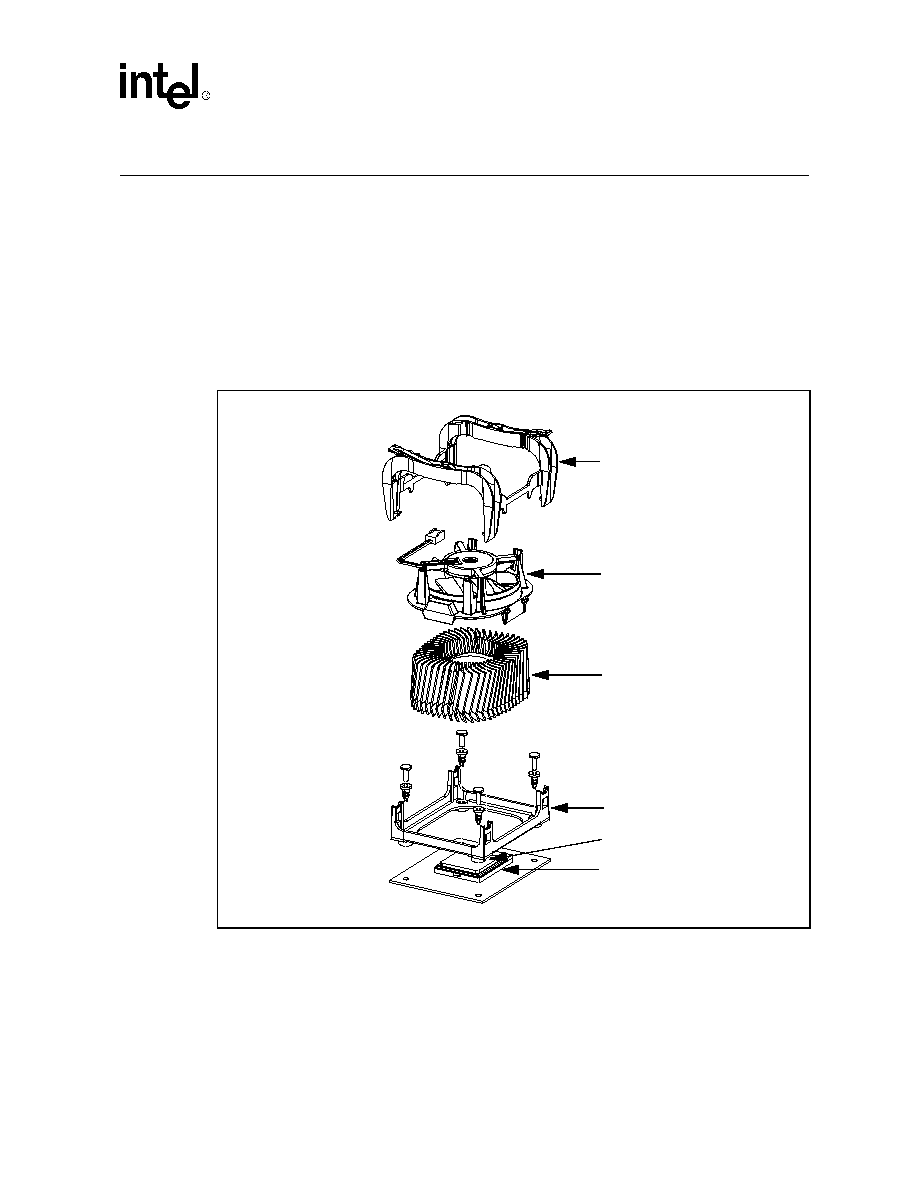
Datasheet
79
Intel
ģ
Celeron
ģ
Processor in the 478-Pin Package
6.0
Thermal Specifications and Design Considerations
The Celeron processor in the 478-pin package uses an integrated heat spreader (IHS) for heatsink
attachment that is intended to provide for multiple types of thermal solutions. This section provides
data necessary for development of a thermal solution. See
Figure 30
for an exploded view of an
example thermal solution for the Celeron processor in the 478-pin package. This is for illustration
purposes. For further thermal solution design details, refer to the
Intel
ģ
Pentium
ģ
4 Processor in the 478-pin Package Thermal Design Guidelines.
Note: The processor is either shipped by itself or with a heatsink for boxed processors. See
Chapter 8.0
for details on boxed processors.
NOTE:
This figure is not to scale.
Figure 30. Example Thermal Solution for the Intel
ģ
Celeron Processor in the 478-Pin Package
Clip Assembly
Fan/Shroud
Heatsink
Mechanism
Processor
478-pin Socket

80
Datasheet
Intel
ģ
Celeron
ģ
Processor in the 478-Pin Package
6.1
Thermal Specifications
Table 33
specifies the thermal design power dissipation envelope for the Celeron
processor in the
478-pin package. Analysis indicates that real applications are unlikely to cause the processor to
consume the maximum possible power consumption. Intel recommends that system thermal
designs target the "Thermal Design Power" indicated in
Table 33
instead of "Max Processor
Power." The Thermal Monitor feature (refer to
Section 7.3
) is designed to help protect the
processor from overheating while executing high power code that exceeds the recommendations in
this table. To ensure maximum flexibility, systems should be designed to the Flexible Motherboard
guidelines, even if a processor with a lower thermal dissipation is planned. In all cases the
Thermal Monitor feature must be enabled for the processor to be in specification.
Table 33
also lists the maximum and minimum processor temperature specifications for T
C
. A thermal
solution must be designed to ensure the temperature of the processor does not exceed these
specifications.
NOTES:
1. These values are specified at V
CC_MAX
for the processor. The processor should not be subjected to any
static V
CC
and Icc combination wherein V
CC
exceeds V
CC_MAX
for a given current.
2. The numbers in this column reflect Intel's recommended design point and are not indicative of the maximum
power the processor can dissipate under worst conditions. For more details refer to the
Intel
ģ
Pentium
ģ
4 Processor in the 478-pin Package Thermal Design Guidelines
.
Table 33. Intel
ģ
Celeron
ģ
Processor in the 478-Pin Package Thermal Design Power
Processor and
Core Frequency
(GHz)
Thermal Design
Power
2
(W)
Minimum T
C
(įC)
Maximum T
C
(įC)
Notes
1
1.70 GHz
63.5
5
76

Datasheet
81
Intel
ģ
Celeron
ģ
Processor in the 478-Pin Package
6.2
Thermal Analysis
6.2.1
Thermal Solution Performance
Refer to the Intel
ģ
Pentium
ģ
4 Processor in the 478-pin Package Thermal Design Guidelines.
6.2.2
Measurements For Thermal Specifications
6.2.2.1
Processor Case Temperature Measurement
The maximum and minimum case temperatures (T
C
) for the Celeron
processor in the 478-pin
package are specified in
Table 33
. These temperature specifications are meant to ensure correct and
reliable operation of the processor.
Figure 31
illustrates where Intel recommends T
C
thermal
measurements should be made.
Figure 31. Guideline Locations for Case Temperature (T
C
) Thermocouple Placement
Measure from edge of processor
Measure T
at this point.
C
Thermal interface material (TIM)
should cover the entire surface of
the Integrated Heat Spreader
0.689"
17.5 mm
0.689"
17.5 mm
35 mm Package

82
Datasheet
Intel
ģ
Celeron
ģ
Processor in the 478-Pin Package
This page is intentionally left blank.

Datasheet
83
Intel
ģ
Celeron
ģ
Processor in the 478-Pin Package
7.0
Features
7.1
Power-On Configuration Options
Several configuration options can be configured by hardware. The Celeron processor in the
478-pin package samples the hardware configuration at reset, on the active-to-inactive transition of
RESET#. For specifications on these options, refer to
Table 34
.
The sampled information configures the processor for subsequent operation. These configuration
options cannot be changed except by another reset. All resets reconfigure the processor; for reset
purposes, the processor does not distinguish between a warm reset and a power-on reset.
NOTES:
1. Asserting this signal during RESET# will select the corresponding option.
7.2
Clock Control and Low Power States
The use of AutoHALT, Stop-Grant, Sleep, and Deep Sleep states is allowed in the Celeron
processor in the 478-pin package based systems to reduce power consumption by stopping the
clock to internal sections of the processor, depending on each particular state. See
Figure 32
for a
visual representation of the processor low power states.
7.2.1
Normal State--State 1
This is the normal operating state for the processor.
7.2.2
AutoHALT Powerdown State--State 2
AutoHALT is a low power state entered when the processor executes the HALT instruction. The
processor will transition to the Normal state upon the occurrence of SMI#, BINIT#, INIT#, or
LINT[1:0] (NMI, INTR). RESET# will cause the processor to immediately initialize itself.
The return from a System Management Interrupt (SMI) handler can be to either Normal Mode or
the AutoHALT Power Down state. See the Intel Architecture Software Developer's Manual,
Volume III: System Programmer's Guide for more information.
Table 34. Power-On Configuration Option Pins
Configuration Option
Pin
1
Output tristate
SMI#
Execute BIST
INIT#
In Order Queue pipelining (set IOQ depth to 1)
A7#
Disable MCERR# observation
A9#
Disable BINIT# observation
A10#
APIC Cluster ID (0-3)
A[12:11]#
Disable bus parking
A15#
Symmetric agent arbitration ID
BR0#

84
Datasheet
Intel
ģ
Celeron
ģ
Processor in the 478-Pin Package
The system can generate a STPCLK# while the processor is in the AutoHALT Power Down state.
When the system deasserts the STPCLK# interrupt, the processor will return execution to the
HALT state.
While in AutoHALT Power Down state, the processor will process bus snoops.
Figure 32. Stop Clock State Machine
2. Auto HALT Power Down State
BCLK running.
Snoops and interrupts allowed.
HALT Instruction and
HALT Bus Cycle Generated
INIT#, BINIT#, INTR, NMI,
SMI#, RESET#
1. Normal State
Normal execution.
STPCLK#
Asserted
STPCLK#
De-asserted
3. Stop Grant State
BCLK running.
Snoops and interrupts allowed.
SLP#
Asserted
SLP#
De-asserted
5. Sleep State
BCLK running.
No snoops or interrupts allowed.
BCLK
Input
Stopped
BCLK
Input
Restarted
6. Deep Sleep State
BCLK stopped.
No snoops or interrupts allowed.
4. HALT/Grant Snoop State
BCLK running.
Service snoops to caches.
Snoop Event Occurs
Snoop Event Serviced
Snoop
Event
Occurs
Snoop
Event
Serviced
STPC
LK# A
sserte
d
STPC
LK# D
e-ass
erted

Datasheet
85
Intel
ģ
Celeron
ģ
Processor in the 478-Pin Package
7.2.3
Stop-Grant State--State 3
When the STPCLK# pin is asserted, the Stop-Grant state of the processor is entered 20 bus clocks
after the response phase of the processor-issued Stop Grant Acknowledge special bus cycle. Once
the STPCLK# pin has been asserted, it may only be deasserted once the processor is in the Stop
Grant state.
Since the AGTL+ signal pins receive power from the system bus, these pins should not be driven
(allowing the level to return to V
CC
) for minimum power drawn by the termination resistors in this
state. In addition, all other input pins on the system bus should be driven to the inactive state.
BINIT# will not be serviced while the processor is in Stop-Grant state. The event will be latched
and can be serviced by software upon exit from the Stop Grant state.
RESET# will cause the processor to immediately initialize itself, but the processor will stay in
Stop-Grant state. A transition back to the Normal state will occur with the de-assertion of the
STPCLK# signal. When re-entering the Stop Grant state from the Sleep state, STPCLK# should
only be de-asserted one or more bus clocks after the de-assertion of SLP#.
A transition to the HALT/Grant Snoop state will occur when the processor detects a snoop on the
system bus (see
Section 7.2.4
). A transition to the Sleep state (see
Section 7.2.5
) will occur with the
assertion of the SLP# signal.
While in the Stop-Grant State, SMI#, INIT#, BINIT# and LINT[1:0] will be latched by the
processor, and only serviced when the processor returns to the Normal State. Only one occurrence
of each event will be recognized upon return to the Normal state.
While in Stop-Grant state, the processor will process a system bus snoop.
7.2.4
HALT/Grant Snoop State--State 4
The processor will respond to snoop transactions on the system bus while in Stop-Grant state or in
AutoHALT Power Down state. During a snoop transaction, the processor enters the HALT/Grant
Snoop state. The processor will stay in this state until the snoop on the system bus has been
serviced (whether by the processor or another agent on the system bus). After the snoop is serviced,
the processor will return to the Stop-Grant state or AutoHALT Power Down state, as appropriate.

86
Datasheet
Intel
ģ
Celeron
ģ
Processor in the 478-Pin Package
7.2.5
Sleep State--State 5
The Sleep state is a very low power state in which the processor maintains its context, maintains
the phase-locked loop (PLL), and has stopped all internal clocks. The Sleep state can only be
entered from Stop-Grant state. Once in the Stop-Grant state, the processor will enter the Sleep state
upon the assertion of the SLP# signal. The SLP# pin should only be asserted when the processor is
in the Stop Grant state. SLP# assertions while the processor is not in the Stop Grant state is out of
specification and may result in unapproved operation.
Snoop events that occur while in Sleep State or during a transition into or out of Sleep state will
cause unpredictable behavior.
In the Sleep state, the processor is incapable of responding to snoop transactions or latching
interrupt signals. No transitions or assertions of signals (with the exception of SLP# or RESET#)
are allowed on the system bus while the processor is in Sleep state. Any transition on an input
signal before the processor has returned to Stop-Grant state will result in unpredictable behavior.
If RESET# is driven active while the processor is in the Sleep state, and held active as specified in
the RESET# pin specification, then the processor will reset itself, ignoring the transition through
Stop-Grant State. If RESET# is driven active while the processor is in the Sleep State, the SLP#
and STPCLK# signals should be deasserted immediately after RESET# is asserted to ensure the
processor correctly executes the Reset sequence.
While in the Sleep state, the processor is capable of entering its lowest power state, the Deep Sleep
state, by stopping the BCLK[1:0] inputs. (See
Section 7.2.6
). Once in the Sleep or Deep Sleep
states, the SLP# pin must be de-asserted if another asynchronous system bus event needs to occur.
The SLP# pin has a minimum assertion of one BCLK period.
When the processor is in Sleep state, it will not respond to interrupts or snoop transactions.
7.2.6
Deep Sleep State--State 6
Deep Sleep state is the lowest power state the processor can enter while maintaining context. Deep
Sleep state is entered by stopping the BCLK[1:0] inputs (after the Sleep state was entered from the
assertion of the SLP# pin). The processor is in Deep Sleep state immediately after BLCK[1:0] is
stopped. To provide maximum power conservation hold the BLCK0 input at V
OL
and the BCLK1
input at V
OH
during the Deep Sleep state. Stopping the BCLK input lowers the overall current
consumption to leakage levels.
To re-enter the Sleep state, the BLCK input must be restarted. A period of 1 ms (to allow for PLL
stabilization) must occur before the processor can be considered to be in the Sleep State. Once in
the Sleep state, the SLP# pin can be deasserted to re-enter the Stop-Grant state.
While in Deep Sleep state, the processor is incapable of responding to snoop transactions or
latching interrupt signals. No transitions or assertions of signals are allowed on the system bus
while the processor is in Deep Sleep state. Any transition on an input signal before the processor
has returned to Stop-Grant state will result in unpredictable behavior. The processor has to stay in
Deep Sleep mode for minimum of 25 Ķs.
When the processor is in Deep Sleep state, it will not respond to interrupts or snoop transactions.

Datasheet
87
Intel
ģ
Celeron
ģ
Processor in the 478-Pin Package
7.3
Thermal Monitor
The Thermal Monitor feature found in the Celeron
processor in the 478-pin package allows system
designers to design lower cost thermal solutions without compromising system integrity or
reliability. By using a factory-tuned, precision on-die thermal sensor, and a fast acting thermal
control circuit (TCC), the processor, without the aid of any additional software or hardware, can
keep the processor's die temperature within factory specifications under nearly all conditions.
Thermal Monitor thus allows the processor and system thermal solutions to be designed much
closer to the power envelopes of real applications, instead of being designed to the much higher
maximum processor power envelopes.
Thermal Monitor controls the processor temperature by modulating the internal processor core
clocks. The processor clocks are modulated when the TCC is activated. Thermal Monitor uses two
modes to activate the TCC: Automatic mode and On-Demand mode. Automatic mode is required
for the processor to operate within specifications and must first be enabled via BIOS. Once
automatic mode is enabled, the TCC will activate only when the internal die temperature is very
near the temperature limits of the processor. When TCC is enabled, and a high temperature
situation exists (i.e. TCC is active), the clocks will be modulated by alternately turning the clocks
off and on at a 50% duty cycle. Clocks will not be off for more than 3 Ķs when TCC is active.
Cycle times are processor speed dependent and will decrease linearly as processor core frequencies
increase. A small amount of hysteresis has been included to prevent rapid active/inactive
transitions of the TCC when the processor temperature is near the trip point. Once the temperature
has returned to a non-critical level, and the hysteresis timer has expired, modulation ceases and
TCC goes inactive. Processor performance will be decrease by ~50% when the TCC is active
(assuming a 50% duty cycle), however, with a properly designed and characterized thermal
solution the TCC most likely will only be activated briefly when the system is near maximum
temperature and during the most power intensive applications.
For automatic mode, the 50% duty cycle is factory configured and cannot be modified. Also,
automatic mode does not require any additional hardware, software drivers or interrupt handling
routines.
The TCC may also be activated via On-Demand mode. If bit 4 of the ACPI Thermal Monitor
Control Register is written to a "1" the TCC will be activated immediately, independent of the
processor temperature. When using On-Demand mode to activate the TCC, the duty cycle of the
clock modulation is programmable via bits 3:1 of the same ACPI Thermal Monitor Control
Register. In automatic mode, the duty cycle is fixed at 50% on, 50% off, however in On-Demand
mode, the duty cycle can be programmed from 12.5% on/ 87.5% off, to 87.5% on/12.5% off in
12.5% increments. On-Demand mode may be used at the same time automatic mode is enabled,
however, if the system tries to enable the TCC via On-Demand mode at the same time automatic
mode is enabled AND a high temperature condition exists, the 50% duty cycle of the automatic
mode will override the duty cycle selected by the On-Demand mode.
An external signal, PROCHOT# (processor hot) is asserted at any time the TCC is active (either in
automatic or On-Demand mode). Bus snooping and interrupt latching are also active while the
TCC is active. The temperature at which the thermal control circuit activates is not user
configurable and is not software visible.
Besides the thermal sensor and thermal control circuit, the Thermal Monitor feature also includes
one ACPI register, one performance counter register, three model specific registers (MSR), and one
I/O pin (PROCHOT#). All are available to monitor and control the state of the Thermal Monitor
feature. Thermal Monitor can be configured to generate an interrupt upon the assertion or de-
assertion of PROCHOT# (i.e., upon the activation/deactivation of TCC).
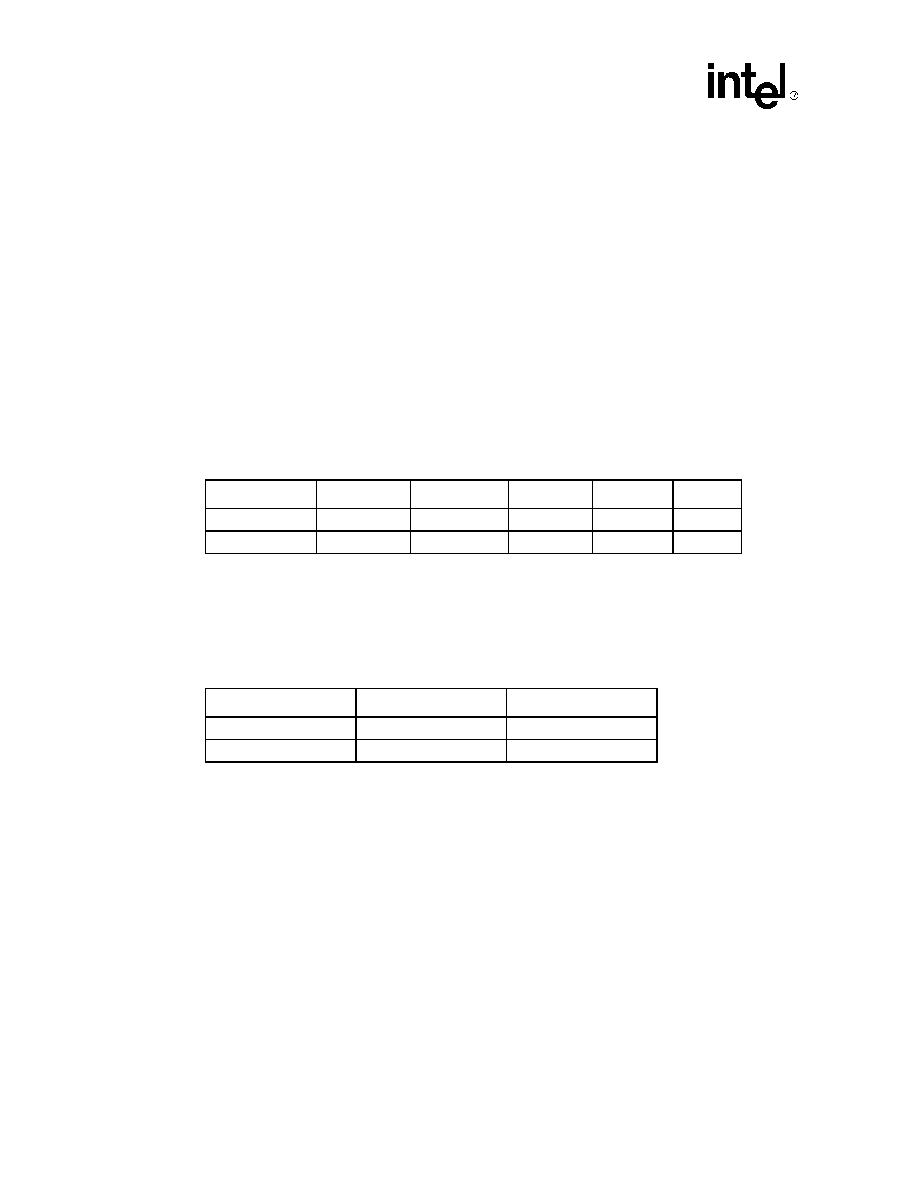
88
Datasheet
Intel
ģ
Celeron
ģ
Processor in the 478-Pin Package
If automatic mode is disabled the processor will be operating out of specification and cannot be
guaranteed to provide reliable results. Regardless of enabling of the automatic or On-Demand
modes, in the event of a catastrophic cooling failure, the processor will automatically shut down
when the silicon has reached a temperature of approximately 135 įC. At this point the system bus
signal THERMTRIP# will go active and stay active until RESET# has been initiated.
THERMTRIP# activation is independent of processor activity and does not generate any bus
cycles. If THERMTRIP# is asserted, processor core voltage (V
CC
) must be removed within the
timeframe defined in
Table 16
.
7.3.1
Thermal Diode
The Celeron
processor in the 478-pin package incorporates an on-die thermal diode. A thermal
sensor located on the system board may monitor the die temperature of the Celeron
processor in the
478-pin package for thermal management/long term die temperature change purposes.
Table 35
and
Table 36
provide the diode parameter and interface specifications. This thermal diode is
separate from the Thermal Monitor's thermal sensor and cannot be used to predict the behavior of
the Thermal Monitor.
NOTES:
1. Not 100% tested. Specified by design characterization.
2. Intel does not support or recommend operation of the thermal diode under reverse bias.
3. At room temperature with a forward bias of 630 mV.
4. n_ideality is the diode ideality factor parameter, as represented by the diode equation:
I=Io(e (Vd*q)/(nkT) ≠ 1).
Table 35. Thermal Diode Parameters
Symbol
Min
Typ
Max
Unit
Notes
1
I
forward bias
5
450
uA
2
n_ideality
0.9933
1.0045
1.0368
3, 4
Table 36. Thermal Diode Interface
Pin Name
Pin Number
Pin Description
THERMDA
B3
Diode Anode
THERMDC
C4
Diode Cathode
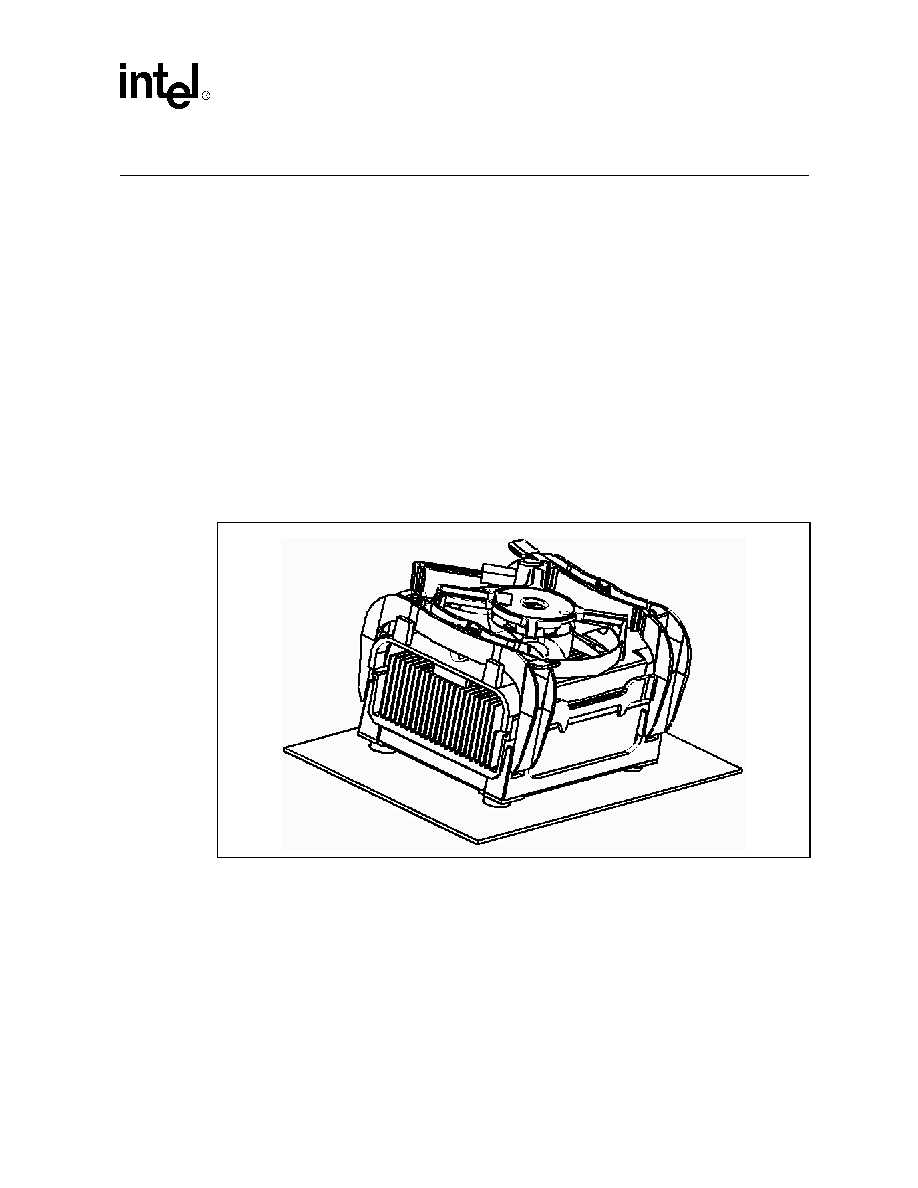
Datasheet
89
Intel
ģ
Celeron
ģ
Processor in the 478-Pin Package
8.0
Boxed Processor Specifications
The Celeron processor in the 478-pin package will also be offered as an Intel boxed processor. Intel
boxed processors are intended for system integrators who build systems from motherboards and
standard components. The boxed Celeron
processor in the 478-pin package will be supplied with a
cooling solution. This chapter documents motherboard and system requirements for the cooling
solution that will be supplied with the boxed Celeron
processor in the 478-pin package. This
chapter is particularly important for OEMs that manufacture motherboards for system integrators.
Unless otherwise noted, all figures in this chapter are dimensioned in millimeters and inches [in
brackets].
Figure 33
shows a mechanical representation of a boxed Celeron
processor in the
478-pin package.
Note: Drawings in this section reflect only the specifications on the Intel boxed processor product. These
dimensions should not be used as a generic keep-out zone for all cooling solutions. It is the system
designer's responsibility to consider their proprietary cooling solution when designing to the
required keep-out zone on their system platform and chassis. Refer to the
Intel
ģ
Pentium
ģ
4 Processor in the 478-pin Package Thermal Design Guidelines for further
guidance. Contact your local Intel Sales Representative for this document.
NOTE:
The airflow of the fan heatsink is into the center and out of the sides of the fan heatsink.
Figure 33. Mechanical Representation of the Boxed Intel
ģ
Celeron
ģ
Processor in the 478-Pin
Package

90
Datasheet
Intel
ģ
Celeron
ģ
Processor in the 478-Pin Package
8.1
Mechanical Specifications
8.1.1
Boxed Processor Cooling Solution Dimensions
This section documents the mechanical specifications of the boxed Celeron
processor in the
478-pin package. The boxed processor will be shipped with an unattached fan heatsink.
Figure 33
shows a mechanical representation of the boxed Celeron
processor in the 478-pin package.
Clearance is required around the fan heatsink to ensure unimpeded airflow for proper cooling. The
physical space requirements and dimensions for the boxed processor with assembled fan heatsink
are shown in
Figure 34
(Side Views), and
Figure 35
(Top View). The airspace requirements for the
boxed processor fan heatsink must also be incorporated into new motherboard and system designs.
Airspace requirements are shown in
Figure 38
and
Figure 39
. Note that some figures have
centerlines shown (marked with alphabetic designations) to clarify relative dimensioning.
Figure 34. Side View Space Requirements for the Boxed Processor
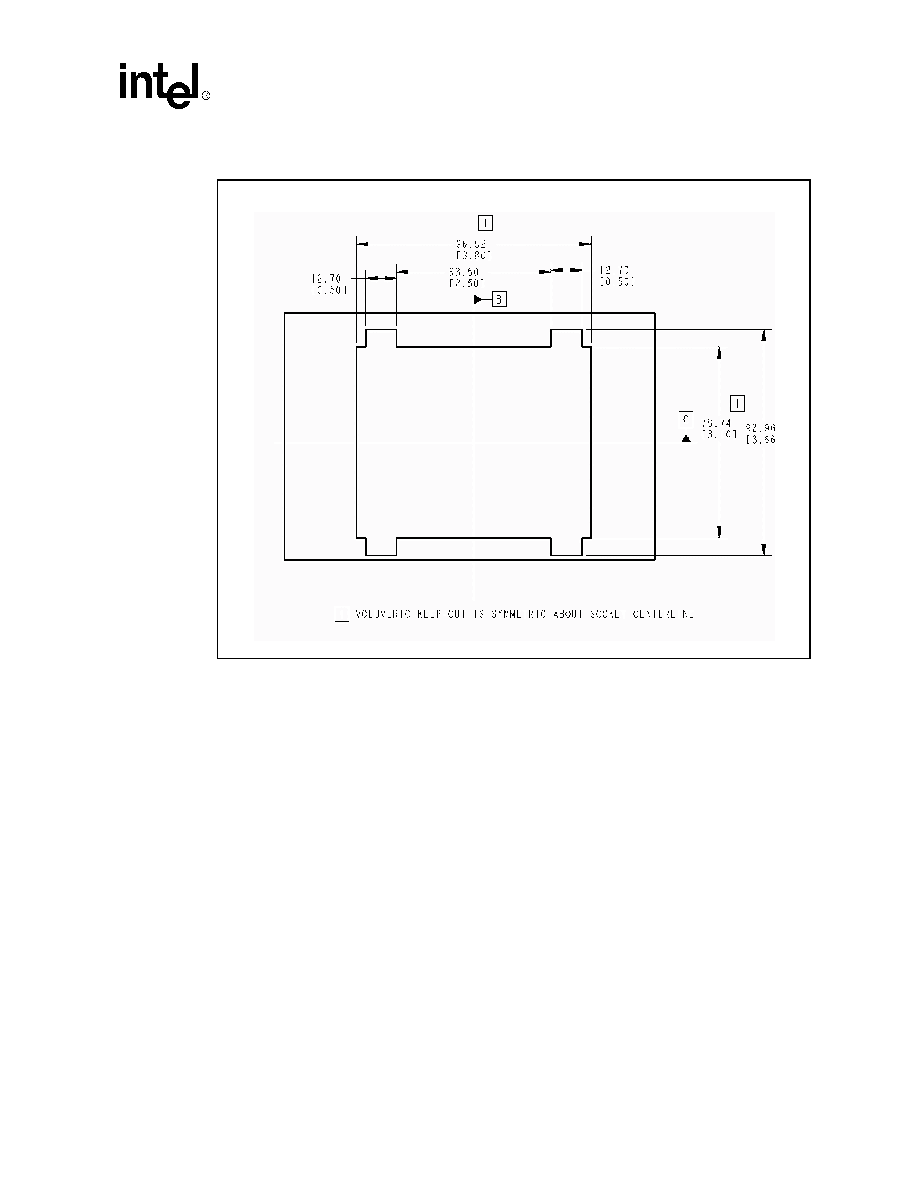
Datasheet
91
Intel
ģ
Celeron
ģ
Processor in the 478-Pin Package
8.1.2
Boxed Processor Fan Heatsink Weight
The boxed processor fan heatsink will not weigh more than 450 grams. See
Chapter 6.0
and the
Intel
ģ
Pentium
ģ
4 Processor in the 478-pin Package Thermal Design Guidelines for details on the
processor weight and heatsink requirements.
8.1.3
Boxed Processor Retention Mechanism and Heatsink Attach Clip
Assembly
The boxed processor thermal solution requires a processor retention mechanism and a heatsink
attach clip assembly, to secure the processor and fan heatsink in the baseboard socket. The boxed
processor will not ship with retention mechanisms but will ship with the heatsink attach clip
assembly. Motherboards designed for use by system integrators should include the retention
mechanism that supports the boxed Celeron
processor in the 478-pin package. Motherboard
documentation should include appropriate retention mechanism installation instructions.
Note: The processor retention mechanism based on the Intel reference design should be used, to ensure
compatibility with the heatsink attach clip assembly and the boxed processor thermal solution. The
heatsink attach clip assembly is latched to the retention tab features at each corner of the retention
mechanism.
Figure 35. Top View Space Requirements for the Boxed Processor
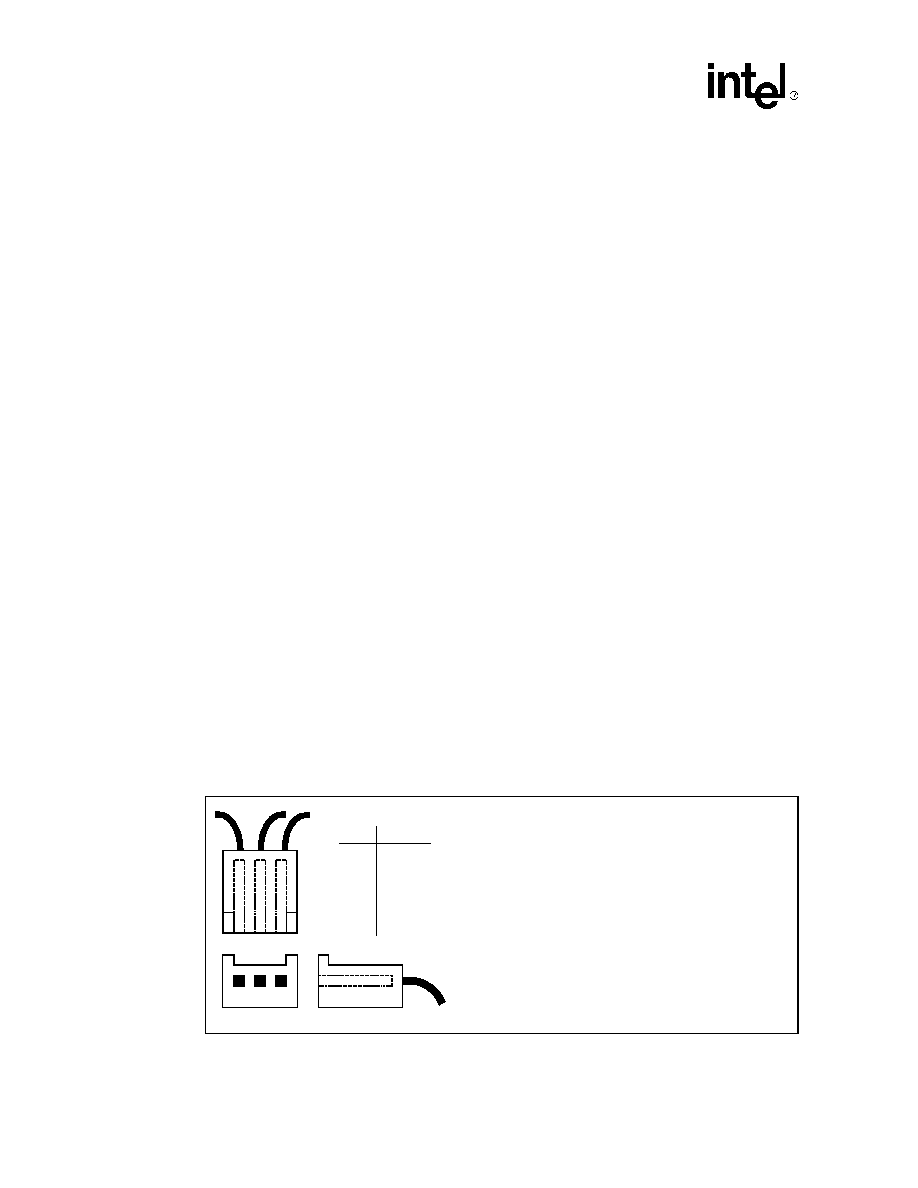
92
Datasheet
Intel
ģ
Celeron
ģ
Processor in the 478-Pin Package
The target load applied by the clips to the processor heat spreader for Intel's reference design is
75 Ī 15 lbf (maximum load is constrained by the package load capability). It is normal to observe a
bow or bend in the board due to this compressive load on the processor package and socket. The
level of bow or bend depends on the motherboard material properties and component layout. Any
additional board stiffening devices (such as plates) are not necessary and should not be used with
the reference mechanical components and boxed processor. Using such devices increases the
compressive load on the processor package and socket, likely beyond the maximum load that is
specified for those components. See the Intel
ģ
Pentium
ģ
Processor in the 478 pin Package
Thermal Design Guidelines for details on the Intel reference design.
Chassis that have adequate clearance between the motherboard and chassis wall (minimum 0.250
inch) should be selected to ensure that the board's underside bend does not contact the chassis.
8.2
Electrical Requirements
8.2.1
Fan Heatsink Power Supply
The boxed processor's fan heatsink requires a +12 V power supply. A fan power cable will be
shipped with the boxed processor to draw power from a power header on the motherboard. The
power cable connector and pinout are shown in
Figure 36
. Motherboards must provide a matched
power header to support the boxed processor.
Table 37
contains specifications for the input and
output signals at the fan heatsink connector. The fan heatsink outputs a SENSE signal, which is an
open-collector output that pulses at a rate of two pulses per fan revolution. A motherboard pull-up
resistor provides V
OH
to match the system board-mounted fan speed monitor requirements, if
applicable. Use of the SENSE signal is optional. If the SENSE signal is not used, pin 3 of the
connector should be tied to GND.
Note: The motherboard must supply a constantat +12V to the processor's power header to ensure proper
operation of the variable speed fan for the boxed processor.
The power header on the baseboard must be positioned to allow the fan heatsink power cable to
reach it. The power header identification and location should be documented in the platform
documentation, or on the system board itself.
Figure 37
shows the location of the fan power
connector relative to the processor socket. The motherboard power header should be positioned
within 4.33 inches from the center of the processor socket.
Figure 36. Boxed Processor Fan Heatsink Power Cable Connector Description
Pin
Signal
Straight square pin, 3-pin terminal housing with
polarizing ribs and friction locking ramp.
0.100" pin pitch, 0.025" square pin width.
Waldom/Molex P/N 22-01-3037 or equivalent.
Match with straight pin, friction lock header on motherboard
Waldom/Molex P/N 22-23-2031, AMP P/N 640456-3,
or equivalent.
1
2
3
GND
+12 V
SENSE
1
2
3
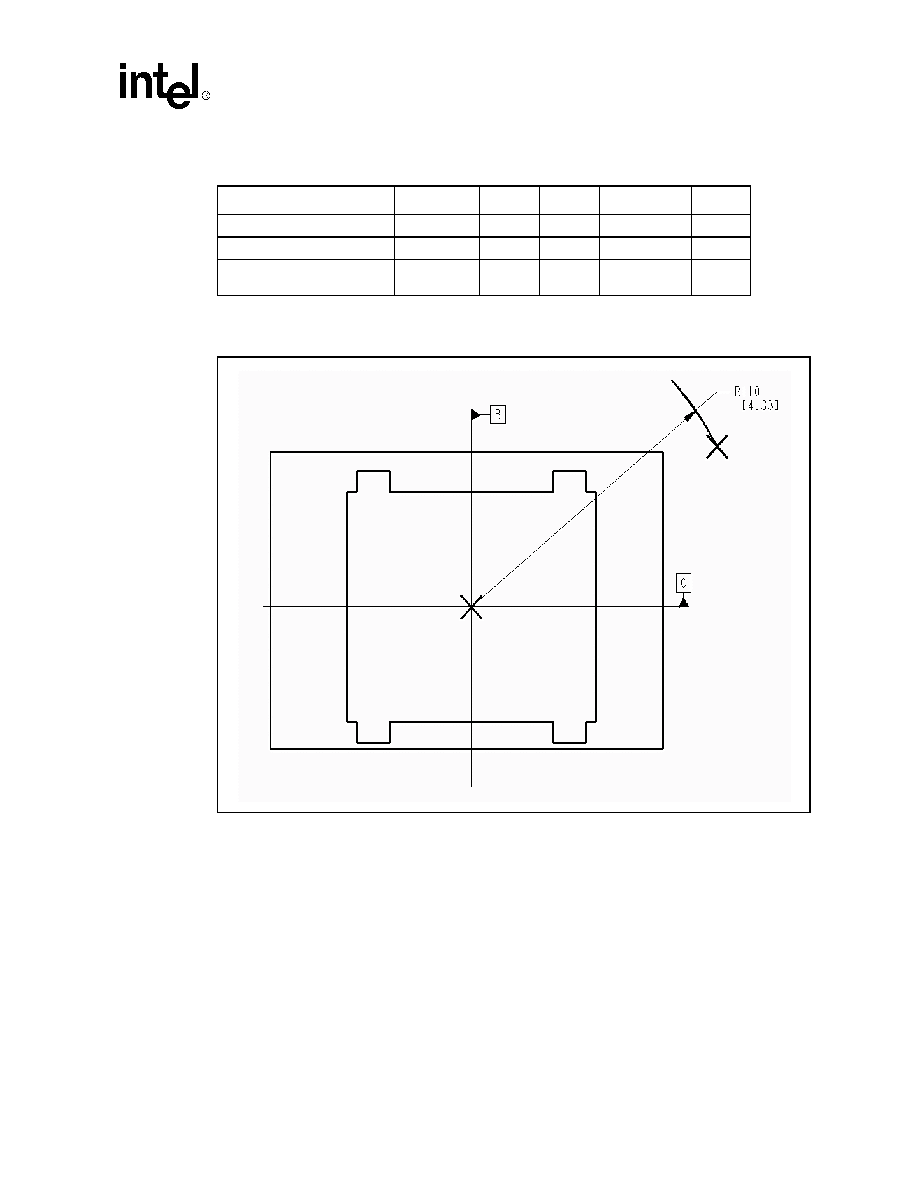
Datasheet
93
Intel
ģ
Celeron
ģ
Processor in the 478-Pin Package
NOTE:
Motherboard should pull this pin up to V
CC
with a resistor.
Table 37. Fan Heatsink Power and Signal Specifications
Description
Min
Typ
Max
Unit
Notes
+12 V: 12 volt fan power supply
10.2
12
13.8
V
IC: Fan current draw
740
mA
SENSE: SENSE frequency
2
pulses per fan
revolution
see note
Figure 37. Motherboard Power Header Placement Relative to Processor Socket
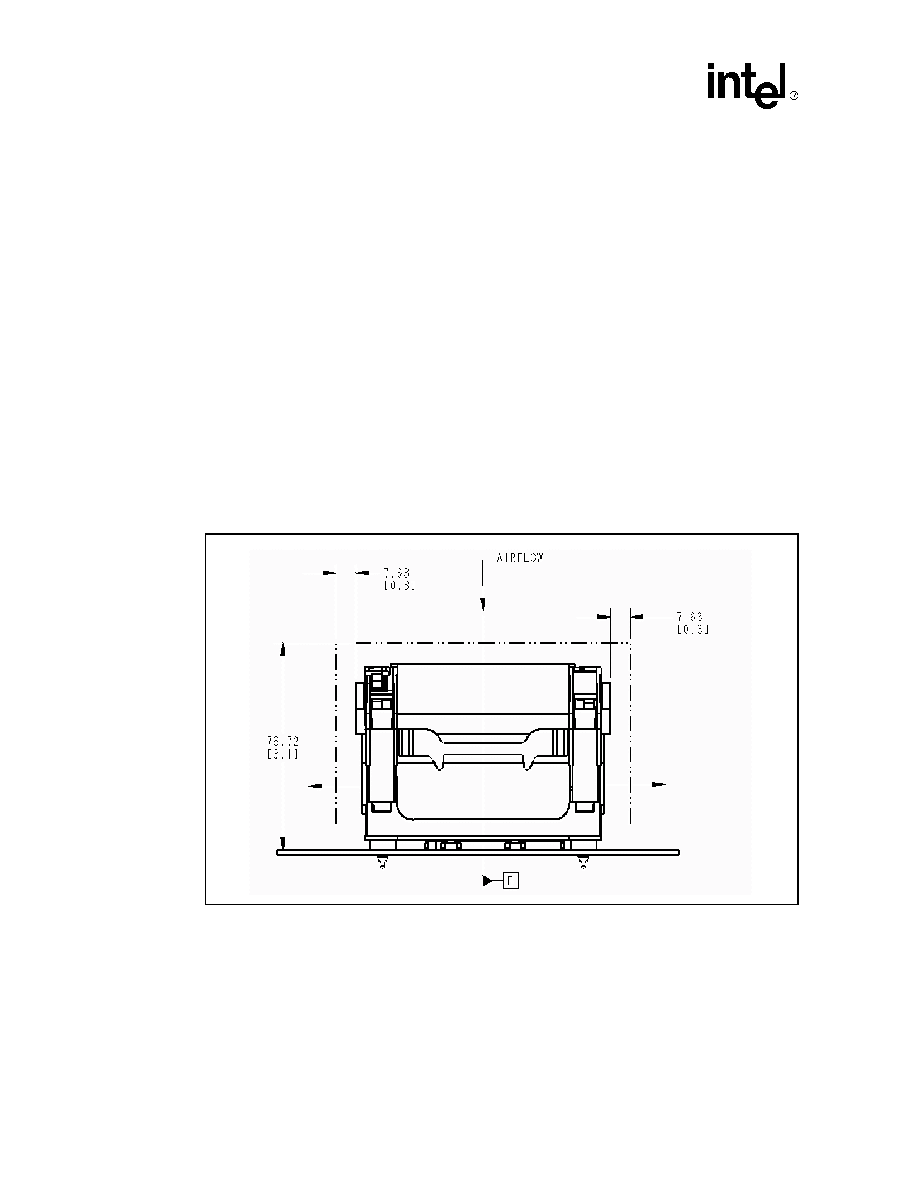
94
Datasheet
Intel
ģ
Celeron
ģ
Processor in the 478-Pin Package
8.3
Thermal Specifications
This section describes the cooling requirements of the fan heatsink solution utilized by the boxed
processor.
8.3.1
Boxed Processor Cooling Requirements
The boxed processor may be directly cooled with a fan heatsink. However, meeting the processor's
temperature specification is also function of the thermal design of the entire system, and ultimately
the responsibility of the system integrator. The processor temperature specification is found in
Chapter 6.0
. The boxed processor fan heatsink is able to keep the processor temperature within the
specifications (see
Table 33
) in chassis that provide good thermal management. For the boxed
processor fan heatsink to operate properly, it is critical that the airflow provided to the fan heatsink
is unimpeded. Airflow of the fan heatsink is into the center and out of the sides of the fan heatsink.
Airspace is required around the fan to ensure that the airflow through the fan heatsink is not
blocked. Blocking the airflow to the fan heatsink reduces the cooling efficiency and decreases fan
life.
Figure 38
and
Figure 39
illustrate an acceptable airspace clearance for the fan heatsink. The air
temperature entering the fan should be kept below 40į C. Again, meeting the processor's
temperature specification is the responsibility of the system integrator.
Figure 38. Boxed Processor Fan Heatsink Airspace Keepout Requirements
(Side 1 View)
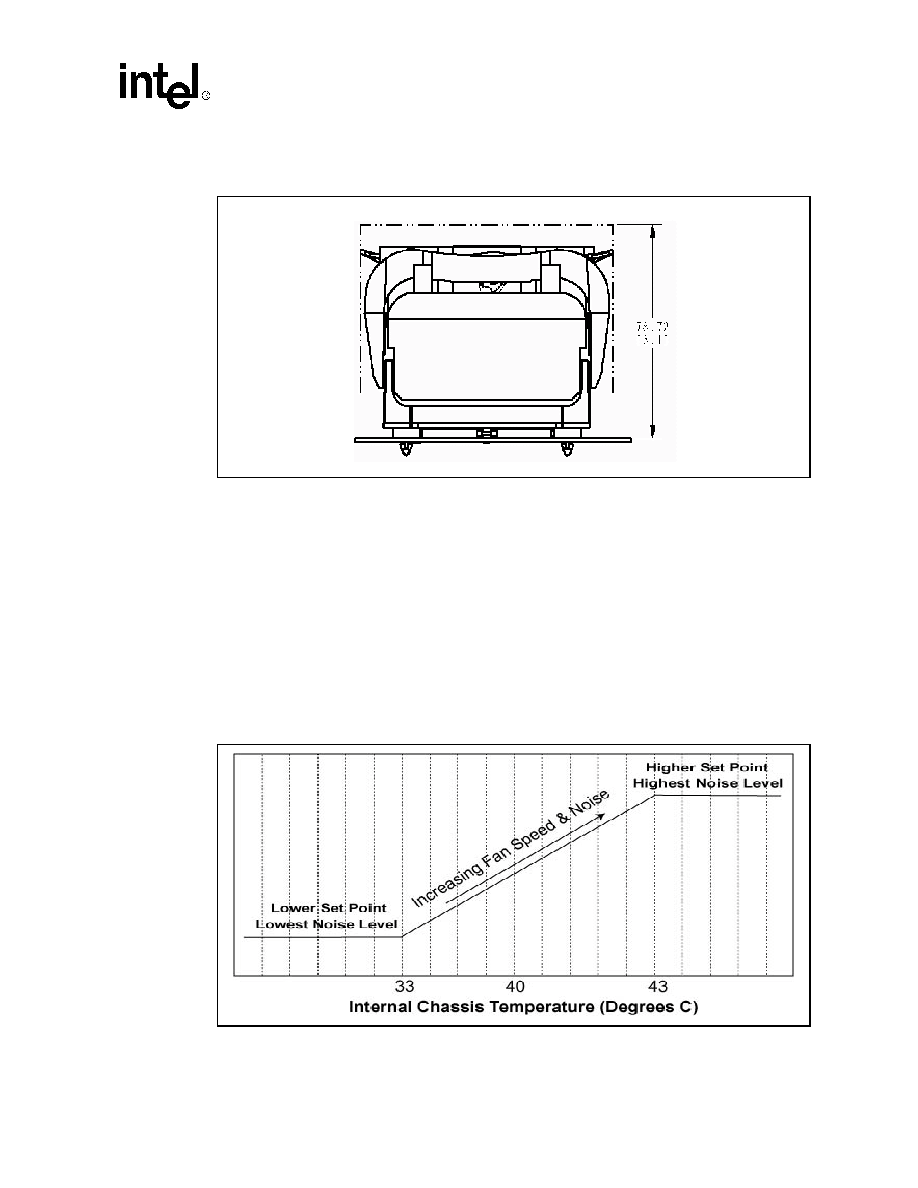
Datasheet
95
Intel
ģ
Celeron
ģ
Processor in the 478-Pin Package
8.3.2
Variable Speed Fan
The boxed processor fan will operate at different speeds over a short range of internal chassis
temperatures. This allows the processor fan to operate at a lower speed and noise level, while
internal chassis temperatures are low. If internal chassis temperature increases beyond a lower set
point, the fan speed will rise linearly with the internal temperature until the higher set point is
reached. At that point, the fan speed is at its maximum. As fan speed increases, so does fan noise
levels. Systems should be designed to provide adequate air around the boxed processor fan
heatsink that remains below the lower set point. These set points, represented in
Figure 40
and
Table 38
, can vary by a few degrees from fan heatsink to fan heatsink. The internal chassis
temperature should be kept below 40ļC. Meeting the processor's temperature specification (see
Chapter 6.0
) is the responsibility of the system integrator.
Figure 39. Boxed Processor Fan Heatsink Airspace Keepout Requirements
(Side 2 View)
Figure 40. Boxed Processor Fan Heatsink Set Points

96
Datasheet
Intel
ģ
Celeron
ģ
Processor in the 478-Pin Package
NOTE:
1. Set point variance is approximately Ī 1įC from fan heatsink to fan heatsink
Table 38. Boxed Processor Fan Heatsink Set Points
Boxed Processor Fan
Heatsink Set Point (ļC)
Boxed Processor Fan Speed
Notes
33
When the internal chassis temperature is below or equal to this
set point, the fan operates at its lowest speed. Recommended
maximum internal chassis temperature for nominal operating
environment.
1
40
When the internal chassis temperature is at this point, the fan
operates between its lowest and highest speeds. Recommended
maximum internal chassis temperature for worst-case operating
environment.
43
When the internal chassis temperature is above or equal to this
set point, the fan operates at its highest speed.
1

Datasheet
97
Intel
ģ
Celeron
ģ
Processor in the 478-Pin Package
9.0
Debug Tools Specifications
Refer to the ITP700 Debug Port Design Guide and the appropriate Platform Design Guide for
information regarding debug tools specifications.
9.1
Logic Analyzer Interface (LAI)
Intel is working with two logic analyzer vendors to provide logic analyzer interfaces (LAIs) for use
in debugging Celeron
processor in the 478-pin package systems. Tektronix* and Agilent* should
be contacted to get specific information about their logic analyzer interfaces. The following
information is general. Specific information must be obtained from the logic analyzer vendor.
Due to the complexity of Celeron
processor in the 478-pin package systems, the LAI is critical in
providing the ability to probe and capture system bus signals. There are two sets of considerations
to keep in mind when designing a Celeron
processor in the 478-pin package system that can make
use of an LAI: mechanical and electrical.
9.1.1
Mechanical Considerations
The LAI is installed between the processor socket and the Celeron
processor in the 478-pin
package. The LAI pins plug into the socket, while the Celeron
processor in the 478-pin package
pins plug into a socket on the LAI. Cabling that is part of the LAI egresses the system to allow an
electrical connection between the Celeron
processor in the 478-pin package and a logic analyzer.
The maximum volume occupied by the LAI, known as the keepout volume, as well as the cable
egress restrictions, should be obtained from the logic analyzer vendor. System designers must
make sure that the keepout volume remains unobstructed inside the system. Note that it is possible
that the keepout volume reserved for the LAI may differ from the space normally occupied by the
Celeron
processor in the 478-pin package heatsink. If this is the case, the logic analyzer vendor will
provide a cooling solution as part of the LAI.
9.1.2
Electrical Considerations
The LAI will also affect the electrical performance of the system bus; therefore, it is critical to
obtain electrical load models from each of the logic analyzers to be able to run system level
simulations to prove that their tool will work in the system. Contact the logic analyzer vendor for
electrical specifications and load models for the LAI solution they provide.

98
Datasheet
Intel
ģ
Celeron
ģ
Processor in the 478-Pin Package

































































































